Navigation
This post covers Citrix Workspace Environment Management (WEM) versions 2411 and older.
- Change Log
- Overview
- WEM Infrastructure Install/Upgrade:
- WEM Configuration Sets
- Import Recommended Settings
- WEM Administrators
- WEM Agents:
- WEM Actions Configuration:
- Transformer
💡 = Recently Updated
Change Log
- 2024 Dec 4 – Group Policy Migration Tool
- 2024 Dec 4 – Updated Install sections for version 2411
- 2023 Sept 16 – updated entire article for WEM Web Console
- 2308 Transformer can detect Workspace app
- 2023 June 2 – Group Managed Service Account at Citrix Docs
- 2023 May 30 – added link to CTP James Kindon WEM Advanced Guidance – 2023 at CUGC
Overview
Workspace Environment Management (WEM) is Citrix’s Performance Management and UEM (User Environment Management) tool for all XenApp/XenDesktop Enterprise or Platinum Customers with active Software Maintenance (Subscription Advantage is not sufficient). The WEM Agent is supported on XenApp 6.5, and XenApp/XenDesktop 7.x. Videos:
- Hal Lange demonstrates Citrix WEM Performance Optimizations in a YouTube video
- YouTube video XenTegra Citrix Workspace Environment Management (WEM) Webinar
- CUGC Welcome to Citrix Workspace Environment Management (WEM) – Hal Lange, CTP Steve Greenberg, CTP Carl Webster
Note: WEM does not replace Citrix Profile Management. You usually implement both.
Citrix Blog Post User Experience on Steroids: Citrix Workspace Environment Management has a list of Frequently Asked Questions about WEM, including a drawing of the architecture.
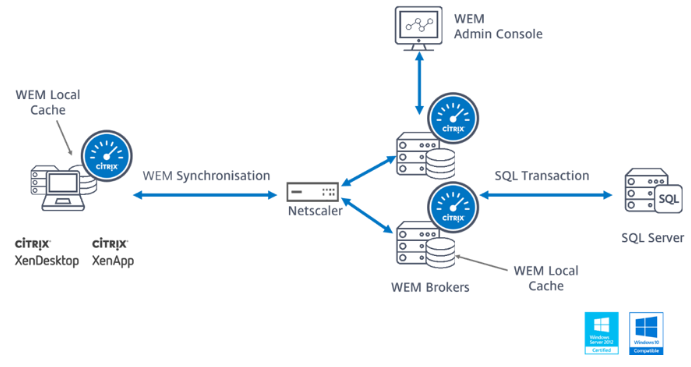
From Hal Lange at Database sizing at Citrix Discussions: SQL Always On is fully supported. In WEM 1909 and older, the ONE caveat is to remove from the Always On Availability Group before upgrading.
Here are the official calculations from the Norskale days on space needed on the SQL Server:
- Reserve 1GB of RAM per 1,000 users deployed
- RAM=1.5GB system + (1.5GB SQL + 1 GB per 1,000 users) for that SQL instance
- Disk = 1GB per 10,000 users per year + 10 MB per WEM site configured
Upgrade WEM
There is no LTSR version of Citrix Workspace Environment Management (WEM), so you should always upgrade to the latest version of WEM.
From Upgrade a deployment at Citrix Docs: In-place upgrades from versions earlier than Workspace Environment Management 4.7 to version 1808 or later are not supported. To upgrade from any of those earlier versions, you need to upgrade to version 4.7 first and then upgrade to the target version.
If you want to upgrade a WEM deployment earlier than 2006 to 2209 or later: To avoid database upgrade failures, upgrade to 2103 first and then to 2209 or later.
CTA Marco Hofmann at CUGC: How-To: Update Citrix Workspace Environment Management (WEM) from 4.x to 4.7 (v4.07.00.00)
To upgrade Citrix WEM:
- In-place upgrade the Citrix Licensing Server. No special instructions.
- Ensure the installed licenses a non-expired Subscription Advantage date.
- Before you upgrade, run WEM Infrastructure Service Configuration Utility and record all settings.
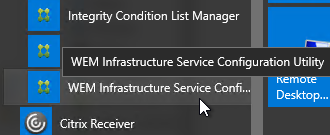
- In-place upgrade the WEM Server. No special instructions.
- Use the Database Maintenance tool to upgrade the WEM database.
- In WEM 1909 and older, before upgrading the database that’s in a SQL Server Always On availability group, you must remove it from the availability group. This is no longer required in WEM 1912 and newer.
- You might have to run the WEM Infrastructure Service Configuration Utility on each WEM Server to point to the upgraded database. If the settings are still there, then just click Save Configuration.
- In-place upgrade the WEM Console. No special instructions.
- In-place upgrade the WEM Agents.
- Srinivasan Shanmugam at WEM Agent v4.5 Upgrade Issues at CUGC mentioned that you might have to delete Agent’s local database.
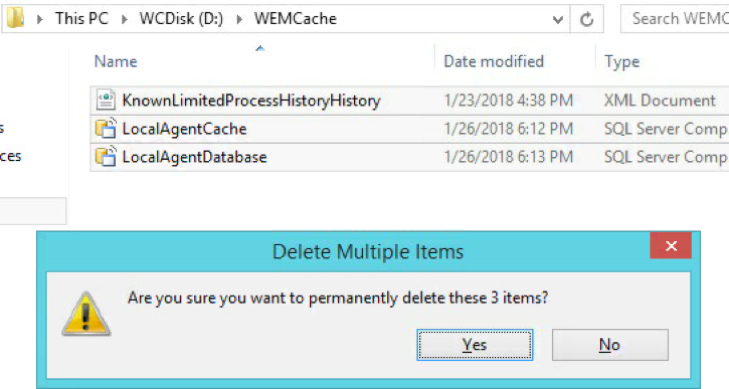
- Srinivasan Shanmugam at WEM Agent v4.5 Upgrade Issues at CUGC mentioned that you might have to delete Agent’s local database.
Install/Upgrade WEM Server (Infrastructure Service)
There is no LTSR version of Citrix Workspace Environment Management (WEM), so you should always upgrade to the latest version of WEM.
The WEM Infrastructure Service can be installed on one or more servers, but Citrix says don’t install it on Delivery Controllers. The WEM Agent cannot be installed on the Infrastructure Service server.
- Another option: CTP James Kindon explains how to install WEM Server on Windows Server Core

A WEM Server with 4 vCPU and 8 GB RAM can support up to 3,000 users.
- Port 8288 – WEM 1912 and newer have a new port 8288 for WEM Agent Cache Synchronization. You’ll need to add this port to your load balancer and open it in your firewall.
- Port 8285 is still available for WEM Agents 2012 and older connecting to newer WEM Servers.
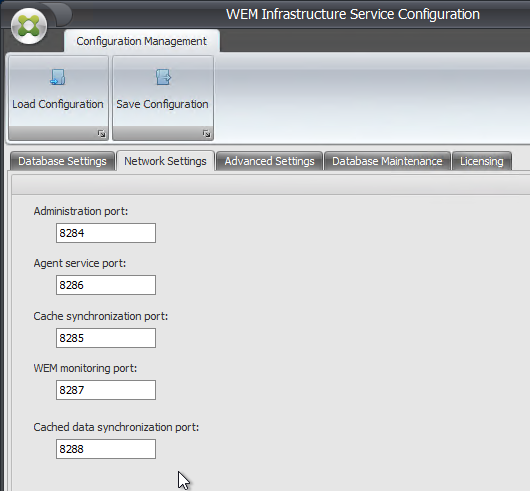
- Old port removed – The Cache synchronization port (8285) was removed from WEM Server 2103 and newer, so make sure your existing agents are a version that supports the newer Cached data synchronization port. WEM Agent 1912 and newer should be sufficient.
- If your existing WEM Agents don’t support the new port number, then upgrade your WEM Server to version 2012 (or version 1912), upgrade your WEM Agents to the corresponding version, and then upgrade the WEM Server to a newer version.
- Port 8285 is still available for WEM Agents 2012 and older connecting to newer WEM Servers.
- Download Workspace Environment Management 2411 and extract it.

- If you are upgrading, run WEM Infrastructure Service Configuration Utility and record all settings. These settings might be wiped out during the upgrade.

- Licenses – make sure your installed CVAD licenses have a CSS date that is later than the date required by your WEM version. The required CSS date is shown at the top of the WEM download page.

- Run the downloaded Citrix Workspace Environment Management Infrastructure Services Setup.exe from the 2411-01-100-01 folder.

- Check the box next to I agree to the license terms and click Install.

- In the Welcome to the Citrix Workspace Environment Management Infrastructure Services Setup Wizard page, click Next.

- In the Destination Folder page, click Next.

- In the Ready to install Citrix Workspace Environment Management Infrastructure Services page, click Install.

- In the Completed the Citrix Workspace Environment Management Infrastructure Services Setup Wizard page, click Finish.
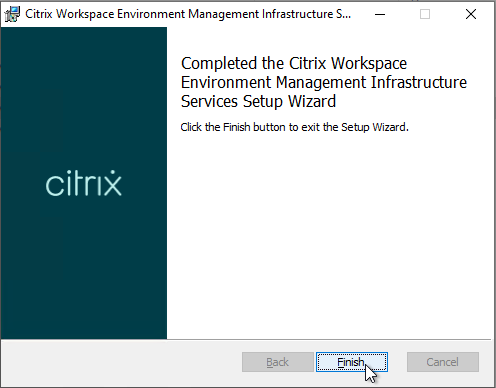
- Click Launch Database Management Utility.
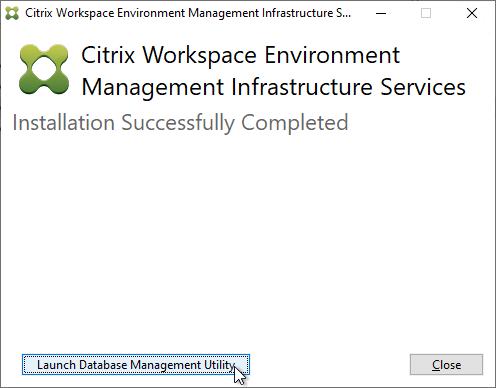
- Antivirus – C:\Program Files (x86)\Citrix\Workspace Environment Management Infrastructure Services and C:\Program Files (x86)\Norskale\Norskale Infrastructure Services must be excluded from Antivirus scanning. Or exclude: Norskale Broker Service.exe; Norskale Broker Service Configuration Utility.exe; Norskale Database Management Utility.exe.
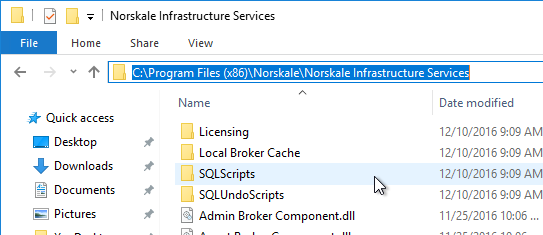
- If you are upgrading, then make sure your WEM Service Account has Full control permissions on the DBSync folder at C:\Program Files (x86)\Norskale\Norskale Infrastructure Services\DBSync. For new installs, WEM should set this permission correctly once the Infrastructure Services are configured. Note: this folder seems to be missing in newer versions of WEM.
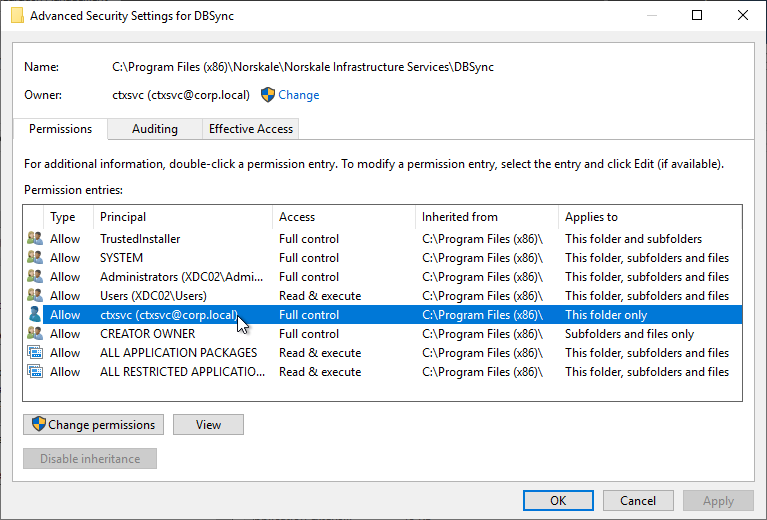
- Firewall – Ensure firewall allows the following ports to/from the WEM Infrastructure Service servers. See Citrix Tech Zone Communication Ports Used by Citrix Technologies.
- Agent Port – defaults to TCP 8286 – from WEM Agent to WEM Infrastructure Service
- AgentSyncPort – defaults to TCP 8285 – from WEM Agent to WEM Infrastructure Service
- Cached data synchronization port – defaults to TCP 8288 – from WEM Agent 1912 and newer to WEM Infrastructure Service
- AdminPort – defaults to TCP 8284 – from WEM Admin Console to WEM Infrastructure Service
- Monitoring Port – defaults to TCP 8287 – from Director to WEM Infrastructure Service
- AgentPort – defaults to TCP 49752 – from WEM Infrastructure Service to WEM Agent
Upgrade WEM Database
Workspace Environment Management has PowerShell commands. For details, see Citrix Workspace Environment Management SDK at Citrix Developer docs.
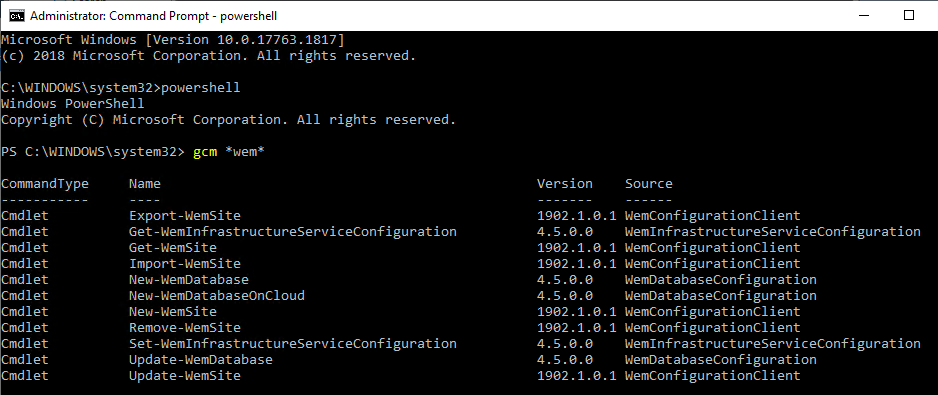
To upgrade the Workspace Environment Management database using the GUI tool:
- If this is a new install, skip to Create WEM Database.
- The person running Database Management must be a sysadmin on the SQL Server. Or you can enter a SQL login.
- On the WEM server, run Database Management from the Start Menu.

- If upgrading, in the ribbon, click Upgrade Database.
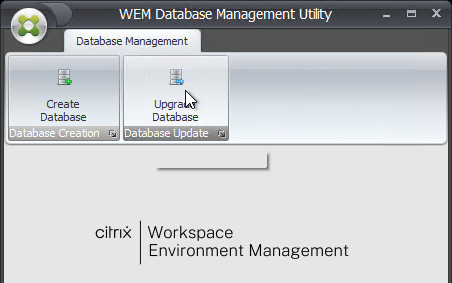
- In WEM 1906 and newer, the fields might already be filled in. Otherwise:
- Enter the SQL Server Name.
- Enter the existing WEM Database Name.
- Configure the credentials for the WEM service account.
- If your account is not a sysadmin on SQL, then enter a SQL account in the Database Credentials fields.
- Click Upgrade.
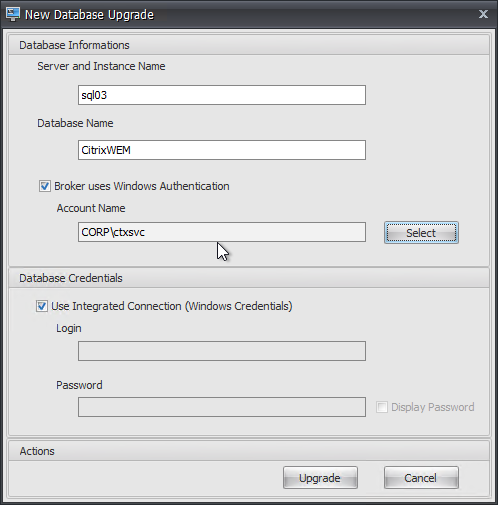
- Click Yes when asked to proceed.

- Click OK when prompted that database upgraded successfully.

- Click Finish to close the Database Upgrade Wizard.

- Close the WEM Database Management Utility.

- Open services.msc and restart the Citrix WEM Infrastructure Service or restart Norskale Infrastructure Service.
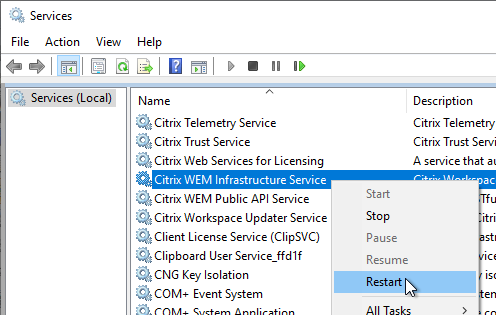
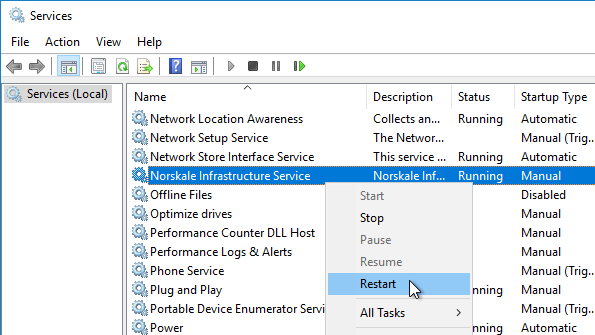
After the database is upgraded, run the WEM Infrastructure Service Configuration Utility.

- If the upgrade preserved the settings, then simply click Save Configuration. The service won’t start unless you do this.
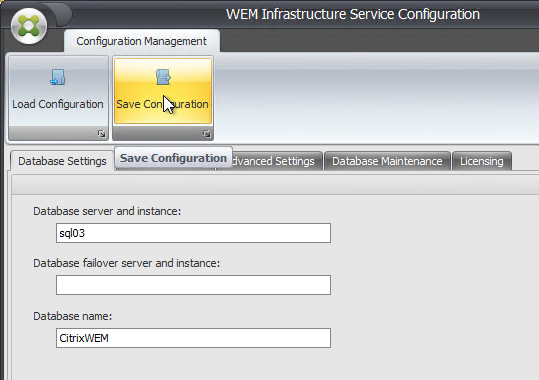
- In WEM older than version 1906, you might have to re-configure the settings.
- On the Licensing tab, configure the licensing server.
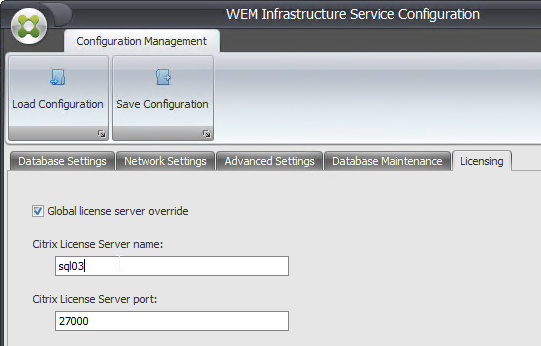
- On the Database Maintenance tab, consider checking Enable Scheduled Database Maintenance.
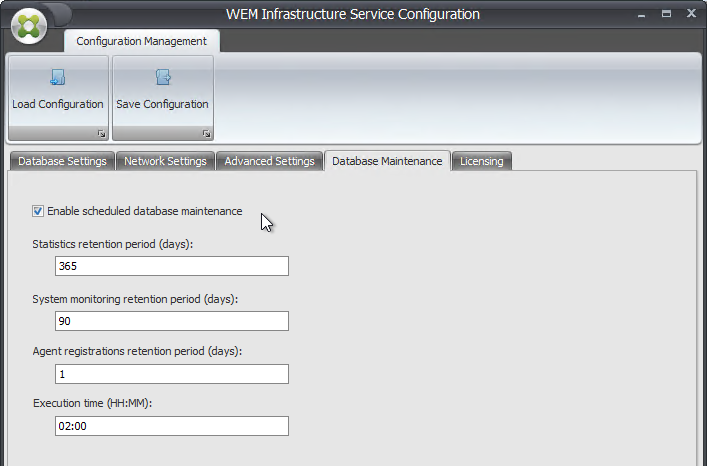
- On the Advanced Settings tab:
- Enter the Infrastructure service account credentials.
- Enter the vuemUser SQL user account password.
- In WEM 1909 and newer, check the box next to Enable performance tuning and set both of the Minimum threads boxes to the number of concurrent WEM Agents that will be connected to this one WEM server. Maximum value is 3000.
- Make a choice regarding Google Analytics.
- The Advanced Settings tab will look something like this.
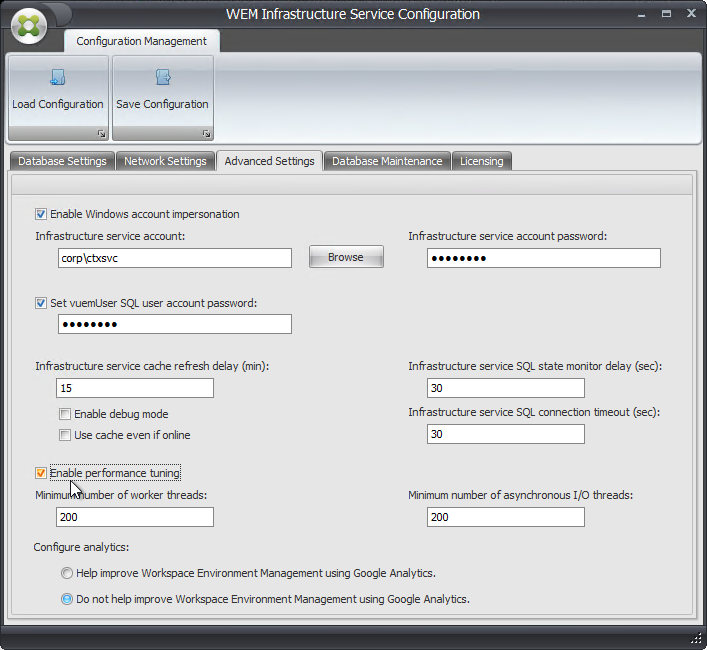
- On the Database Settings tab, enter the database server name and database name.
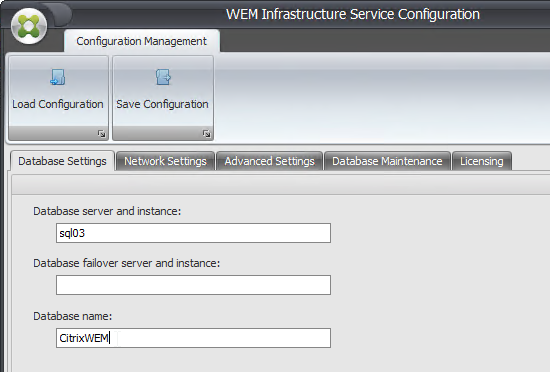
- In the ribbon, click Save Configuration.
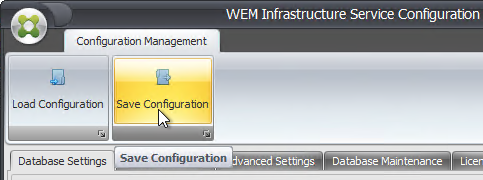
- On the Licensing tab, configure the licensing server.
- Click Yes to restart the Broker Service.

- Skip ahead to upgrade the WEM Administration Console.
Create WEM Database
Workspace Environment Management has PowerShell commands. For details, see Citrix Workspace Environment Management SDK at Citrix Developer docs.

To create the database using the GUI tool:
- The person running Database Management must be a sysadmin on the SQL Server. Or you can enter a SQL login.
- Make sure SQL Server authentication (mixed mode) is enabled on the SQL server > Properties > Security. Even though the WEM Infrastructure Service server runs as an AD account that is used login to SQL, WEM Infrastructure Service also uses a SQL account named vuemUser, which means mixed mode must be enabled. Source = John Long at WEM new install, cannot connect to infrastructure server at Citrix Discussions.
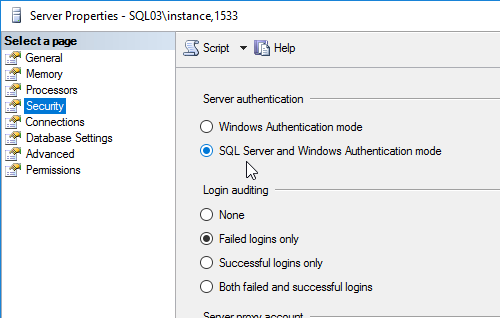
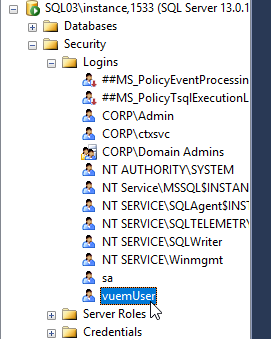
- On the WEM server, run WEM Database Management Utility from the Start Menu.
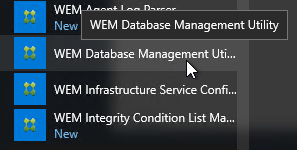
- If a new install, in the ribbon, click Create Database.
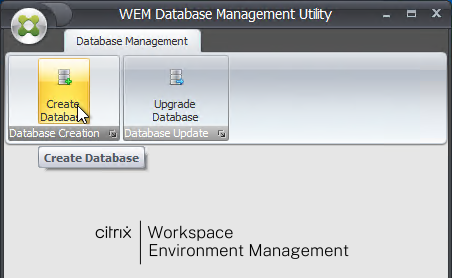
- In the Create database Wizard page, click Next.
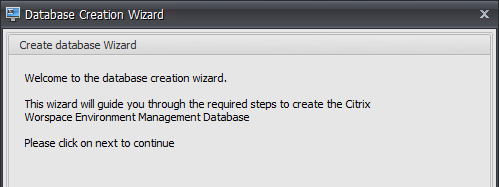
- In the Database Information page, enter the SQL server name, and enter a new Database Name.
- Only enter an instance name if you have a named SQL instance.
- Only enter a port number if your SQL instance is listening on a static port number other than 1433.
- From Måns Hurtigh at Problem creating WEM 4.3 Database on SQL Server 2012 at Citrix Discussions: The database name cannot contain a dash.
- The paths might not be correct so double check them. Then click Next.
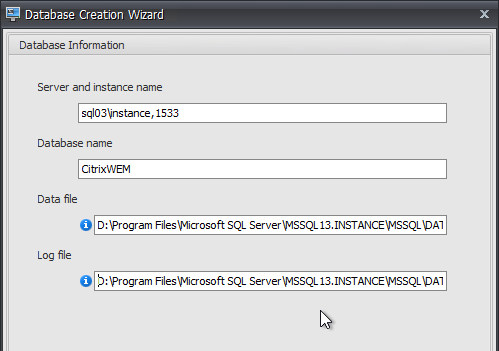
- In the Database Server Credentials page, if your account has sysadmin permissions, then leave the box checked. Otherwise, uncheck the box, and enter a SQL login that has sysadmin permissions. Click Next.
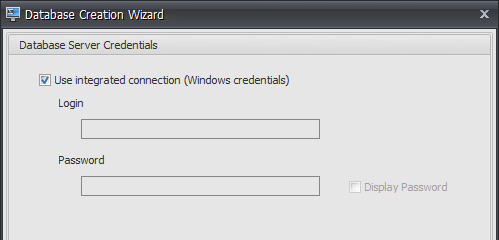
- In the VUEM Administrators section, click Browse, and select your Citrix Admins group.
- In the Database Security page, if you intend to load balance multiple WEM servers, then specify a Windows service account for database access. The WEM Infrastructure Service will run as this account. See the load balancing topic at Install the Citrix Workspace Environment Management Infrastructure Services at Citrix Docs.
- WEM 2305 and newer support group Managed Service Account (gMSA). See Group Managed Service Account at Citrix Docs.
- The Database Creation Wizard also creates a SQL account called vuemUser with an 8 character alphanumeric password. If you want it more complex, check the box and specify the password.
- Note: if you intend to implement AlwaysOn Availability Group, then you must specify this password, since you’ll be asked for it again when adding the database to the Availability Group. Also see SQL Server Always On at Citrix Docs.
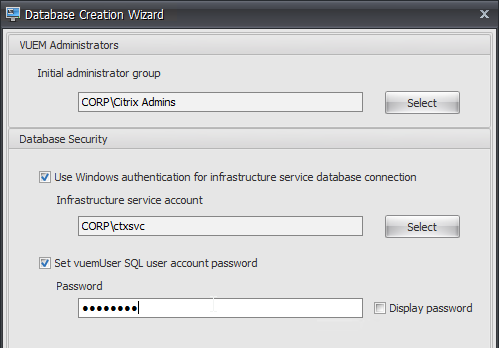
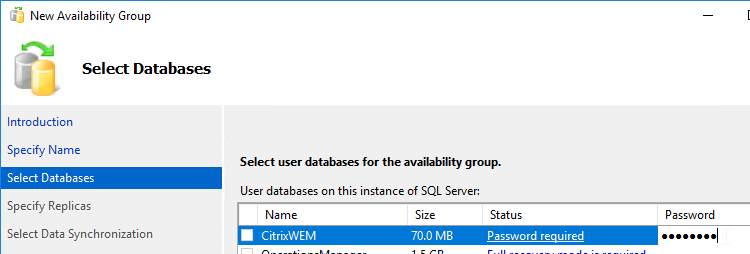
- Note: if you intend to implement AlwaysOn Availability Group, then you must specify this password, since you’ll be asked for it again when adding the database to the Availability Group. Also see SQL Server Always On at Citrix Docs.
- Click Next.
- In the Database Information Summary page, click Create Database.
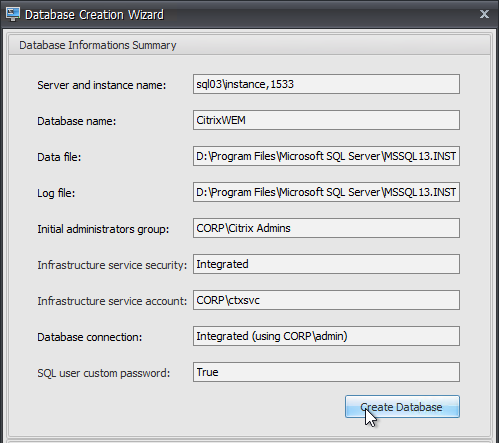
- Click OK when prompted that the database was created successfully.
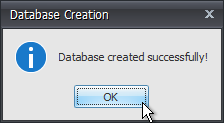
- Click Finish to close the Database Creation Wizard.

- Close the WEM Database Management Utility.
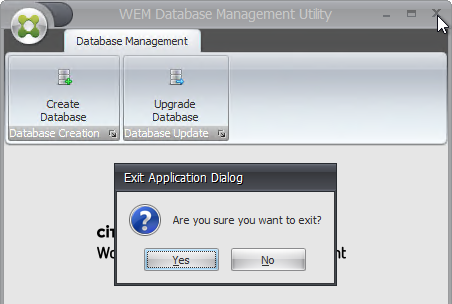
- There is a log file at “C:\Program Files (x86)\Citrix\Workspace Environment Management Infrastructure Services\Citrix WEM Database Management Utility Debug Log.log” or at “C:\Program Files (x86)\Norskale\Norskale Infrastructure Services\Citrix WEM Database Management Utility Debug Log.log”


WEM Infrastructure Services Configuration
- On the WEM Server, run WEM Infrastructure Service Configuration Utility from the Start Menu.
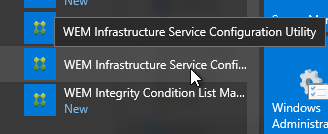
- On the Database Settings tab, enter the SQL Server name and database name.
- Switch to the Advanced Settings tab.
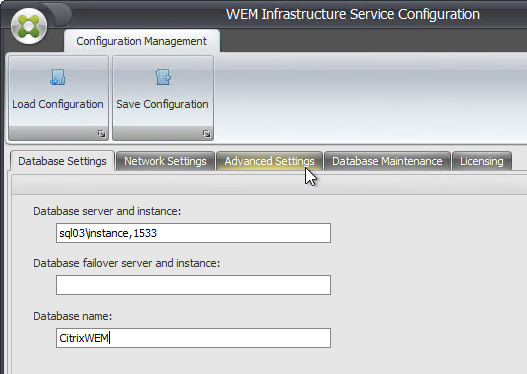
- If you intend to load balance WEM Servers, then Browse to a service account. This service account must have access to the database.
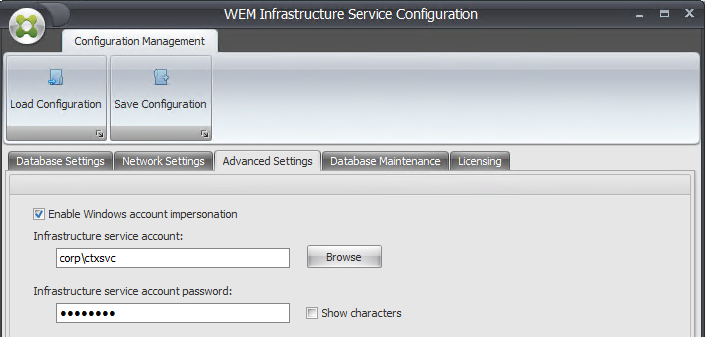
- The service account must be in the local Administrators group on the WEM servers.
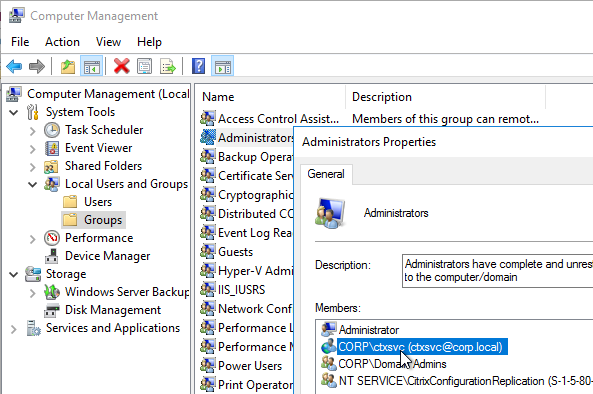
- The service account must be in the local Administrators group on the WEM servers.
- Enter the vuemUser SQL user account password.
- In WEM 1909 and newer, check the box next to Enable performance tuning and set both of the Minimum threads boxes to the number of concurrent WEM Agents that will be connected to this one WEM server. Maximum value is 3000.
- Make a choice regarding Google Analytics.
- The Advanced Settings tab will look something like this.
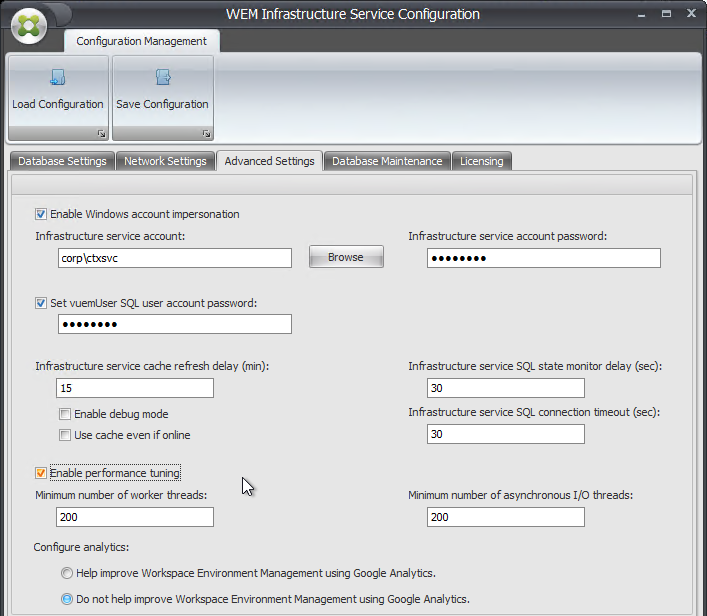
- On the Database Maintenance tab, consider checking Enable Scheduled Database Maintenance.

- On the Licensing tab, you can enter a Citrix License Server 11.14.0.1 or newer that has valid licenses. Or you can enter the license server later in the admin console.
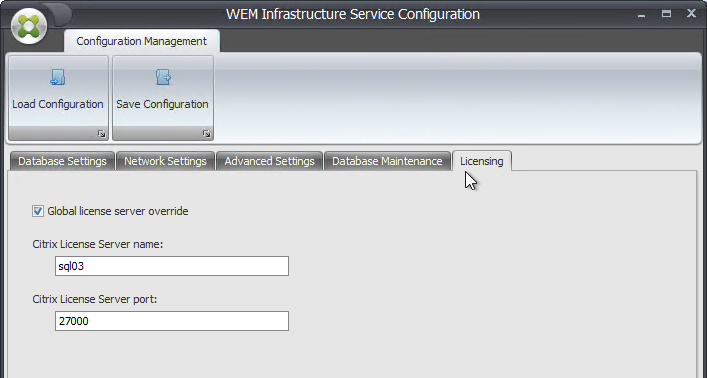
- Click Save Configuration in the ribbon.

- Click Yes when asked to restart the Broker Service.

- Close the WEM Infrastructure Service Configuration utility.
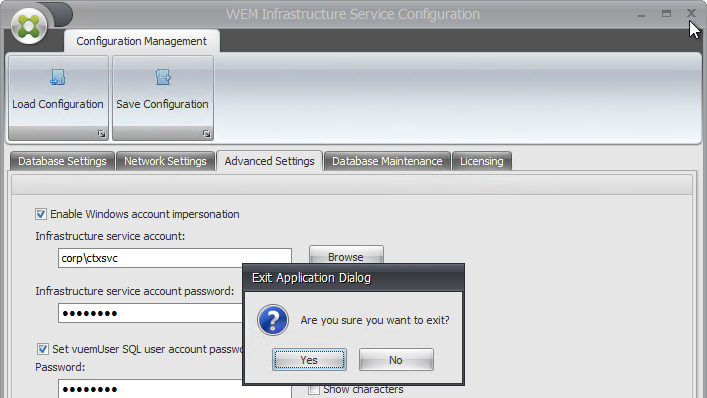
- If you are load balancing WEM servers, then you must also create a Kerberos SPN, where
[accountname]is the service account you are using for the Norskale service. If you have multiple WEM deployments in a single forest, then WEM 2411 and newer let you specify an alternative SPN as detailed at Citrix Docs.
setspn -U -S Norskale/BrokerService [accountname]
Install/Upgrade WEM Console
- Run Citrix Workspace Environment Management Console Setup.exe from the downloaded WEM 2411 (aka 2411-01-100-01) installation files.

- Check the box next to I agree to the license terms and click Install.

- In the Welcome to the Citrix Workspace Environment Management Console Setup Wizard page, click Next.
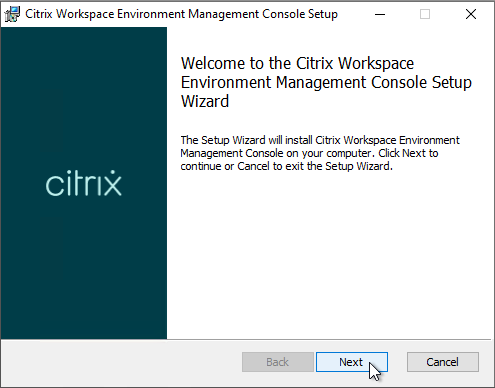
- In the Destination Folder page, click Next.
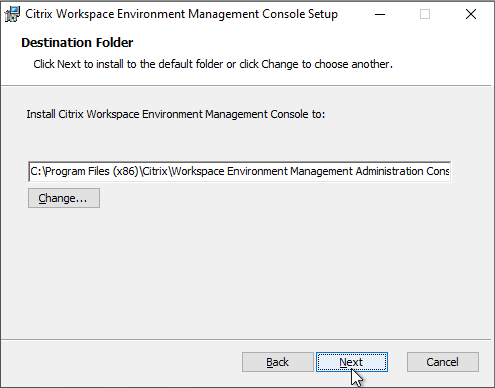
- In the Ready to install Citrix Workspace Environment Management Console page, click Install.
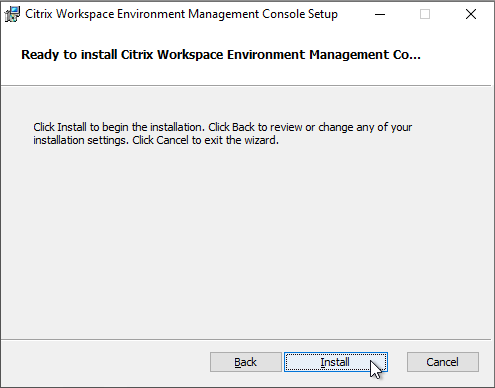
- In the Completed the Citrix Workspace Environment Management Console Setup Wizard page, click Finish.
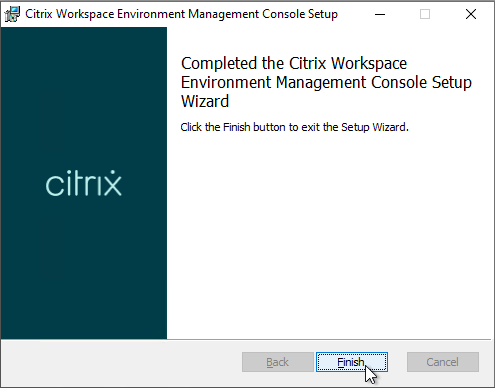
- Click Close.
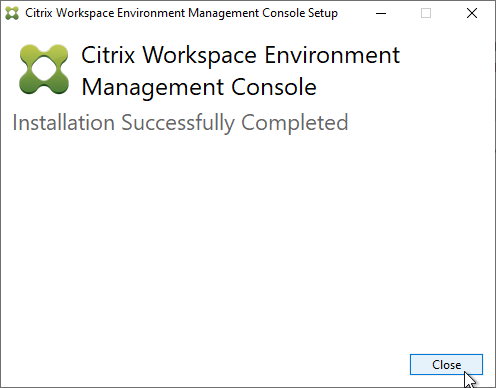
Install/Upgrade WEM Web Console
Install or upgrade the WEM Web Console on the WEM Server. The WEM Web Console can use port 443 if nothing else is using that port.
- In the extracted WEM 2411 folder, right-click Citrix Workspace Environment Management Web Console.exe and click Run as administrator.

- Check the box next to I agree to the license terms and click Install.

- In the Welcome to the Citrix Workspace Environment Management Web Console Setup Wizard page, click Next.
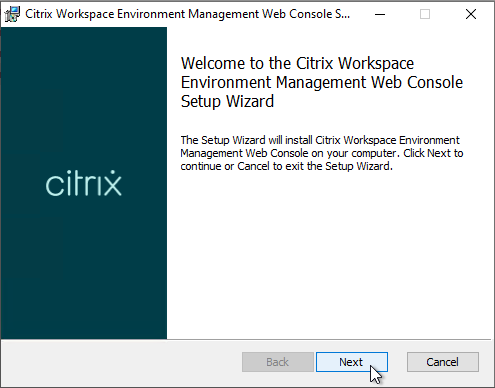
- In the Destination Folder page, click Next.
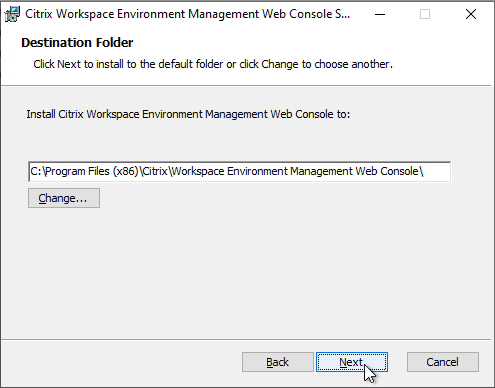
- In the Ready to install the Citrix Workspace Environment Management Web Console Setup Wizard page, click Install.
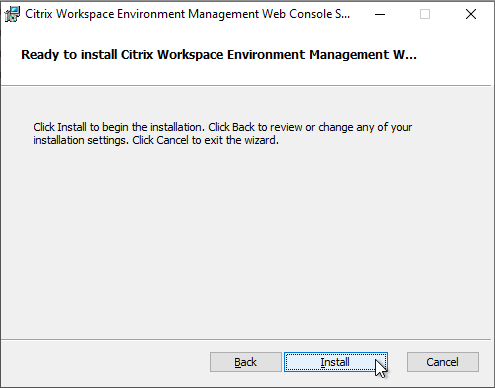
- In the Completed the Citrix Workspace Environment Management Web Console Setup Wizard page, click Finish.
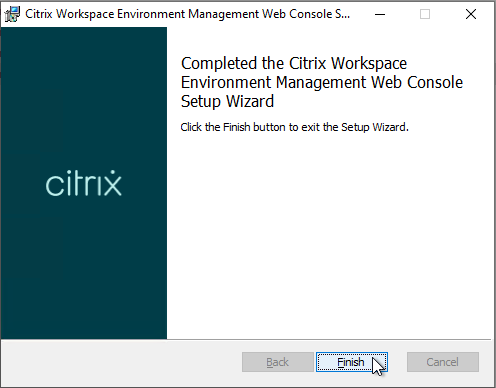
- Click Launch Web Console Configuration. This might not work if you didn’t run the installer elevated.
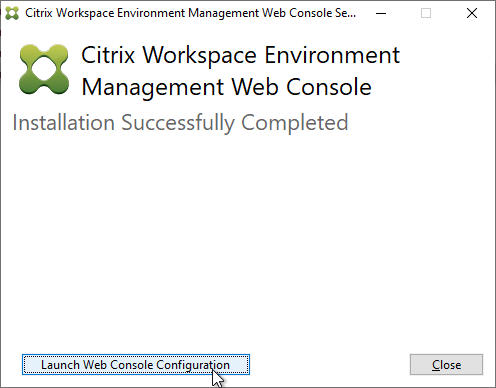
Web Console Configuration
- Create a file share for WEM and grant Modify permission to a service account.
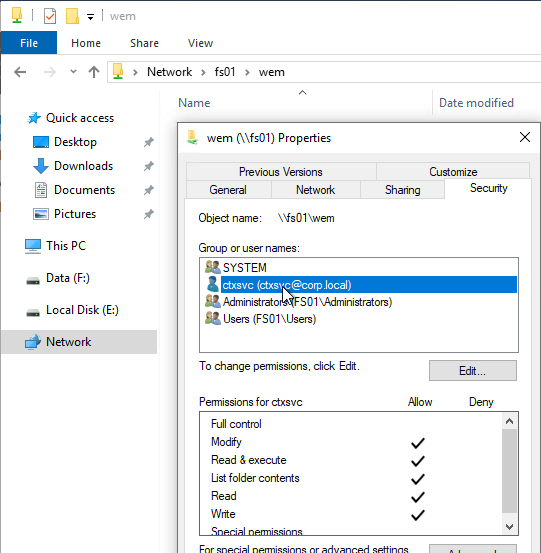
- Create a service account and add it to WEM Console > Administration > Administrators as Global Admin with Full Access and not Disabled.
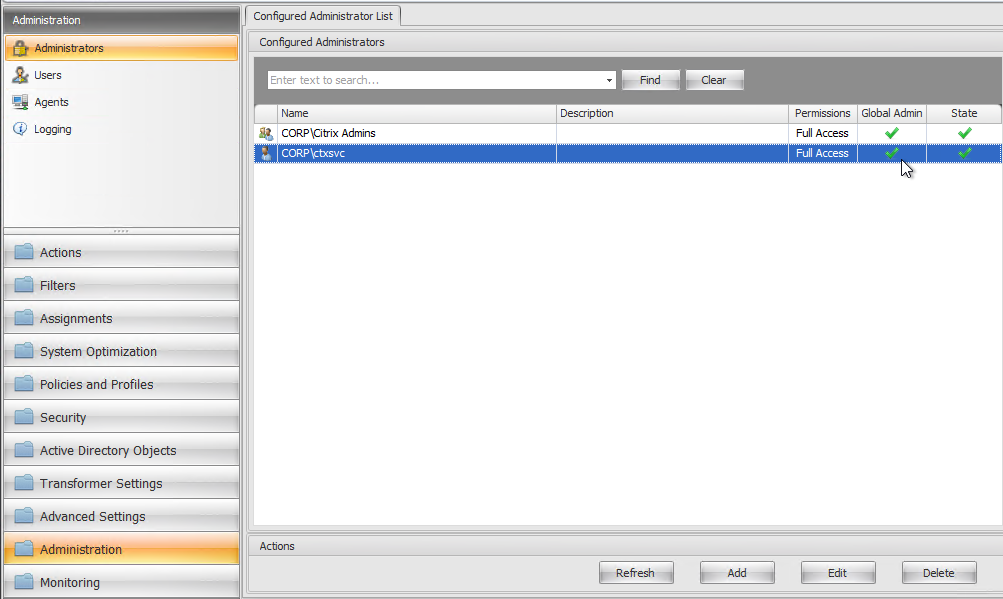
- Install a certificate in the Local Computer store (certlm.msc).

- From the Start Menu, right-click WEM Web Console Configuration, expand More, and click Run as administrator.
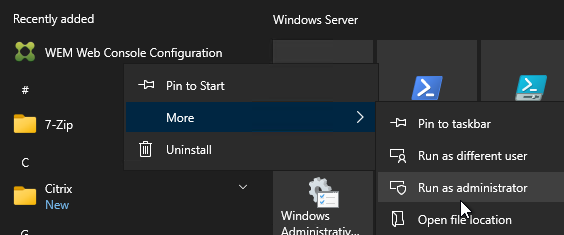
- Click Next.
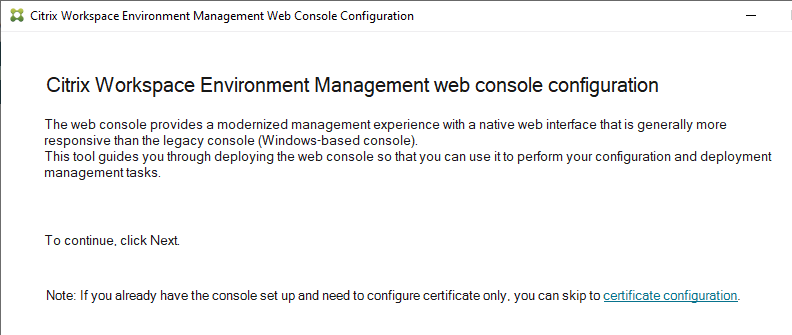
- The Port number cannot conflict with other services already using the port, including IIS.
- The Infrastructure server name can be localhost if you installed the Web Console on the WEM Infrastructure Server.
- User name must be Global Admin inside WEM.
- Click Start service.
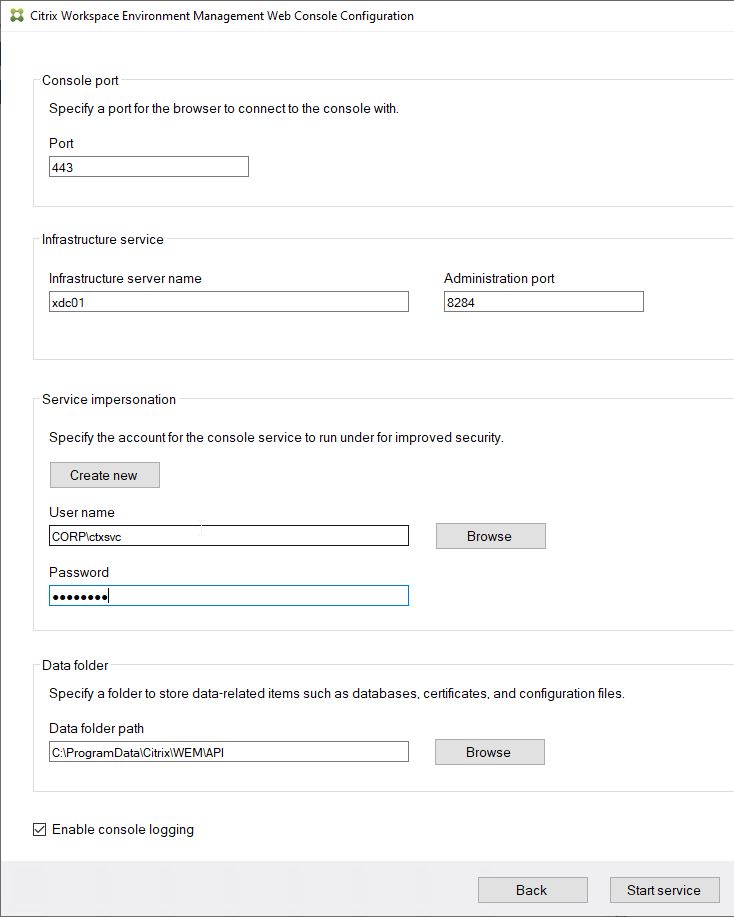
- Click Configure certificate.


- Browse to the local cert and then click Set up certificate.
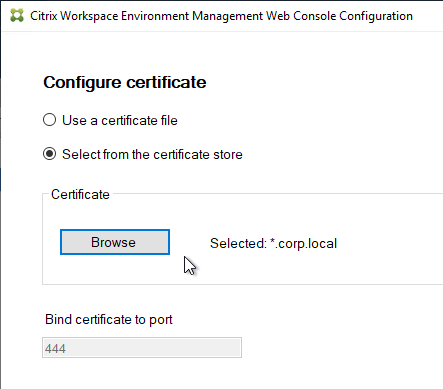

- Click Finish.


- Launch the Web Console and login.
- Click your name on the top-right and click Storage folder.
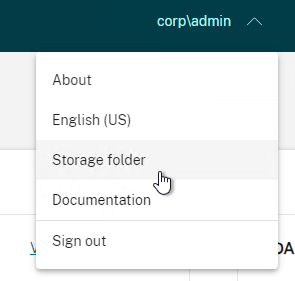
- Enter the UNC path to the file share for WEM.
- Check the box next to Require credentials and enter the service account. Click Done.
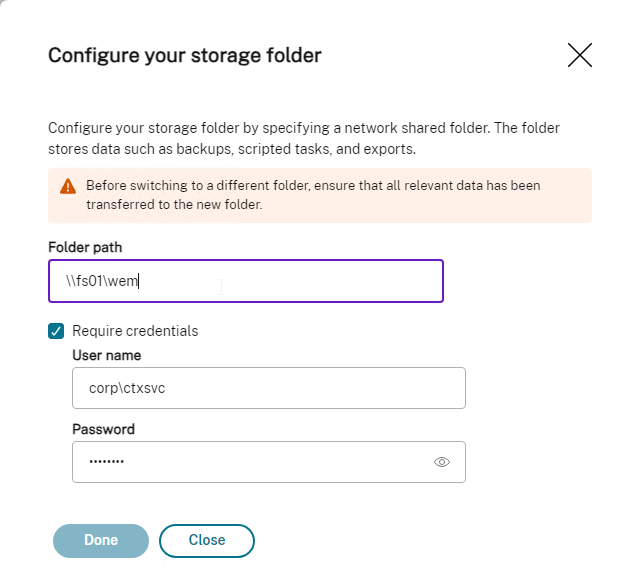
WEM Configuration Sets
Each WEM Agent belongs to one Configuration Set. Most actions in a Configuration Set can be filtered, but some settings are global to the Set. To handle global settings, you can create multiple Configuration Sets that apply to different WEM Agents.
In WEM Web Console (2308 and newer):
- On the left, click Configuration Sets.
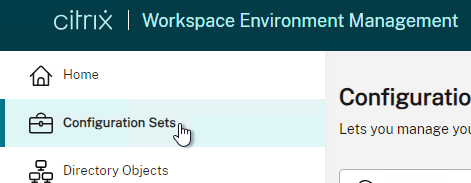
- On the right, click Add configuration set.

- Give the set a name and click Save.
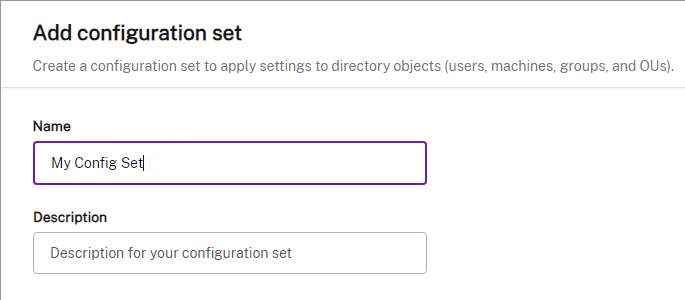

- Click a Configuration Set to create Actions and configure other settings.
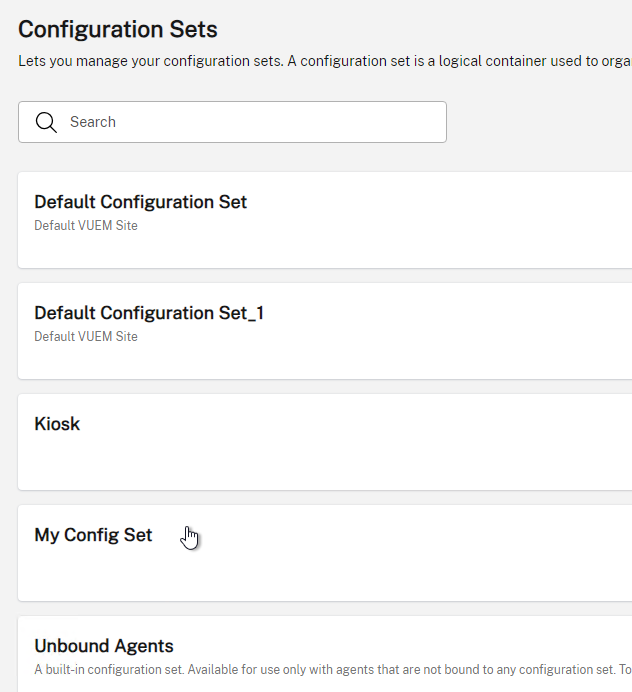
- Use the drop-down menu on the top-left to switch to a different Configuration Set.
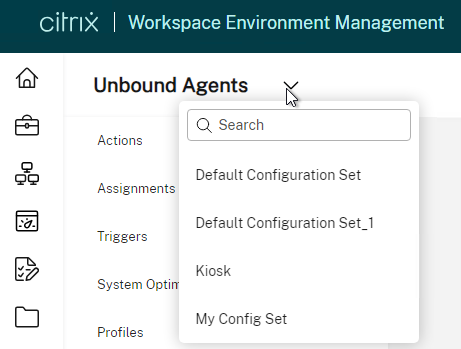
- Directory Objects lets you add individual computers or computer Organizational Units (OUs) and assign them to Configuration Sets.
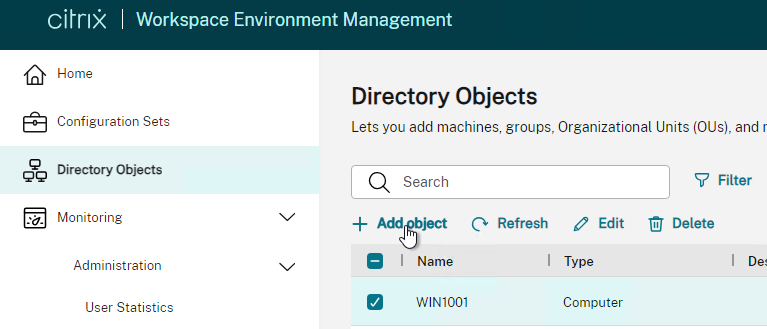
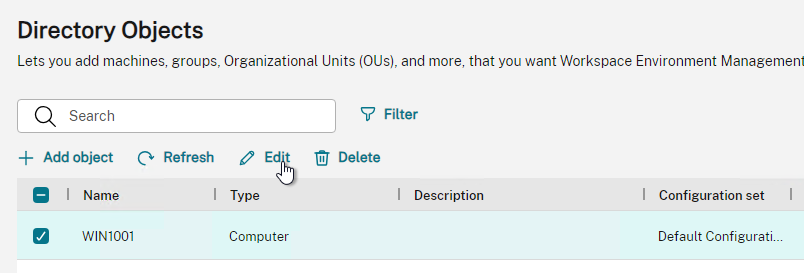
- Back in the list of Configuration Sets, on the right, you can click Backup and Restore.

- Click Backup to perform a manual backup. Or click Manage automatic backup. The backups are stored in the SMB file share. In WEM 2407 and newer, automatic backups can keep up to 25 backups.


- Notice the Directory objects are not included in the backups.
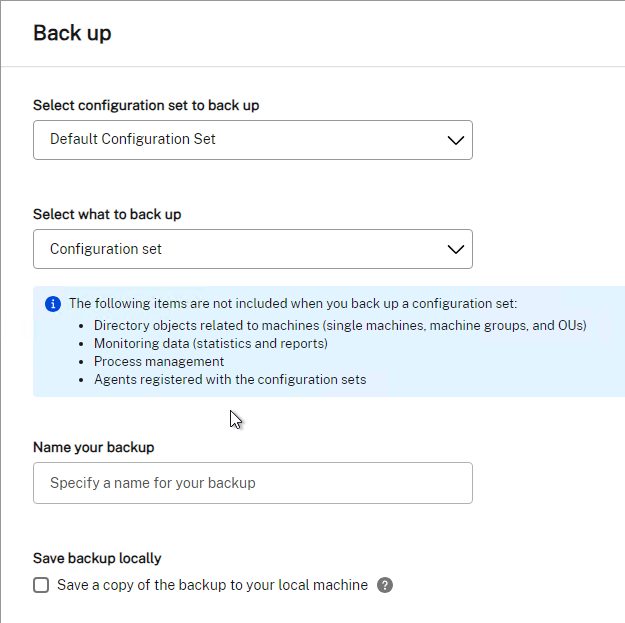
- After you have a backup, you can Restore it to any Configuration Set. This is an easy way of copying one Set to another.

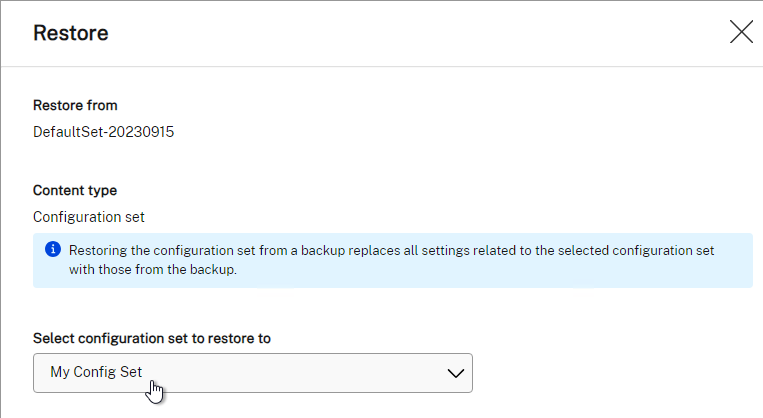
In WEM Classic Console:
- From the Start Menu, run WEM Administration Console.
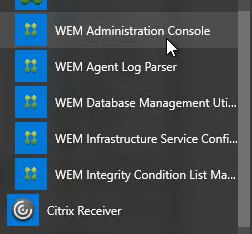
- In the ribbon, click Connect.
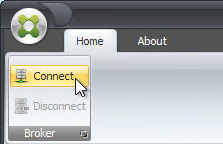
- In the Infrastructure Server Connection window, enter the WEM Server name, and click Connect.
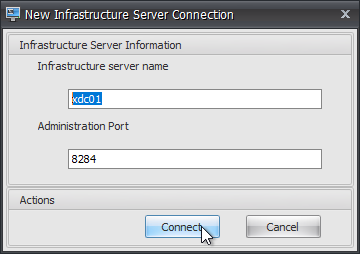
- Some WEM Console settings are global (every agent gets the same setting). So if you want different global settings for different agents, then you create multiple WEM Configuration sets. At the top of the window, in the ribbon, you can create a new WEM Configuration set.

- WEM 1912 and newer can Backup and Restore entire Configuration Sets, which makes it easy to duplicate a Configuration Set.
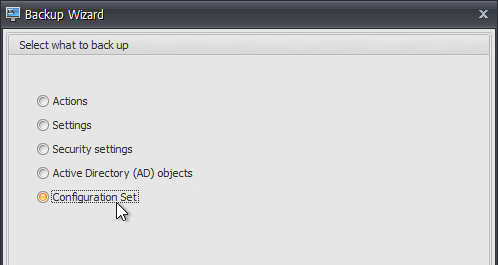
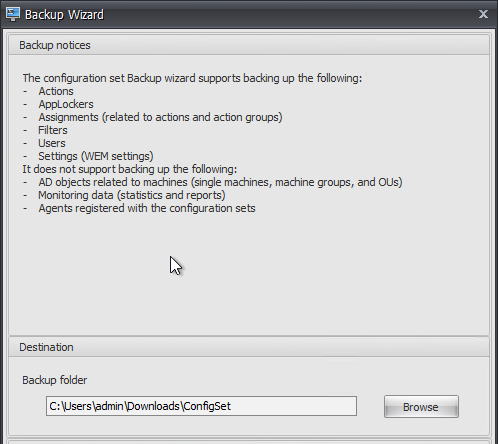
- When Restoring a Configuration Set, there’s no need to create a new empty Set. Just run the Restore wizard and WEM will try to use the original Configuration Set name. If the original Configuration Set already exists, then WEM will append _1 to the name, which you can then rename.

- When Restoring a Configuration Set, there’s no need to create a new empty Set. Just run the Restore wizard and WEM will try to use the original Configuration Set name. If the original Configuration Set already exists, then WEM will append _1 to the name, which you can then rename.
- Once you have multiple Configuration sets, you can use the drop-down to switch between them.

- A WEM Agent can only belong to one WEM Configuration set. Different Agents can belong to different WEM Configuration sets.
- In WEM 4.3 and newer, you add agents to the Configuration set at Active Directory Objects (workspace on bottom left) > Machines (node on top left). You can add OUs or individual objects (computers or computer groups).
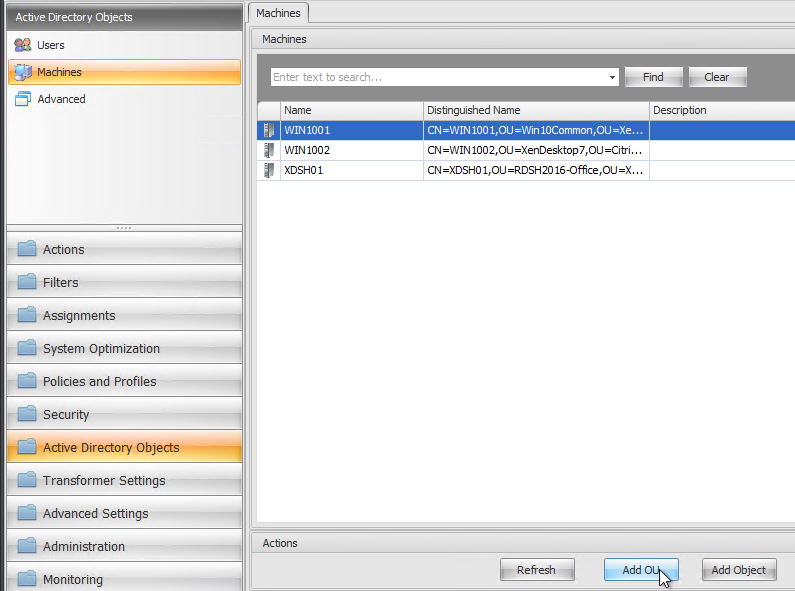
Import Recommended Settings
If you have multiple WEM configuration sets, this process should be repeated for each new, empty WEM configuration set. This process is only available in the classic WEM Console.
- On the right side of the ribbon, click Restore.

- Select Settings and click Next.
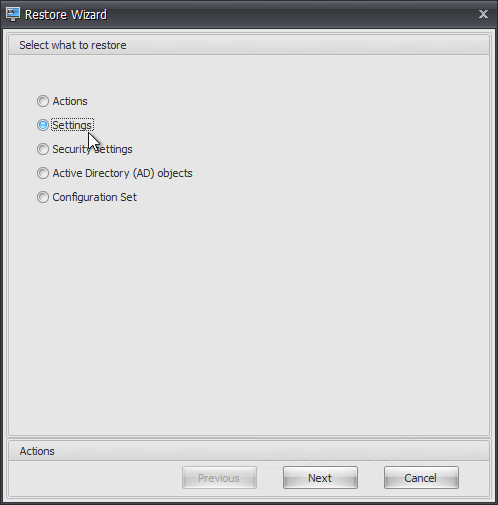
- In the Settings Restore wizard, click Next.
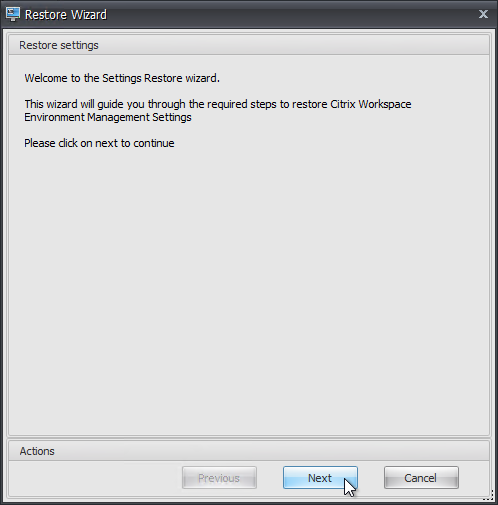
- In the Restore from folder section, click Browse, and browse to the \Workspace-Environment-Management-v-2411-01-100-01\Configuration Templates\Default Recommended Settings folder that was included in the WEM download.
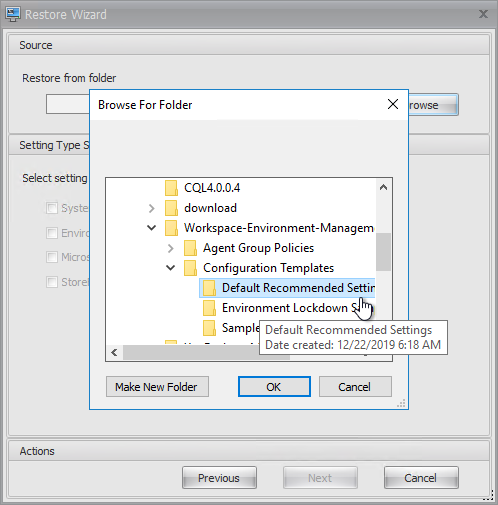
- In the Settings Type Selection section, check all available boxes, and click Next.
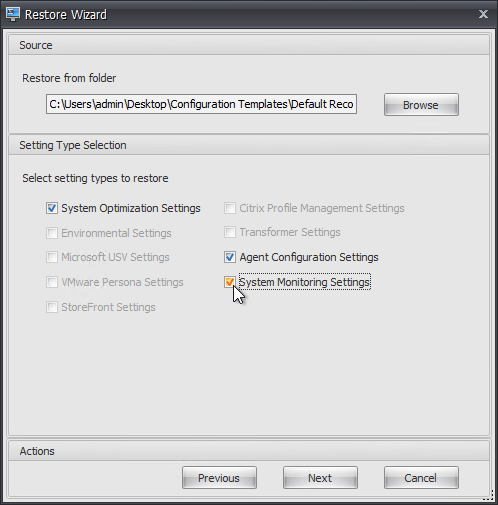
- In the Restore settings processing window, click Restore Settings.
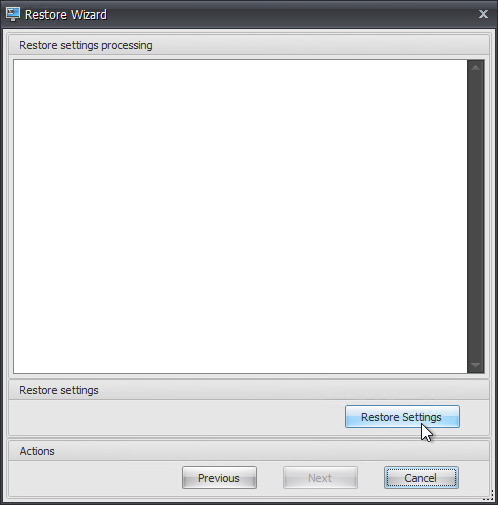
- Click Yes when prompted to replace.

- Click Finish.
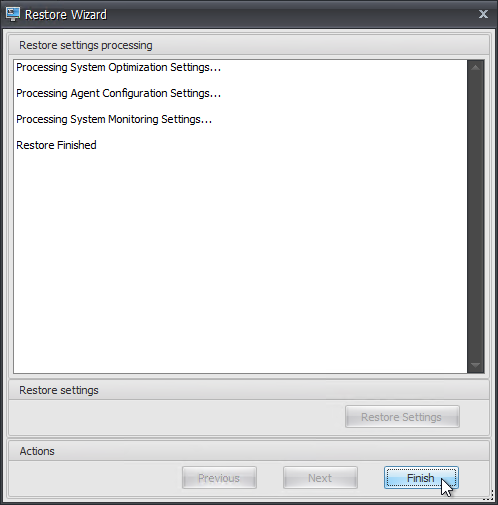
CTP James Kindon at WEM Hydration Kit has a collection of Applications, File System and Registry Actions that can be imported to WEM. CTP James Kindon recently added Environmental Settings to the Hydration Kit.
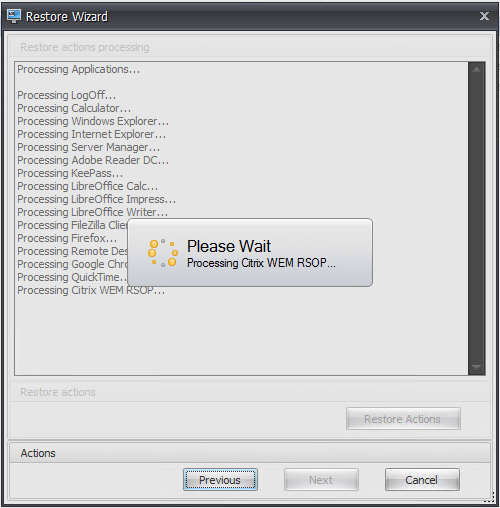
WEM 1909 and newer can Migrate your Group Policies to WEM. CTP James Kindon at Migrating GPO settings to WEM explains this feature in detail.

WEM Administrators
This is only configurable in the Classic WEM Console.
- In the Administration Console, go to Administration (workspace on bottom left) > Administrators (node on top left).
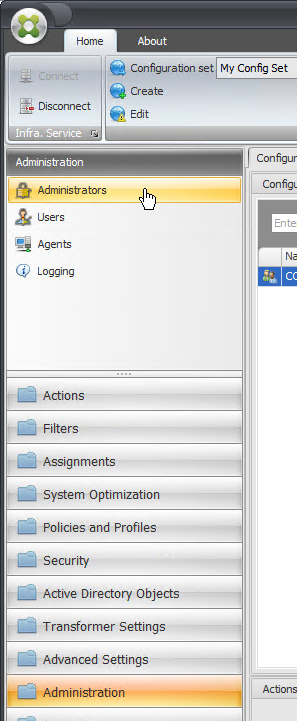
- In the right pane, click Add, and specify an Active Directory group that can administer WEM.
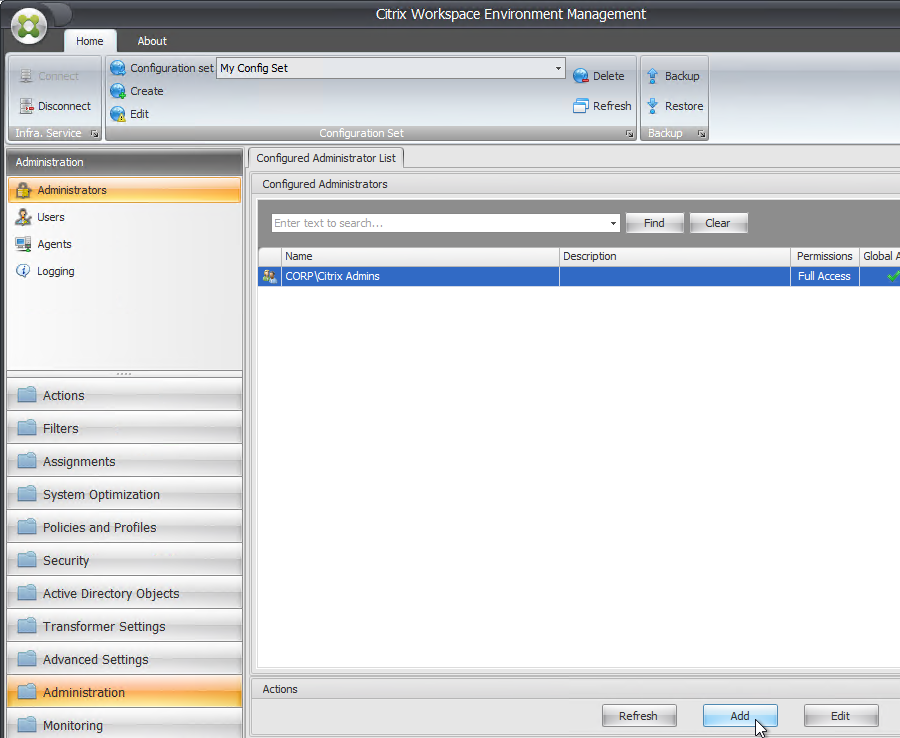
- After adding a group or user, right-click the new administrator, and click Edit.
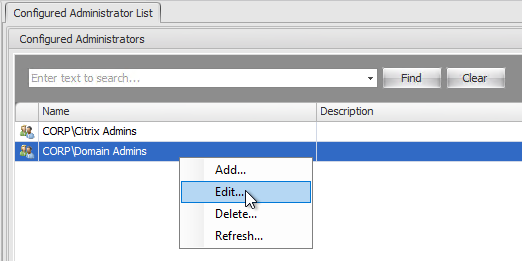
- Use the Permissions drop-down to select a role. The roles are detailed at Administrators at Citrix Docs.
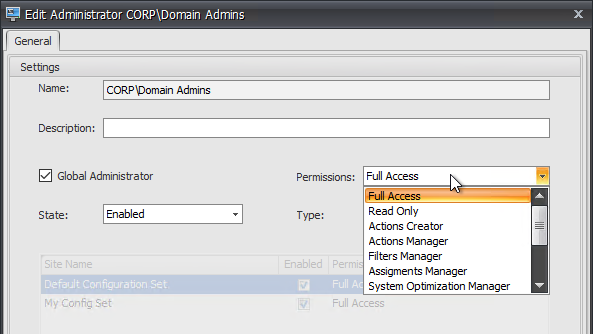
- Then use the State drop-down to select Enabled. New administrators are initially disabled. Click OK to close the window.
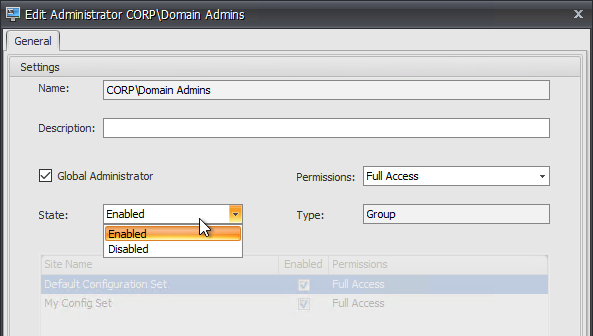
WEM Agent Configuration
For configuration guidance, see CTP James Kindon WEM Advanced Guidance – 2023 at CUGC.
Most of these settings are available in the WEM Web Console.
- In the WEM Web Console, click a Configuration Set, expand Advanced Settings and click Agent Settings.
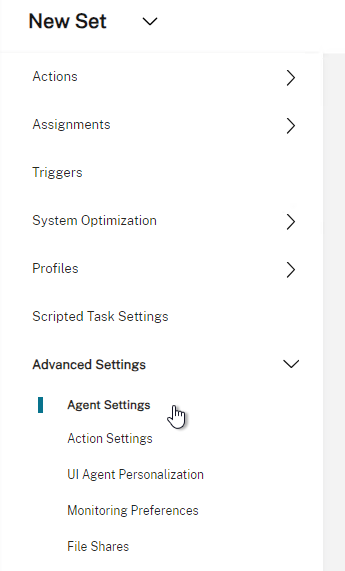
- Click Agent options.
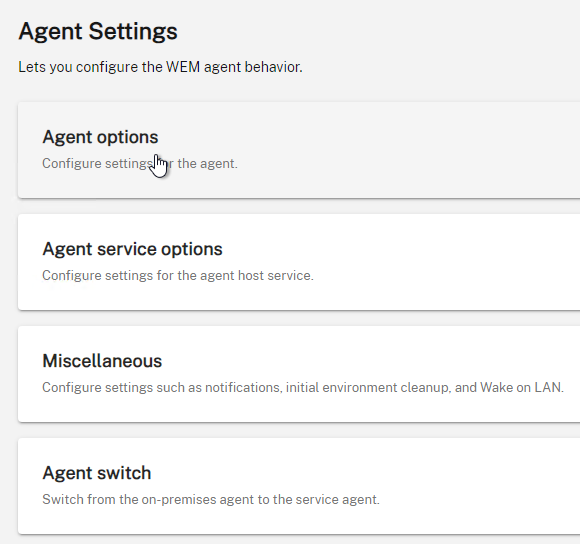
- When making changes, make sure you click Apply changes periodically.

- When making changes, make sure you click Apply changes periodically.
- Setting on these tabs are mostly self-explanatory. Feel free to change any as desired. If you imported a default configuration, then many of these might already be enabled. If not, then configure them manually.
- Check the Launch agent options. and Enable desktop compatibility mode. Web Console lets you configure launch exclusions.
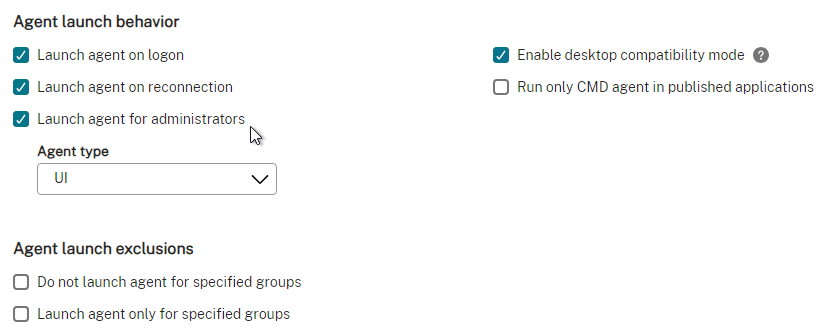
- Enable automatic refresh.
- Enable Offline Mode and Use cache to accelerate actions processing. More info at Citrix Blog Post Workspace Environment Management agent caching explained.
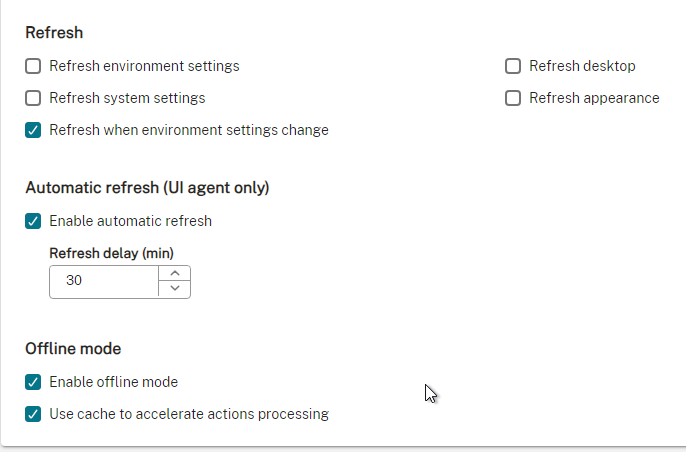
- The Action processing section lets you select which modules should be refreshed on reconnect.
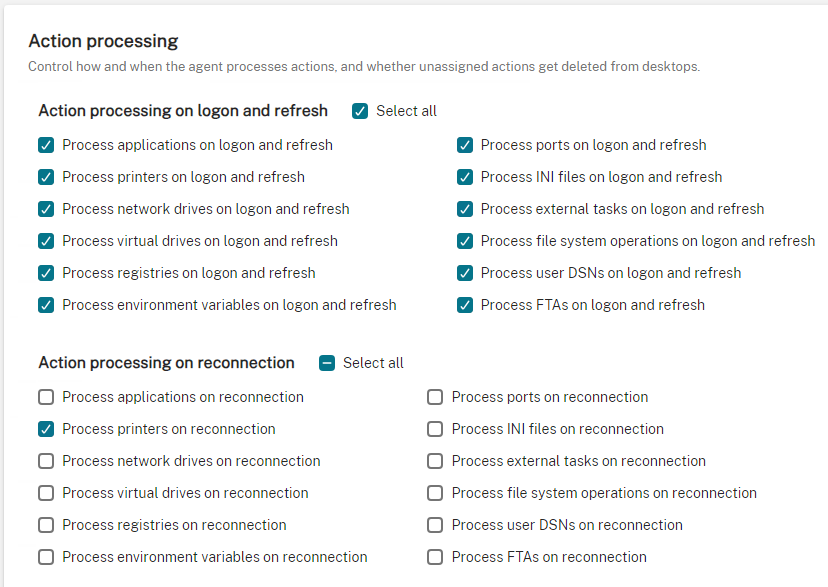
- Scroll down and there are options to process printers and drives asynchronously.

- Agent service options section has a setting for Bypass ie4uinit Check. Enabling this might eliminate a 2-minute delay before WEM Agent starts.
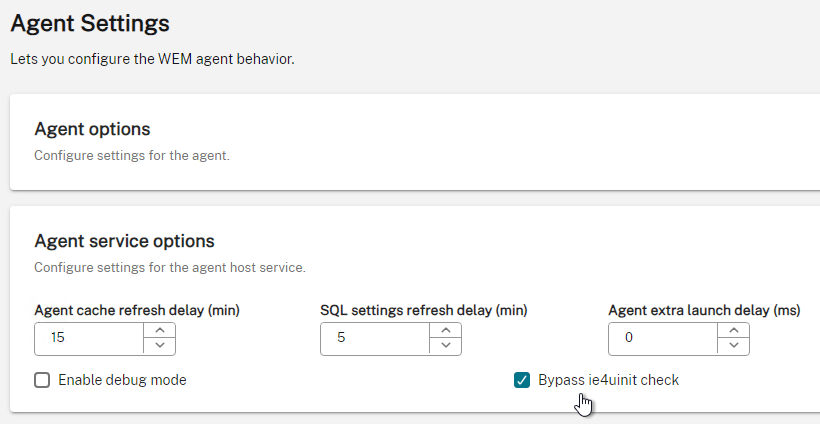
- On the left is UI Agent Personalization. On the right is Appearance and interaction. You can change the UI agent theme. Other settings on this page let you hide the splash screen.
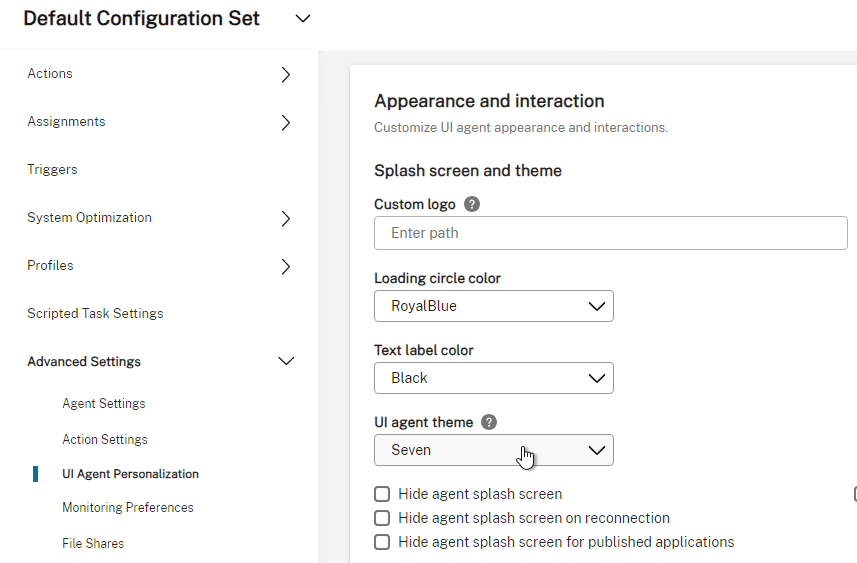
- The Helpdesk Options section lets you enable Screen Capture from the WEM Agent.
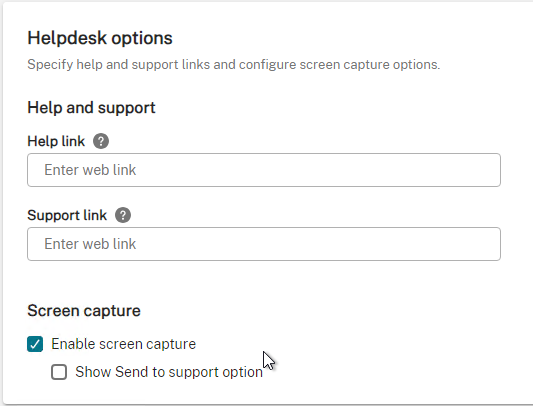
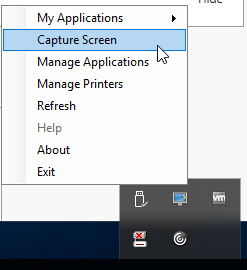
- At Advanced Settings > Monitoring Preferences, in WEM 2407 and newer, expand Profile container insights and you can Enable large file scanning.

- Then you can run the report at Monitoring > Profile Container Insights.

- Then you can run the report at Monitoring > Profile Container Insights.
System Optimization
- The System Optimization node lets you configure the various optimizations.
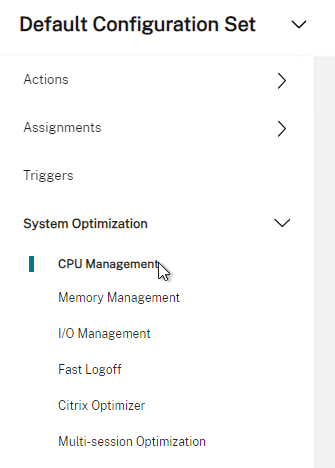
- WEM Classic Console has a System Optimization workspace (bottom left).
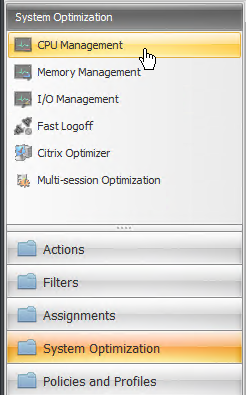
- WEM Classic Console has a System Optimization workspace (bottom left).
- On the top left, click the CPU Management node/section.
- CPU Spikes Protection gives processes equal access to the CPU.
- There’s an option for Auto Prevent CPU Spikes.
- From Hal Lange: “CPU Usage Limit should never be set to higher a percentage than one CPU. This will keep a single threaded application from thrashing a CPU. Example: if 2 CPU’s are available, the CPU setting should not be set above 49%, if 4 CPU’s are available, the CPU setting should not be set above 24%”
- Hal Lange demonstrates Citrix WEM Performance Optimizations in a YouTube video.
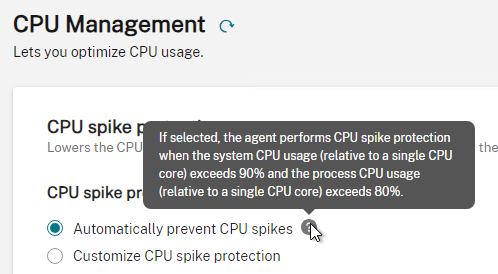
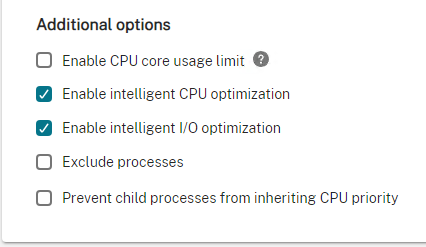
- Other tabs/sections let you manually specify CPU priority and/or clamping.
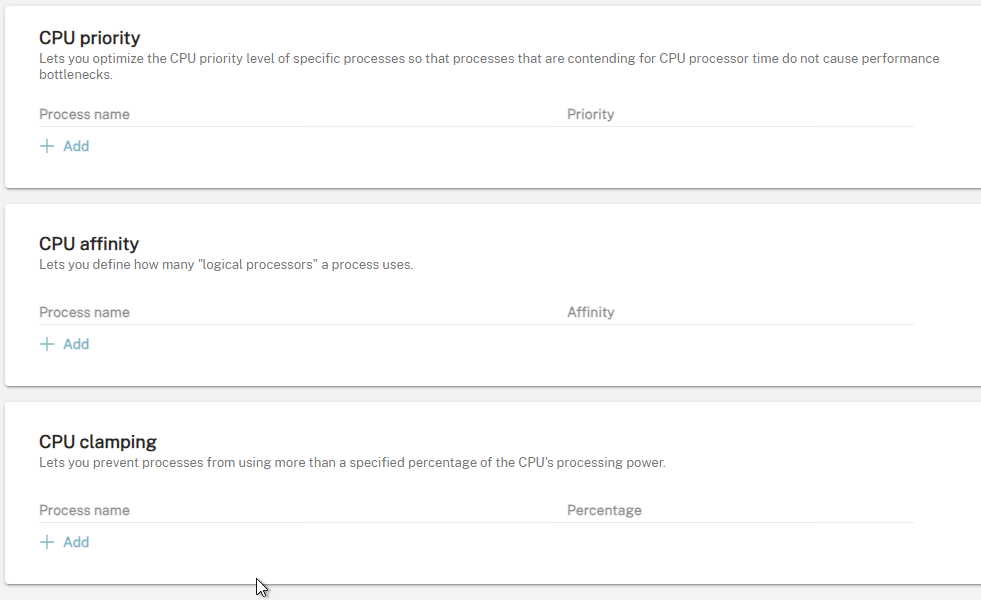
- CTX230843 WEM protection and Skype for Business + Real Time Optimization Pack has a list of processes that should be excluded from WEM CPU Spikes protection.
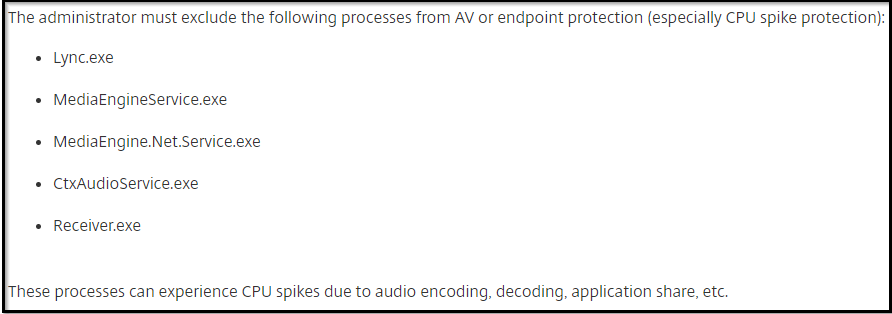
- CTX230843 WEM protection and Skype for Business + Real Time Optimization Pack has a list of processes that should be excluded from WEM CPU Spikes protection.
- Web Console > Monitoring > Insights > Optimization Insights has a report showing CPU optimization.
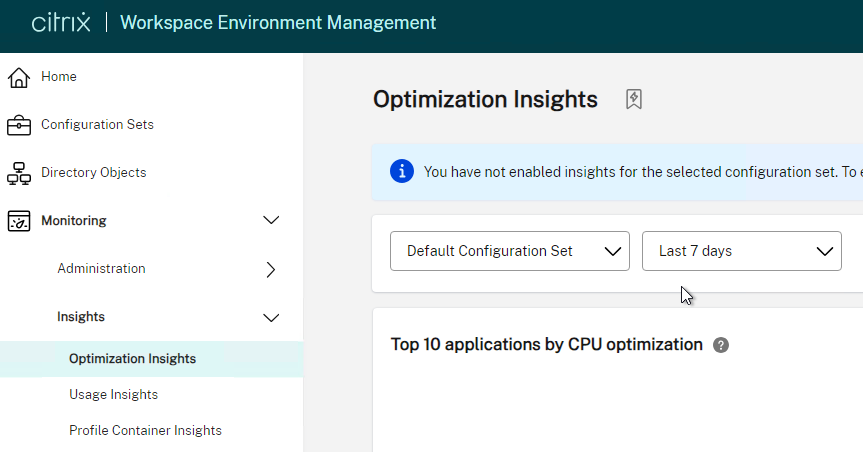
- From CTA Chris Schrameyer WEM – CPU LOGGING: WEM does not provide any built-in logs to determine when a CPU Spikes Protection action is taken. It would be nice to know what processes are often limited, so we can then add them to a CPU Clamping policy or identify why they are using so much CPU.
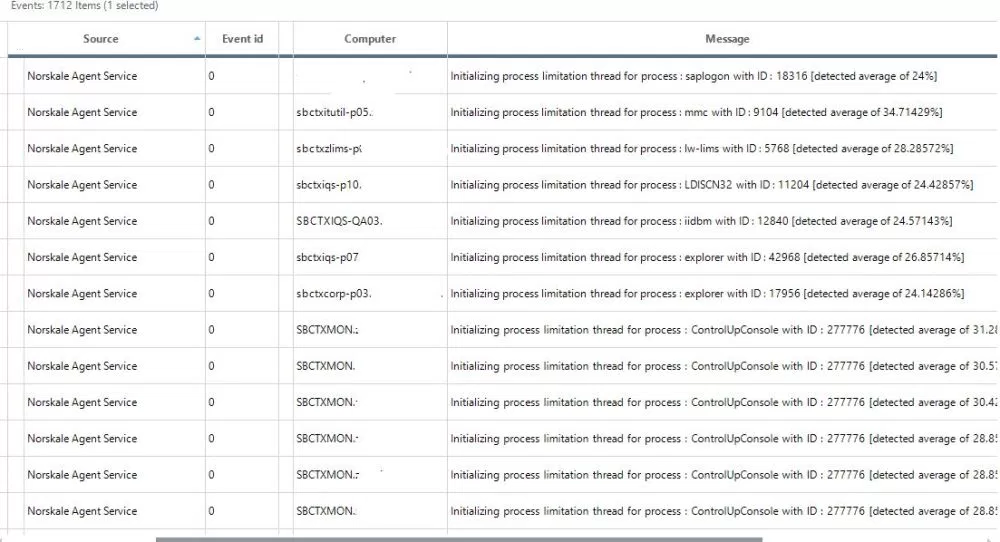
- From CTA Chris Schrameyer WEM – CPU LOGGING: WEM does not provide any built-in logs to determine when a CPU Spikes Protection action is taken. It would be nice to know what processes are often limited, so we can then add them to a CPU Clamping policy or identify why they are using so much CPU.
- Memory Management node, you can enable Optimize Memory Usage for Idle Processes to periodically reclaim memory from running processes. This feature tells processes to flush their memory to disk. In other words, you’re trading memory for disk.
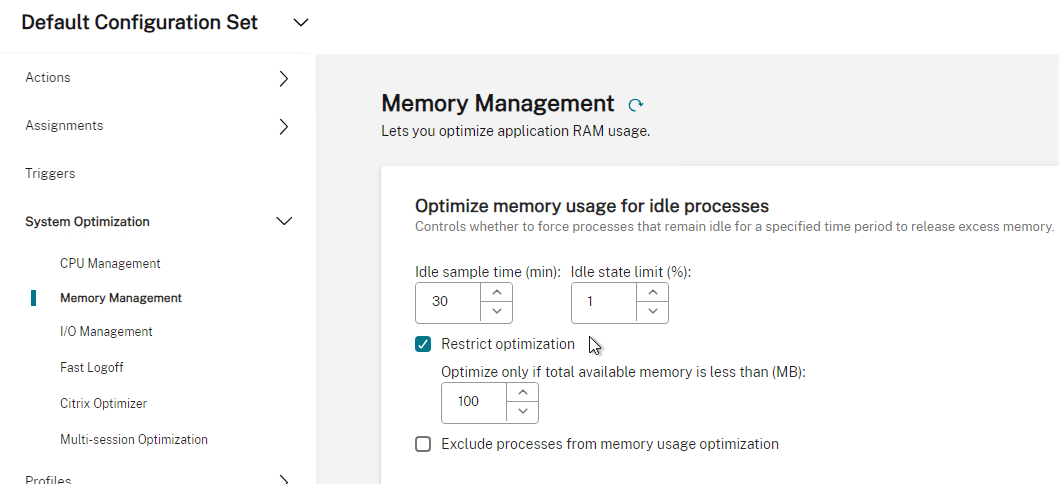
- WEM 2206 adds an option for Optimize only if total available memory is less than (MB) or Do Not Optimize When Total Available Memory Exceeds (MB). In other words, WEM does not optimize memory until available memory drops below this value.
- WEM 2206 adds a Memory Usage Limit for Specific Processes. Dynamic means the process memory is not limited until available memory is low.
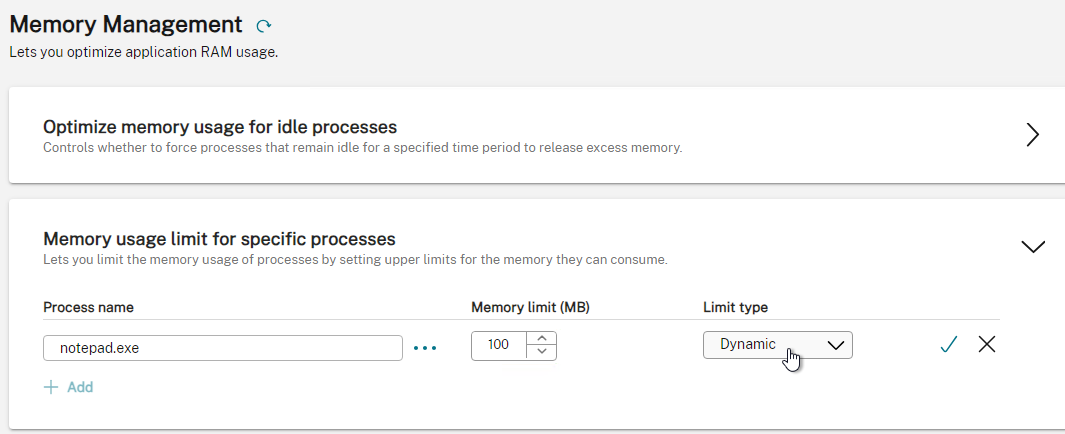
- In the I/O Management node, on the right, you can prioritize process IO. Use the slider on the far right to enable the feature.

- In the Fast Logoff node, in the right pane, enabling Fast Logoff disconnects a session immediately, and runs logoff processes in the background.

- WEM 2003 and newer have a Citrix Optimizer feature. If you enable it, then the WEM Agents will disable services and scheduled tasks according to the settings in the template. WEM comes with built-in templates, or you can add your own. Newer versions of WEM have newer templates. WEM 2311 and newer support Windows 11 and Windows Server 2022.
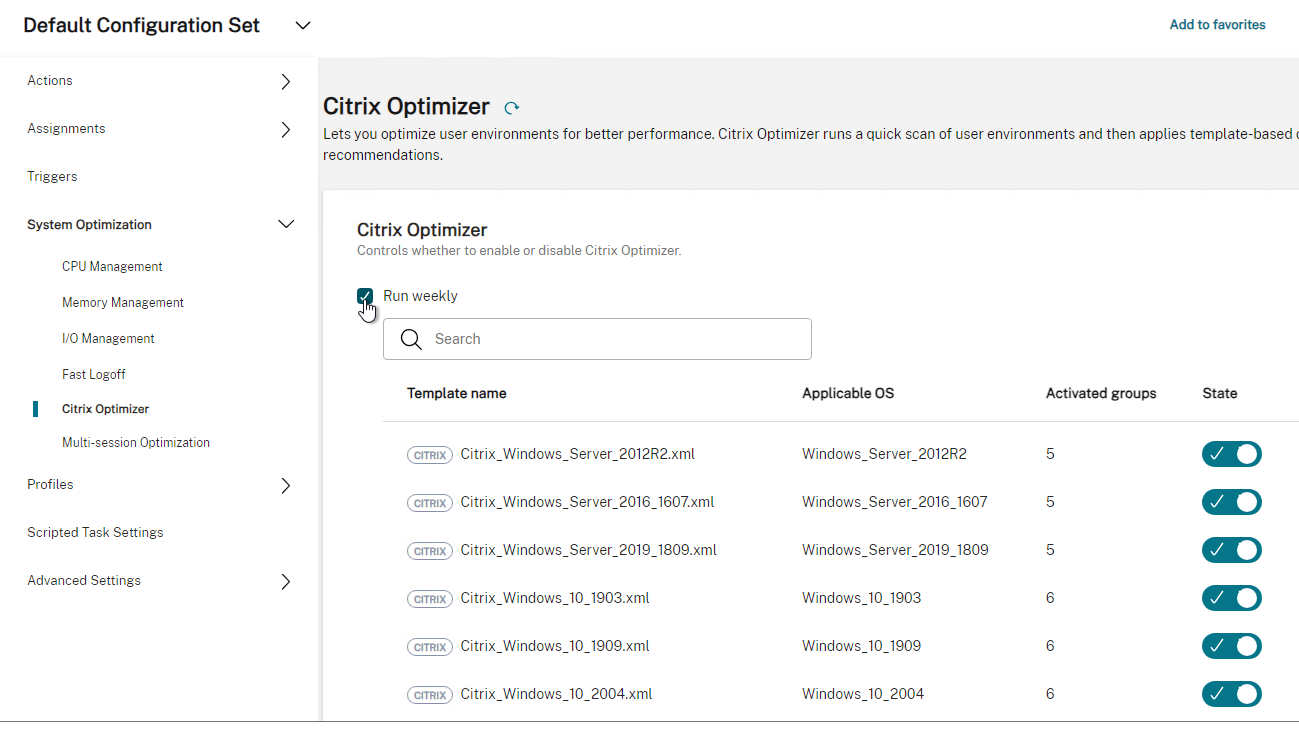
- WEM 2012 and newer have an option to Automatically select Templates to Use.

- The Monitoring > Administration > Agents section adds a Process Citrix Optimizer action to each agent.
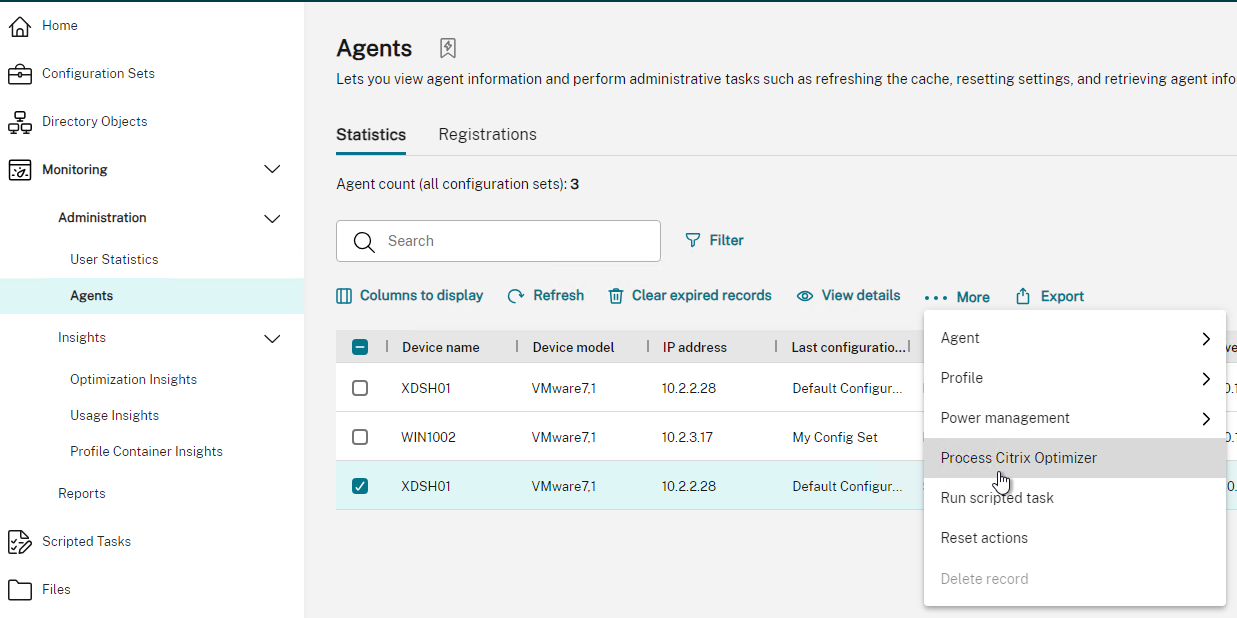
- WEM 2012 and newer have an option to Automatically select Templates to Use.
- WEM 2112 and newer have a Multi-session Optimization feature that lowers the priority of processes running in disconnected sessions.
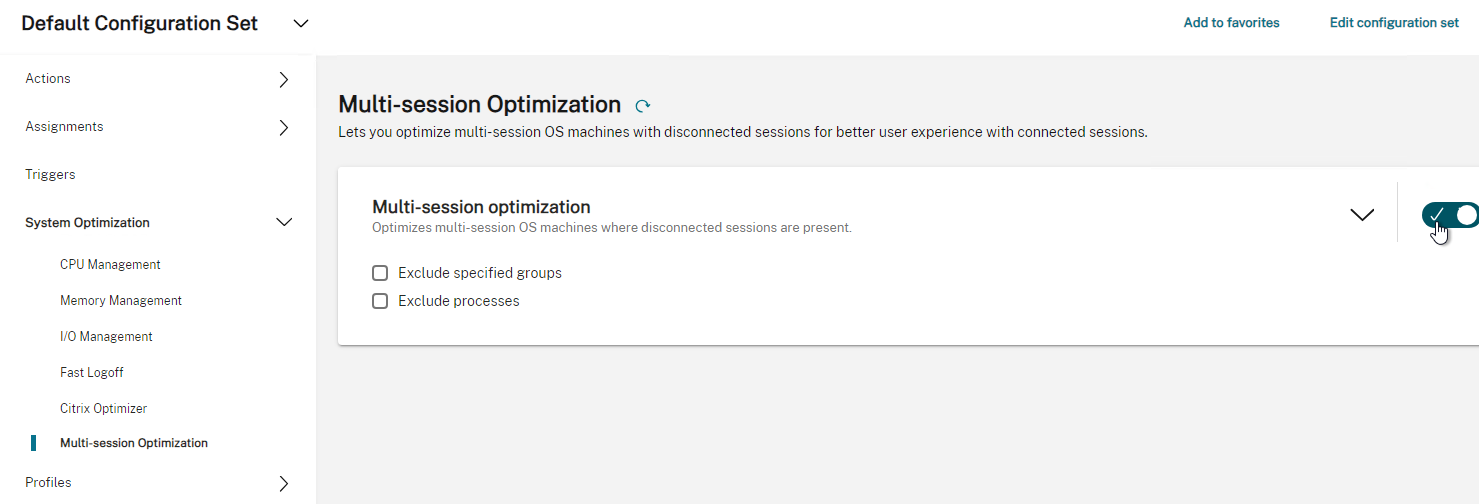
Security
This section is only available in the WEM Classic Console.
- Click the Security workspace. On the top left, click the Process Management node. In the right pane, in the Processes Management tab, enable Process Management. The other tabs are grayed out until you check this box.
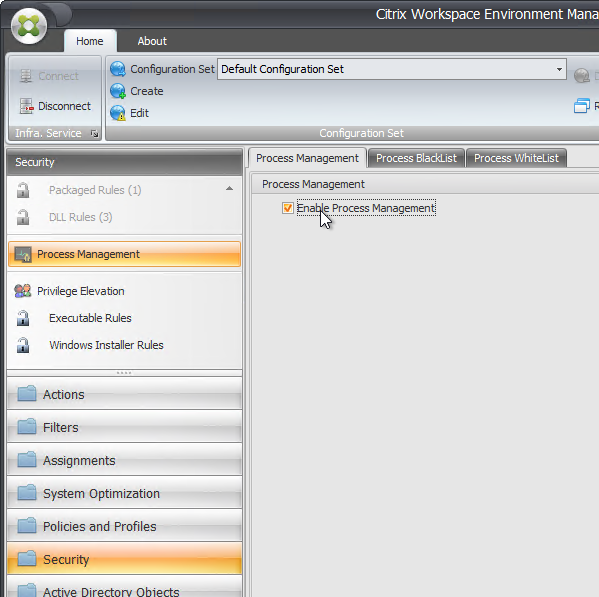
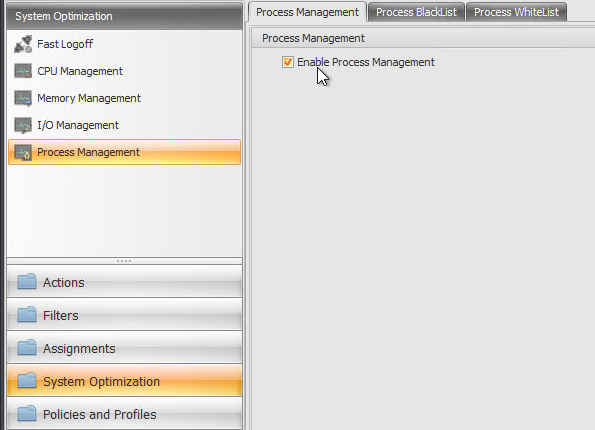
- You can BlackList processes. There’s also a WhiteList, but once something is added to the WhiteList, then all other processes are blocked.
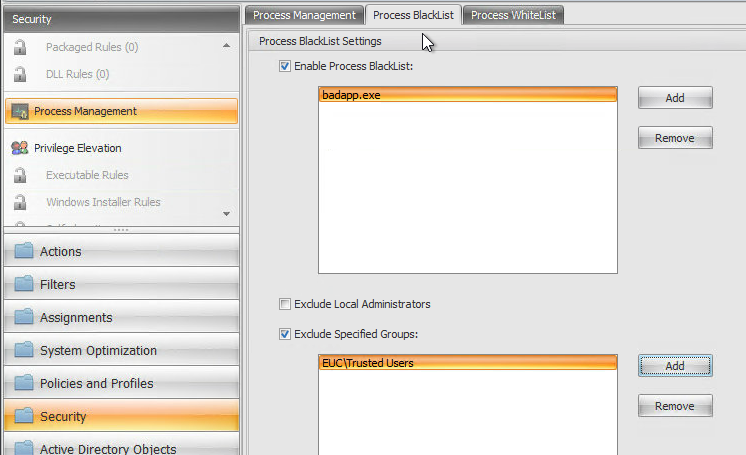
- You can BlackList processes. There’s also a WhiteList, but once something is added to the WhiteList, then all other processes are blocked.
- On the top left, click Application Security.
- WEM database query from CTX233578 Application Security rules might not be enforced properly when multiple users simultaneously log on to the same server OS machine:
UPDATE VUEMSystemUtilities SET Value='0' WHERE Name='AppLockerControllerReplaceModeOn' AND idSite=[idSite];
- WEM database query from CTX233578 Application Security rules might not be enforced properly when multiple users simultaneously log on to the same server OS machine:
- You can use the top-left sub-nodes to configure AppLocker. See Application Security at Citrix Docs.
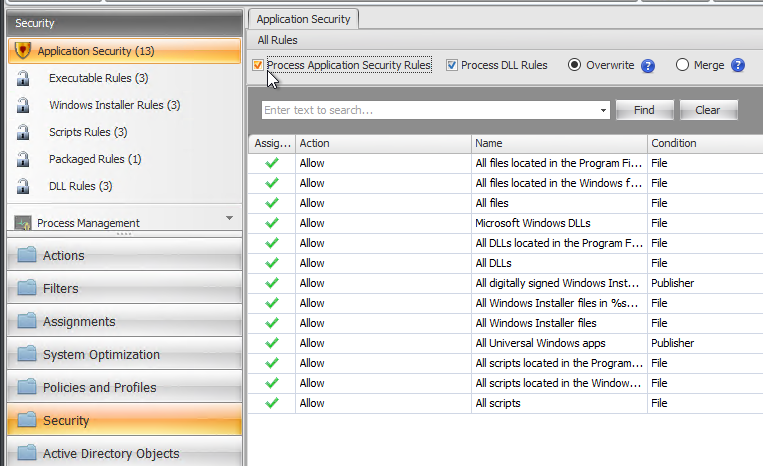
- If you click the Executable Rules sub-node, on the bottom right is a button to Add Default Rules.
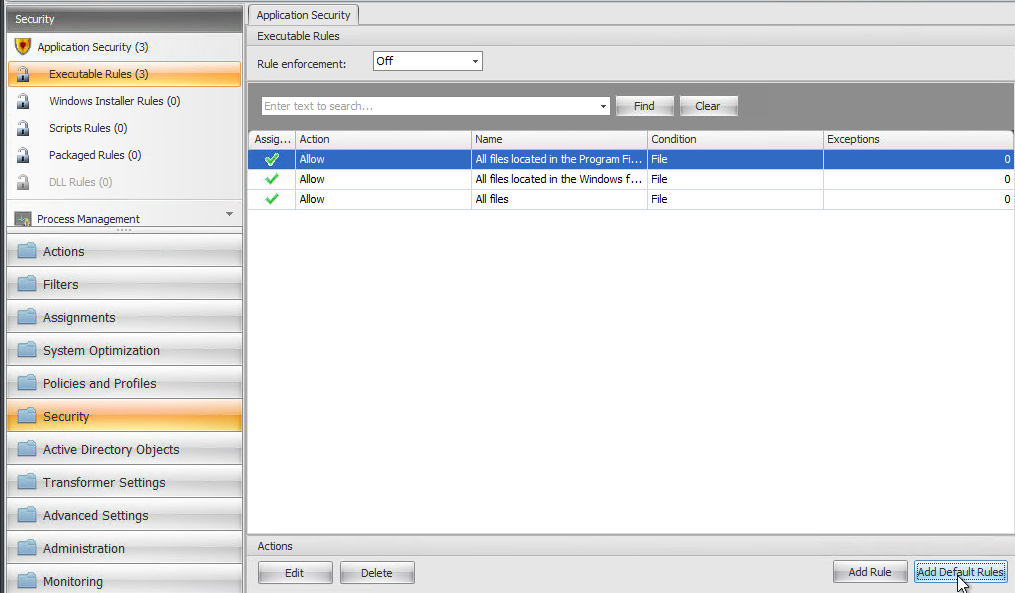
- If you edit a rule…
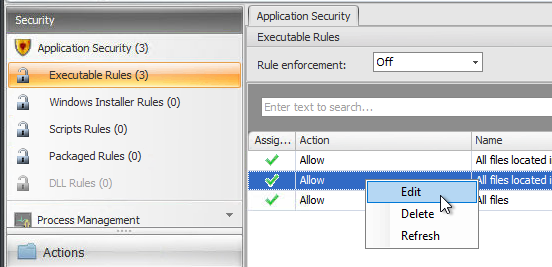
- You can assign the rule to a user group.
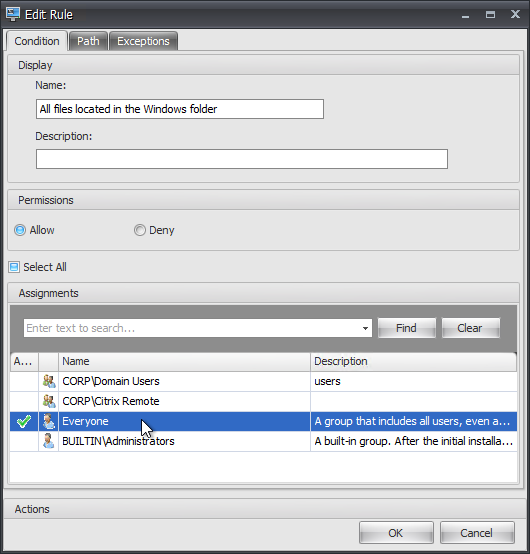
- The list of user groups comes from Active Directory Objects (workspace on bottom left) > Users.
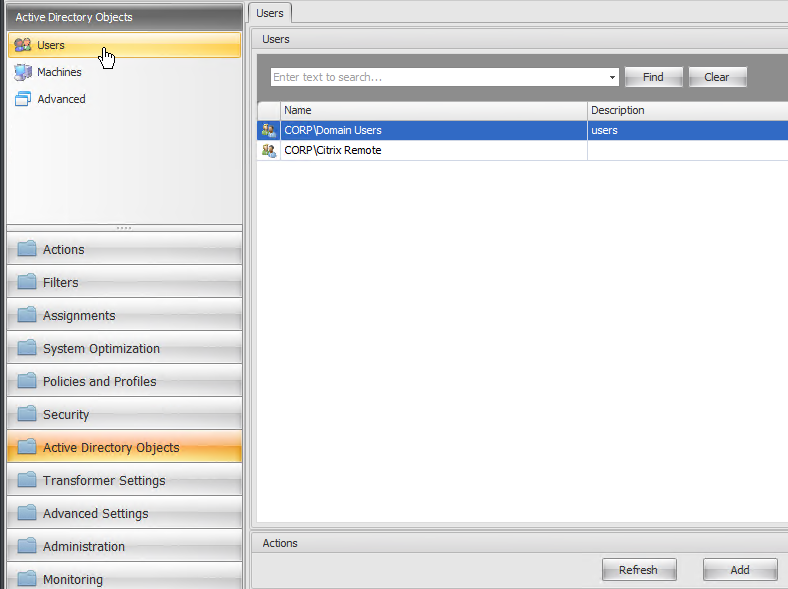
- On top of the right pane, set Rule enforcement to On or Audit.
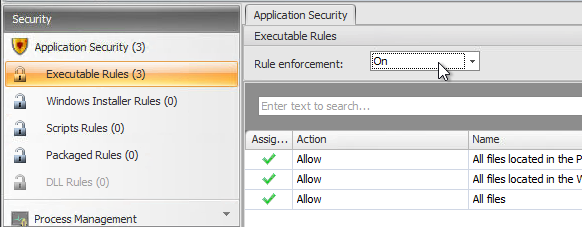
- In the ribbon is a button to Import AppLocker Rules that were exported from a group policy.

- The other sub-nodes follow the same configuration pattern.
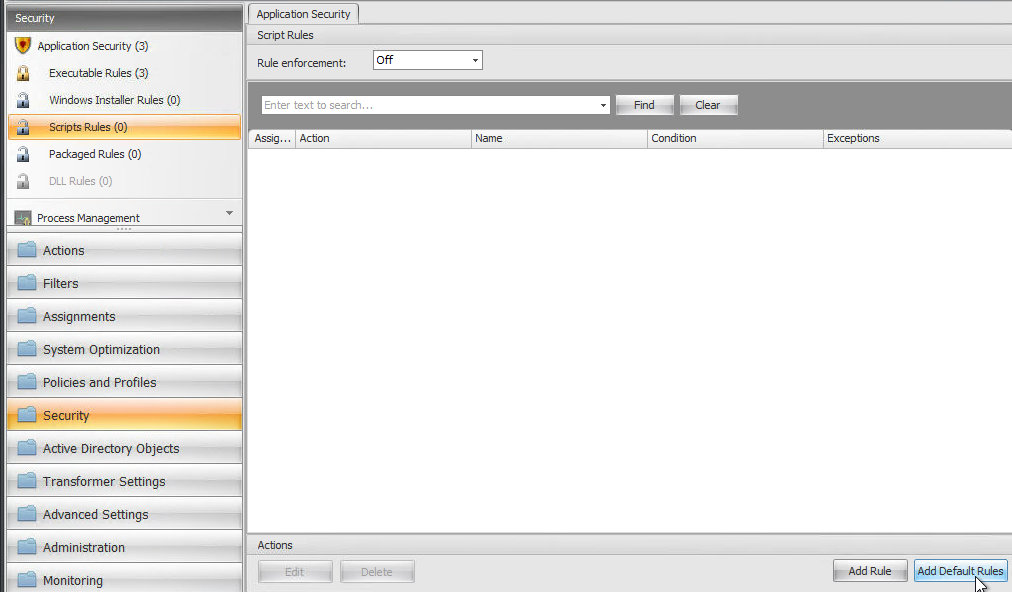
- If you click the Executable Rules sub-node, on the bottom right is a button to Add Default Rules.
- WEM 2112 and newer have a Privilege Elevation feature under the Security workspace. You might have to scroll down to find it. On the right, check the box for Process Privilege Elevation Settings. Notice the setting for Do Not Apply to Windows Server OSs.
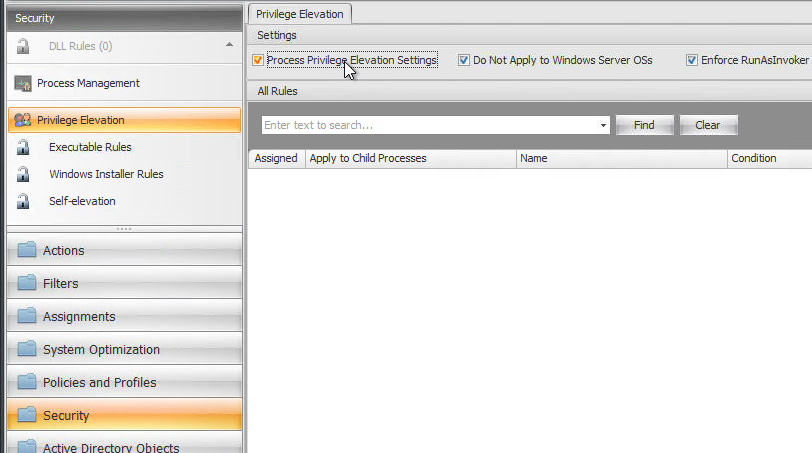
- On the left, click Executable Rules under Privilege Elevation. Then on the bottom right click Add Rule.
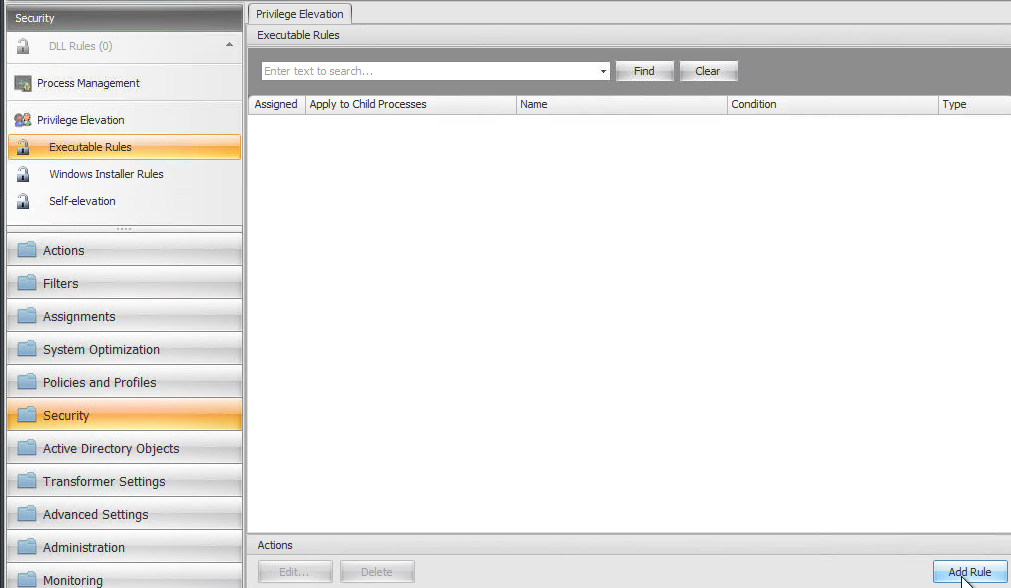
- Give the rule a name and select an assignment.
- There are options to restrict the elevation to specific parameters. For example, you can restrict cmd.exe so it can only elevate specific scripts. Click Next.
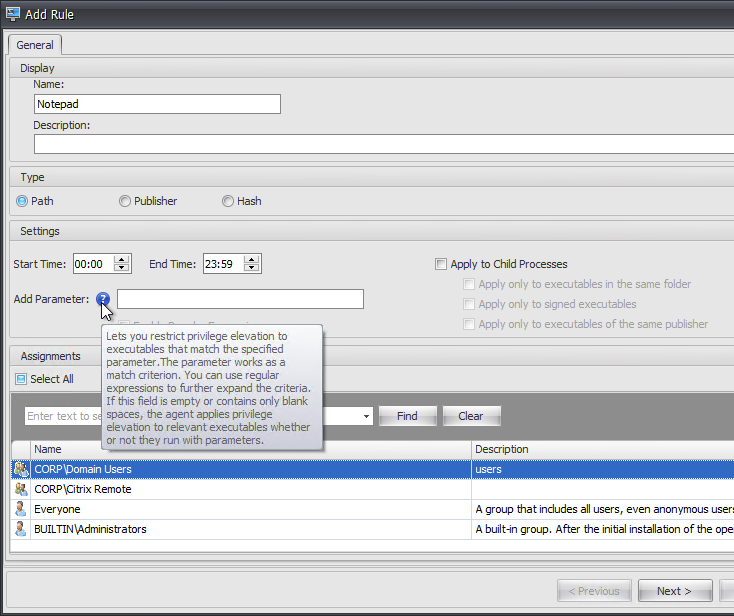
- Browse to the executable file and click Create.
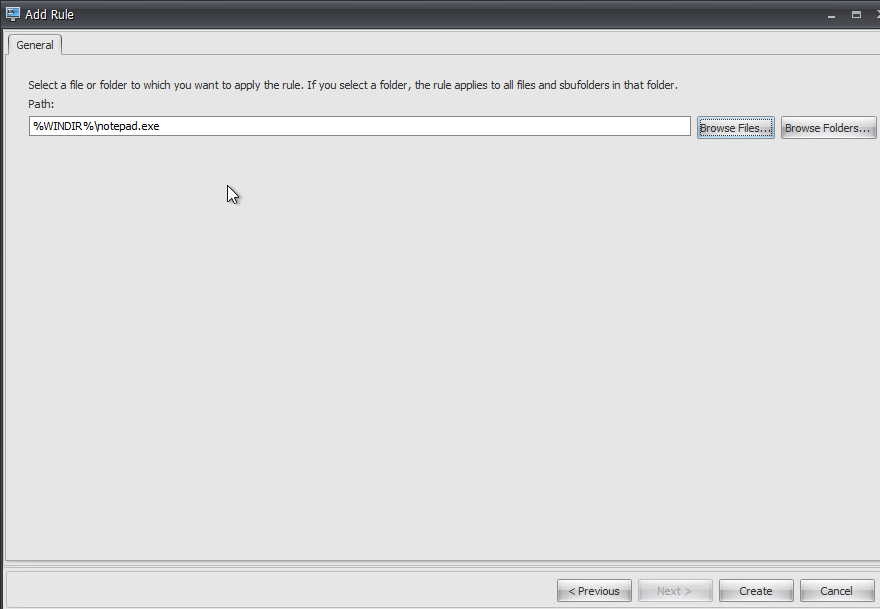
- CTP David Wilkinson has more details on this feature.
- On the left, click Executable Rules under Privilege Elevation. Then on the bottom right click Add Rule.
- WEM 2203 adds a Self-elevation feature that lets users manually run processes elevated. See Citrix Docs for details.
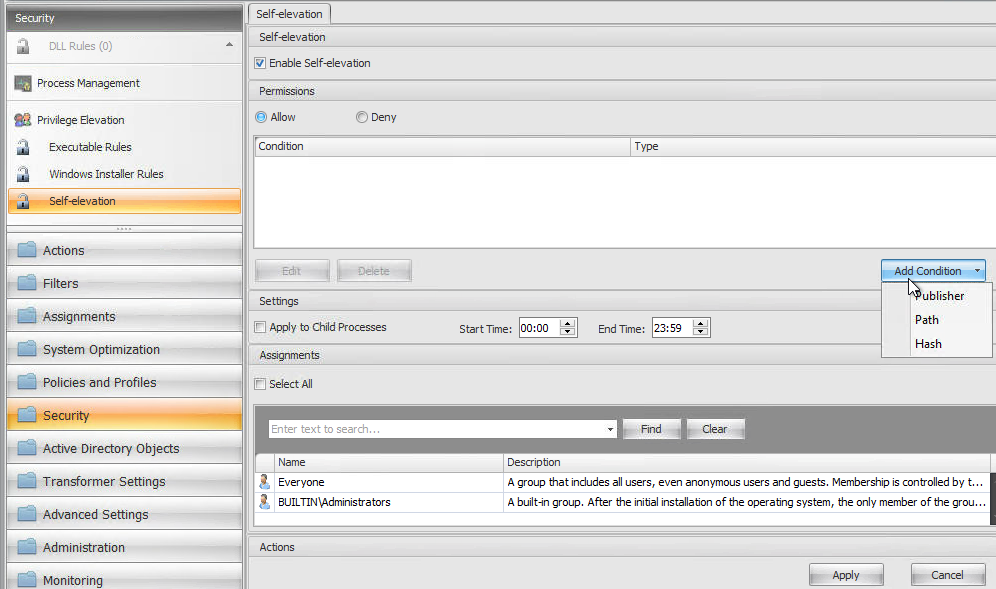
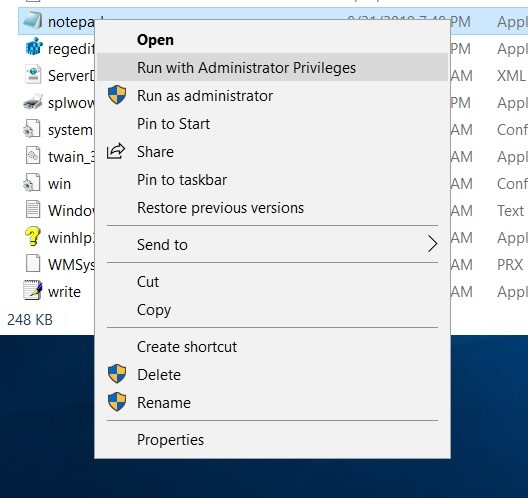
- WEM 2006 adds Process Hierarchy Control, which lets you restrict or allow a parent process from launching specific child processes. See Citrix Docs for configuration details.
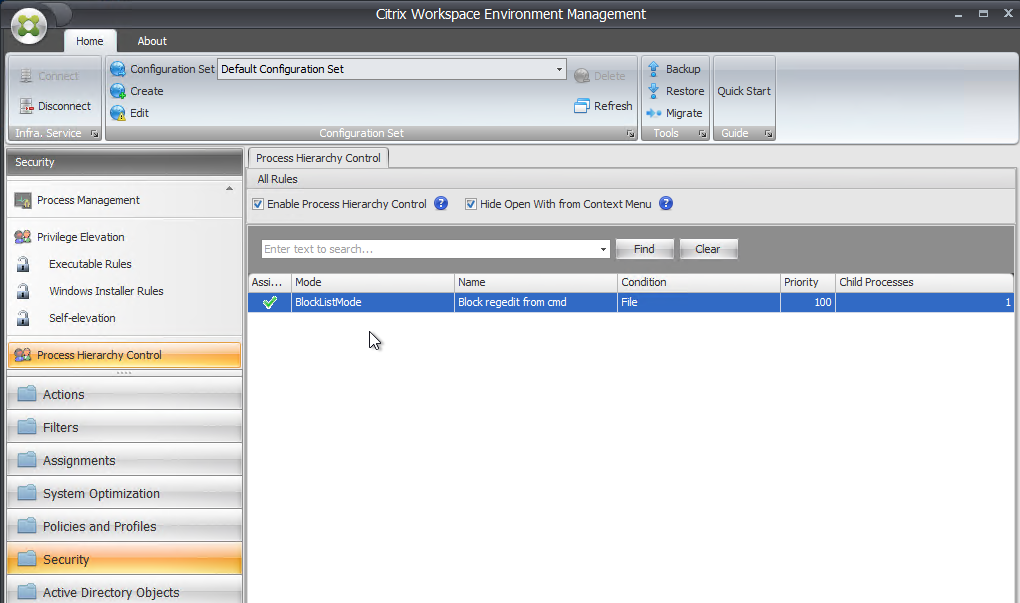
- On the agent side, you must enable Process Hierarchy Control by running elevated AppInfoViewer.exe from C:\Program Files (x86)\Citrix\Workspace Environment Management.
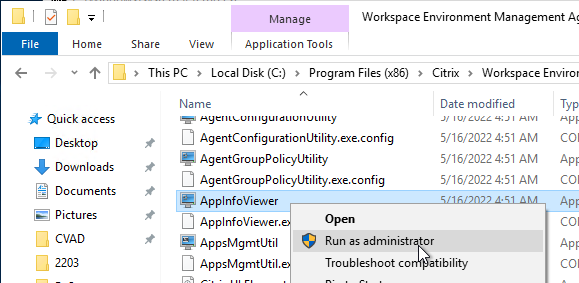
- Click Enable Process Hierarchy Control.
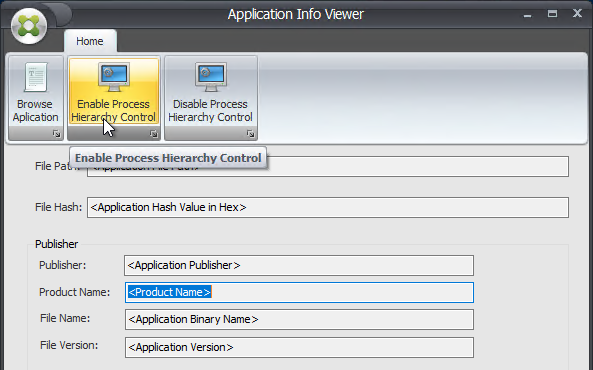
- Acknowledge that a restart is required.

- On the agent side, you must enable Process Hierarchy Control by running elevated AppInfoViewer.exe from C:\Program Files (x86)\Citrix\Workspace Environment Management.
- WEM has an audit log of the security features at Administration workspace > Logging node > Agent tab.
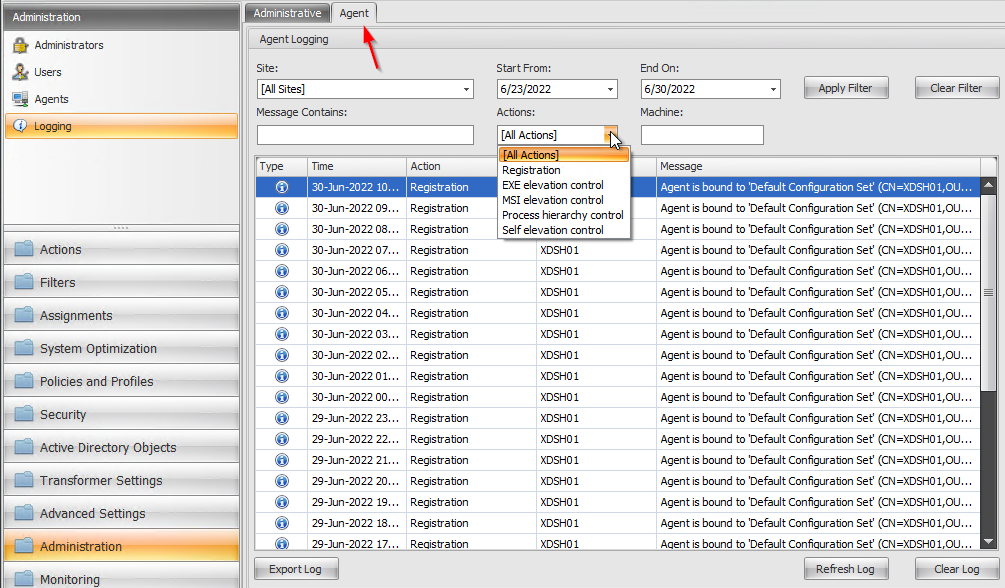
Policies and Profiles
- WEM Web Console > Profiles > Profile Management Settings lets you push Citrix Profile Management settings to WEM Agents
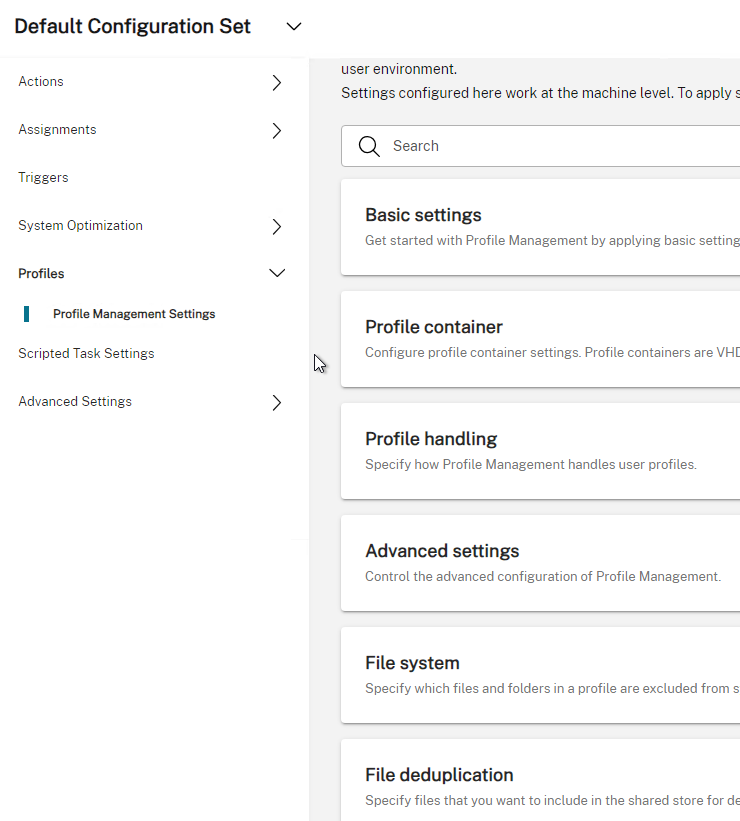
- On the top right you can click Quick setup to Start with template. Choose either File-based or Container-based.


- There’s an option to configure user-level settings instead of computer-level.

- See the Citrix Profile Management post for details on a recommended Profile Management configuration. Some of the newer settings might be missing from WEM.
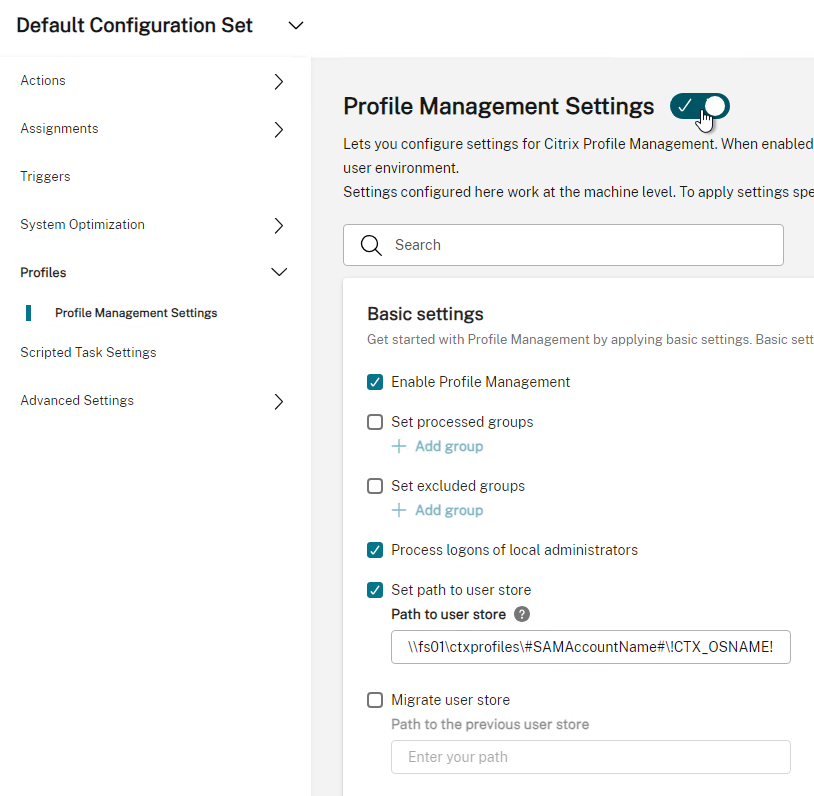
- If you use WEM to configure UPM settings, but the settings are not applying to the WEM Agent, then see Citrix CTX219086 Some UPM or WEM Agent parameters may not be applied by the agent after switching from GPO settings to Workspace Environment Management settings.
- In the WEM Classic Console, at Policies and Profiles > Citrix Profile Management Settings, in the right pane, the File System tab has a useful Profile Cleansing button to remove excluded folders from an existing UPM profile share. This function might not be necessary if you enable Logon Exclusion Check.
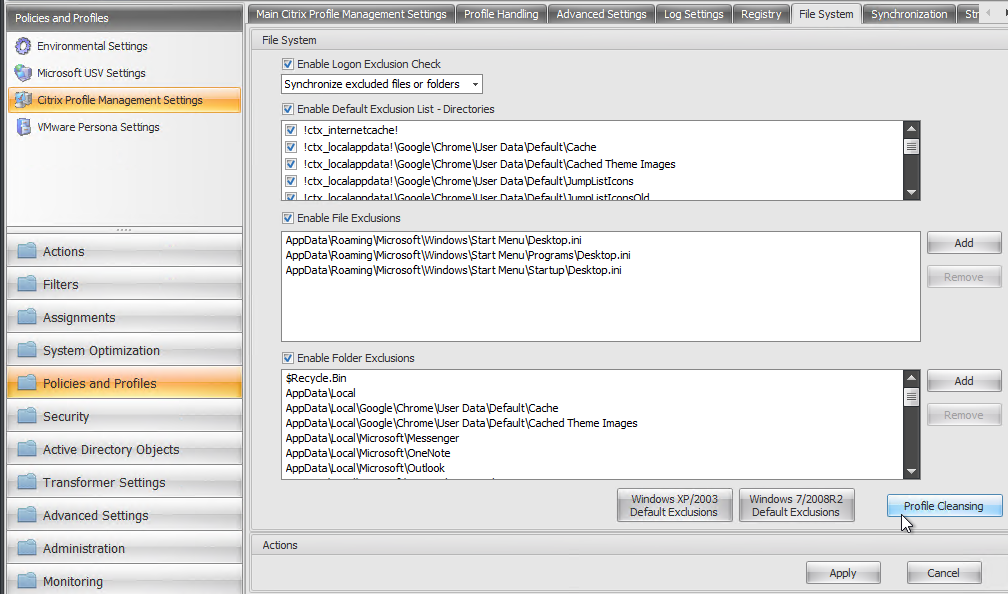
- Adjust the Profiles Root Folder, click Scan Profiles Folder, and then click Cleanse Profile(s).
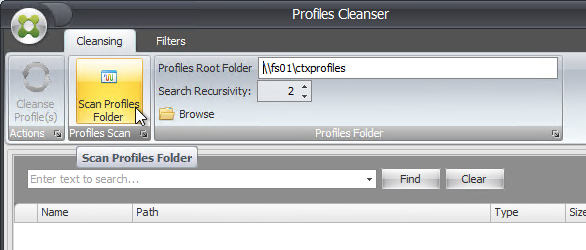
- Adjust the Profiles Root Folder, click Scan Profiles Folder, and then click Cleanse Profile(s).
- To configure folder redirection in the WEM Classic Console, on the top left, click Microsoft USV Settings.
- On the right, on the Roaming Profiles Configuration tab, check the box to Process User State Virtualization Configuration.
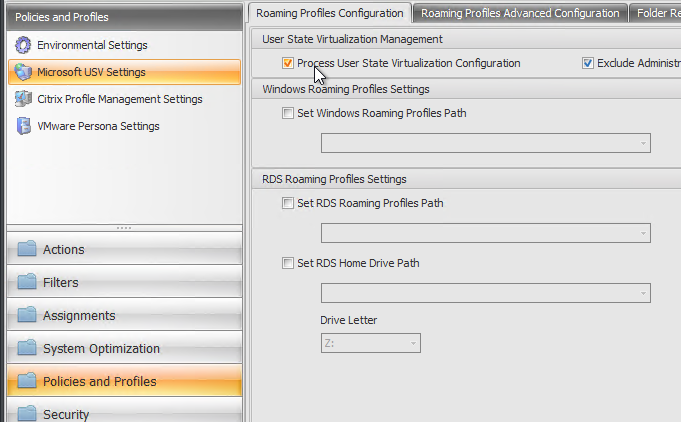
- Then switch to the Folder Redirection tabs, and configure them as desired.
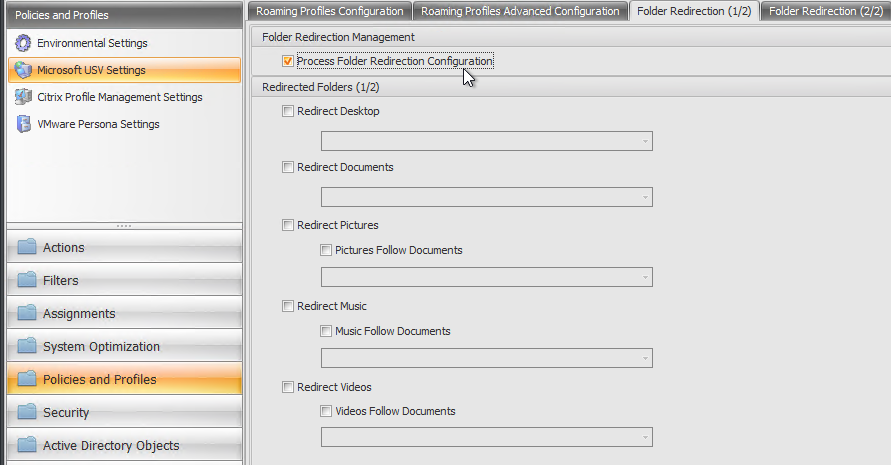
- On the right, on the Roaming Profiles Configuration tab, check the box to Process User State Virtualization Configuration.
- For Environmental Settings, WEM Classic Console has the Policies and Profiles workspace (bottom left) with three nodes on the top left.
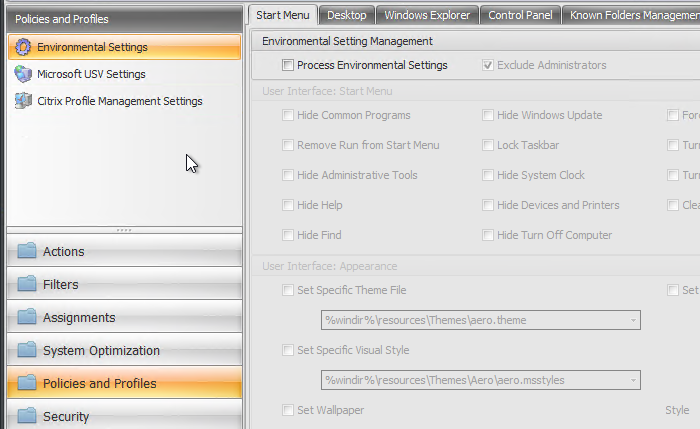
- In the Environmental Settings node (top left), in the right pane, you can enable Environmental Settings, and configure restrictions that are usually configured in group policy. Peruse the various tabs on the right. Administrators can be excluded from these restrictions. These settings are only in the WEM Classic Console. In WEM Web Console they are replaced by group policies.
- The Environmental Settings within the WEM Administration Console are per-machine, not per-user. This means that, by default, all the settings configured inside of a Configuration Set apply to every non-admin user that logs into that particular Agent machine. In order to have different Environmental Settings apply to different users/user groups, they would need to be applied to a separate WEM Agent machine, and all the settings would need to be configured inside a separate Configuration Set to which the WEM Agent Machine is bound. Source = CTX226487 Guidance on configuring WEM settings per user/user groups.
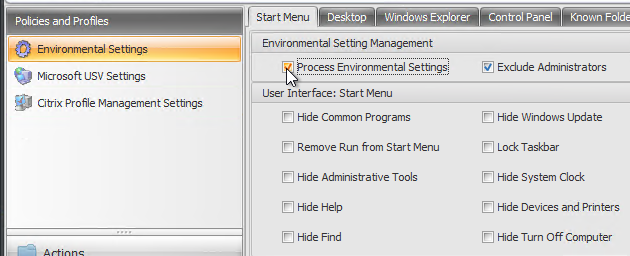
Scripted Tasks
Web Console lets you configure Scripted Tasks that run at the agent (computer) level.
- First, add the task/script to Scripted Tasks at the global le
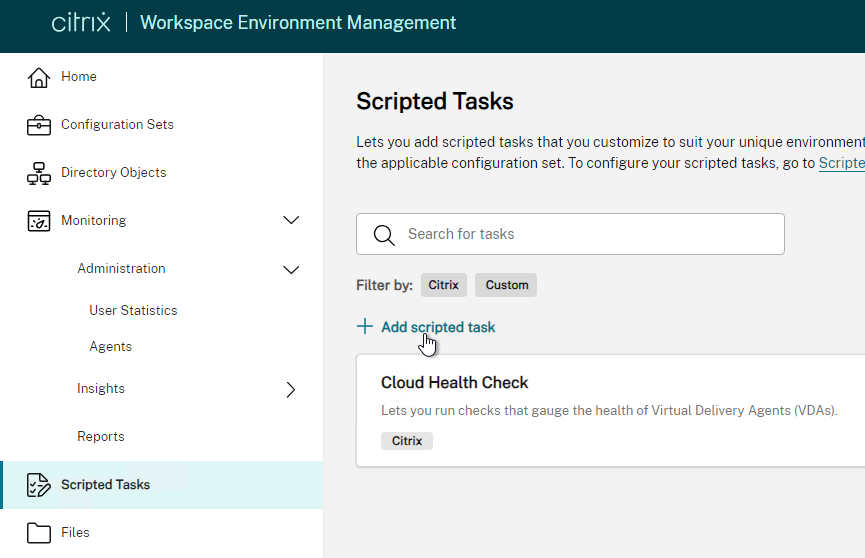
- Scripted tasks are PowerShell scripts.
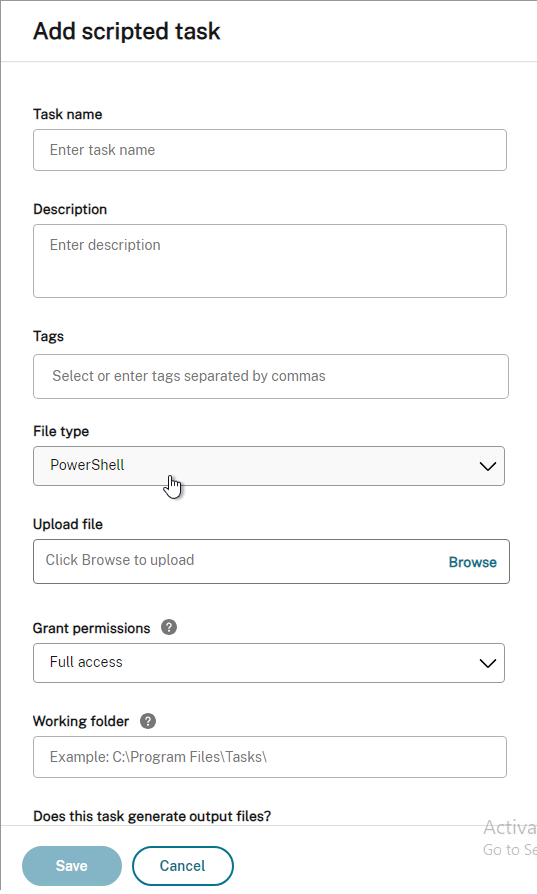
- Scripted tasks are PowerShell scripts.
- Then go to a Configuration Set and click Scripted Task Settings.
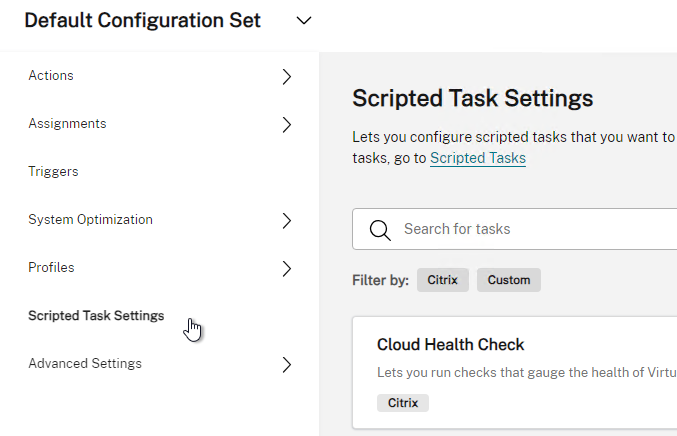
- On the far right, click the … next to a scripted task and then click Configure.
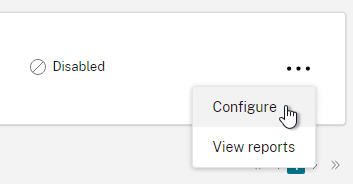
- Enable the task and choose a Filter.
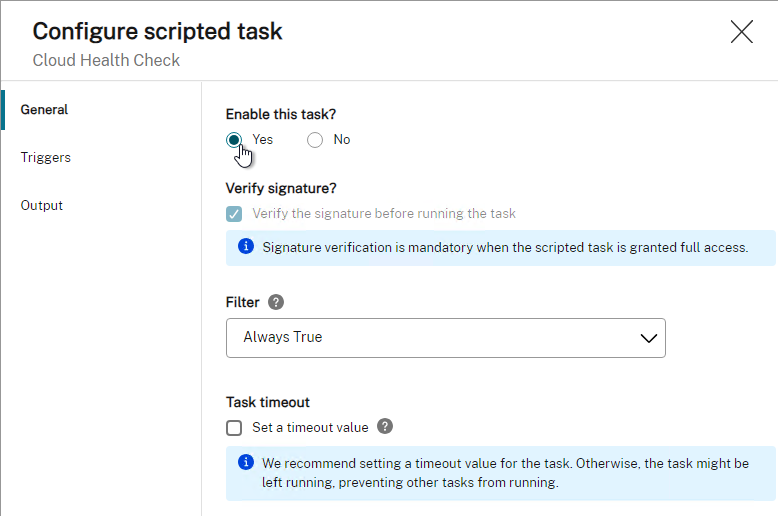
- The Triggers page lets you choose when the script should run. You can Create new trigger.
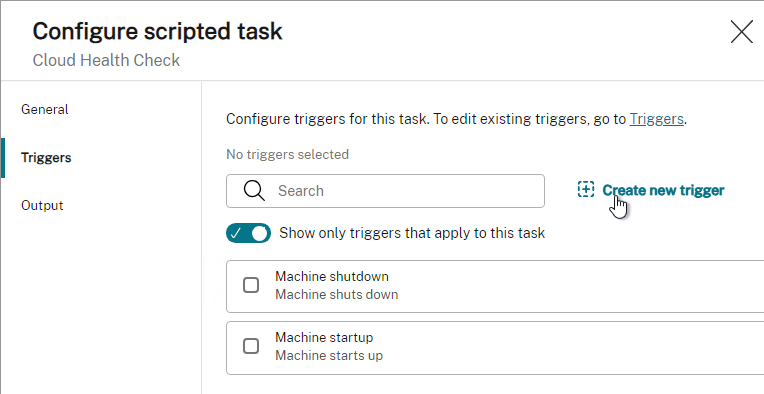
- One of the options is Scheduled.

WEM Agent Group Policy
- In the WEM Download, go to the \Workspace-Environment-Management-v-2411-01-100-01\Agent Group Policies\ADMX folder.
- Copy the .admx file, and the en-US folder to the clipboard.

- Go \\MyADDomain.com\sysvol\MyADDomain.com\Policies.
- If you have a PolicyDefinitions folder here, then paste the .admx file and folder.
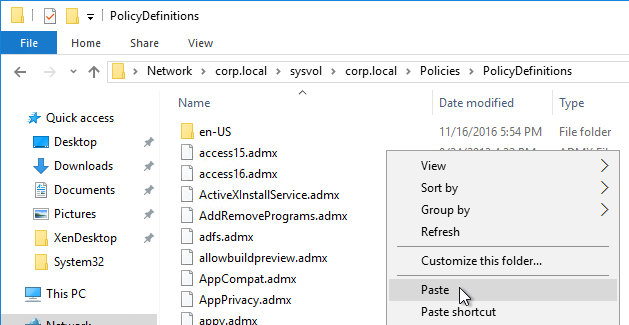
- If you don’t have PolicyDefinitions in Sysvol, then instead go to C:\Windows\PolicyDefinitions, and paste the .admx file and folder there.
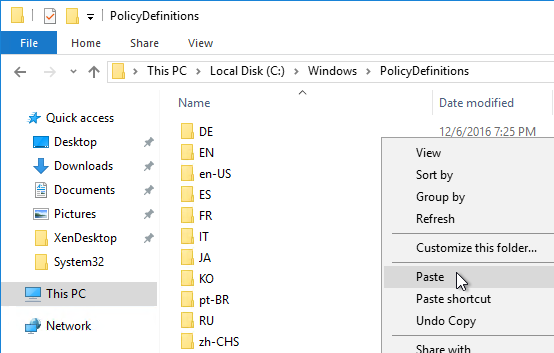
- If you don’t have PolicyDefinitions in Sysvol, then instead go to C:\Windows\PolicyDefinitions, and paste the .admx file and folder there.
- Look for older versions of the WEM .admx and .adml files (in the en-us subfolder) and delete them. Remove any WEM .admx and .adml files that have a version number.
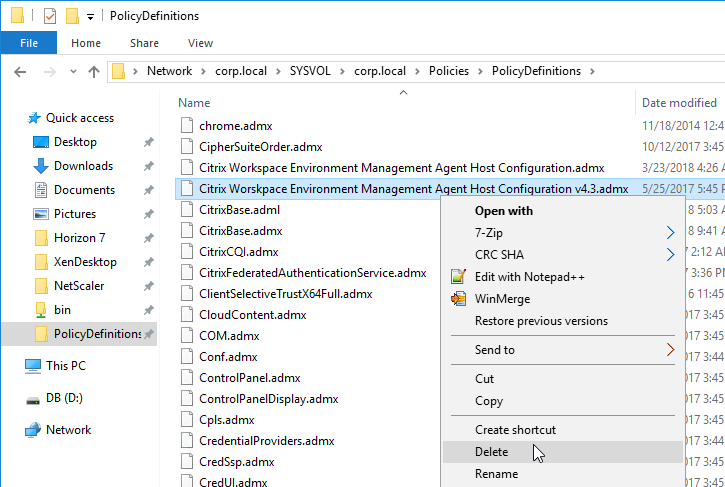
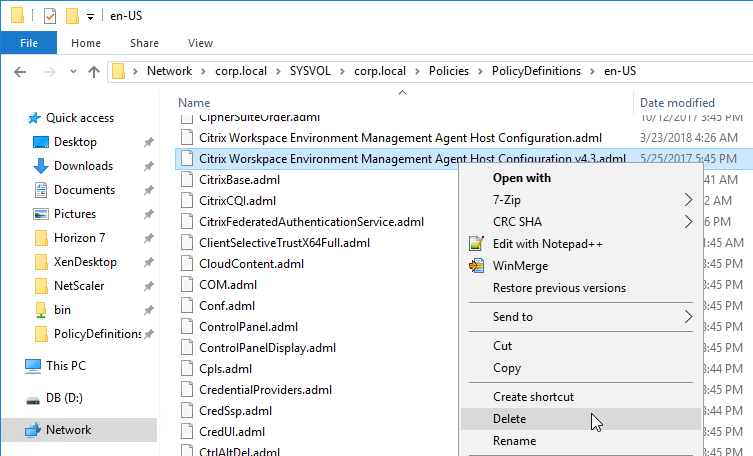
- Edit a GPO that applies to the VDAs that will run the WEM Agent.
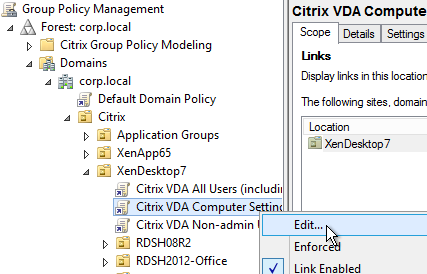
- In WEM 1906 and newer, go to Computer Configuration | Policies | Administrative Templates | Citrix Components | Workspace Environment Management | Agent Host Configuration.
- On the right, double-click Infrastructure server.
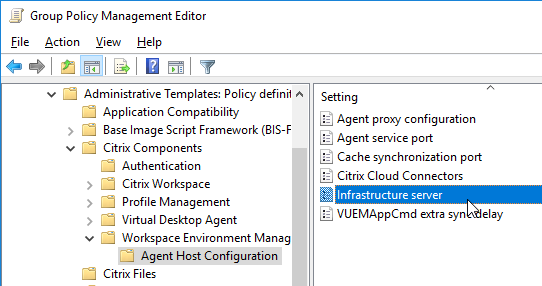
- Enable the setting, enter the FQDN of the WEM server (or load balanced name), and click OK. Note: It must be FQDN.
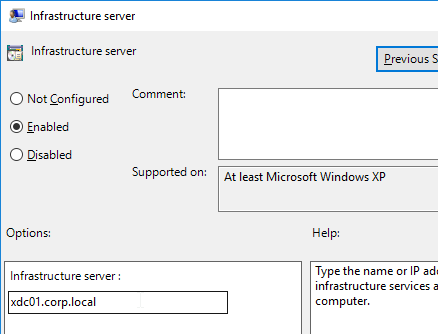
- Assign Agents to a Configuration Set.
- In the WEM Web Console, go to Directory Objects and click Add object.
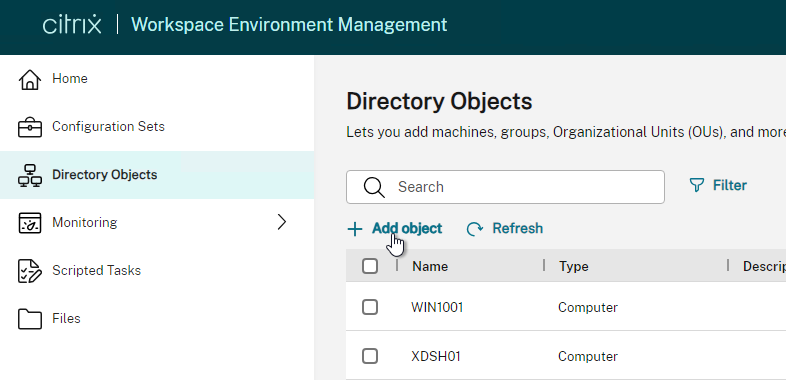
- In the WEM Classic Administration Console, choose a Configuration Set and then go to Active Directory Objects workspace (bottom left) > Machines node (top left), and in the right pane, add an OU or individual machines.

- In the WEM Web Console, go to Directory Objects and click Add object.
- It’s possible that an Agent might register with multiple Configuration sets. You can review the registrations in Web Console at Monitoring > Administration > Agents.
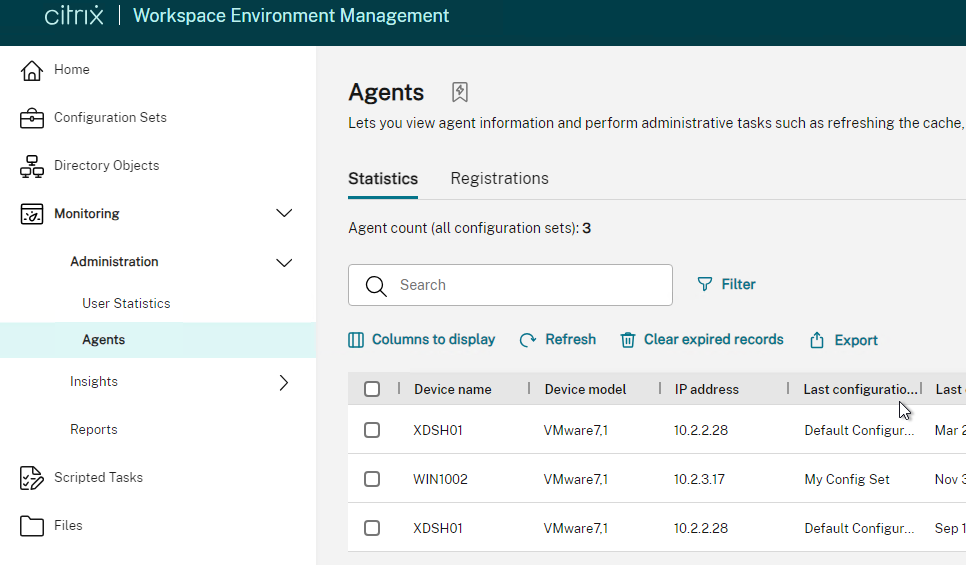
- Registrations tab (right pane) might show you Agents not registered with any Configuration Set. Add the Agent to Active Directory Objects > Machines.

- Registrations tab (right pane) might show you Agents not registered with any Configuration Set. Add the Agent to Active Directory Objects > Machines.
Install/Upgrade WEM Agent
For command line unattended installation of WEM Agent, see Alain Assaf at Citrix Discussions.
- WEM agent upgrade task – WEM 2311 and newer can push Agent upgrades to existing agents. In a Configuration Set, configure a file share under App Package Delivery. Then import the WEM Agent to the share. Then create a Delivery task. More details at App Package Delivery at Citrix Docs.


- If App Layering, Citrix recommends installing the WEM Agent in the Platform Layer.
- If you are installing the WEM Agent in a App Layer, see George Spiers to workaround an issue with the Netlogon service in a Platform Layer that has the Provisioning Services Target Device software installed.
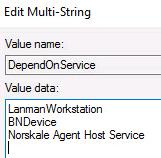
- If you are installing the WEM Agent in a App Layer, see George Spiers to workaround an issue with the Netlogon service in a Platform Layer that has the Provisioning Services Target Device software installed.
- Use registry editor to confirm that the WEM GPO has applied to the Agent machine. Look for HKEY_LOCAL_MACHINE\SOFTWARE\Policies\Norskale\Agent Host\BrokerSvcName.
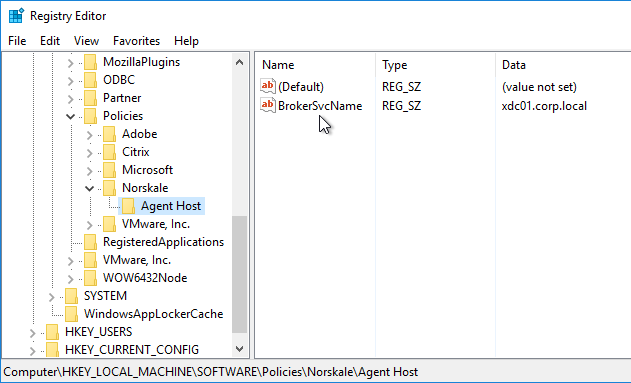
- VDA installer – In VDA 2012 and newer, the WEM Agent is included with the VDA installer; however, this install method has been deprecated. You can instead install it separately as detailed in the next step.
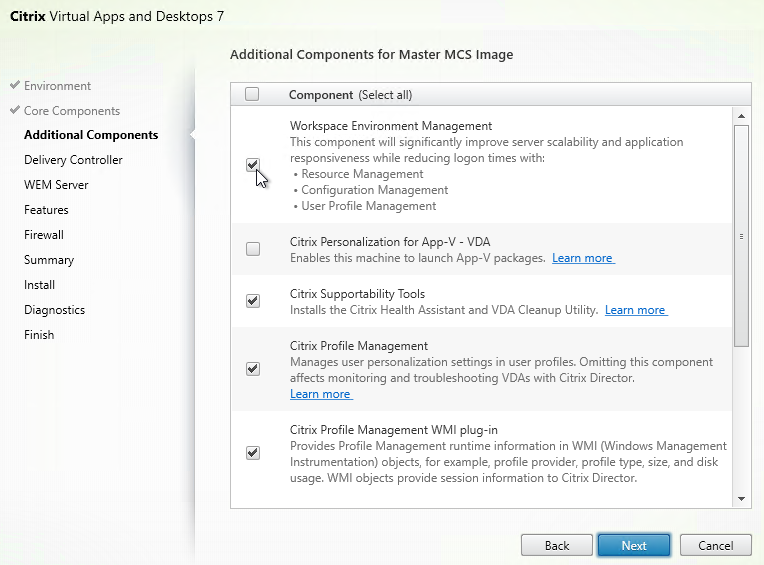
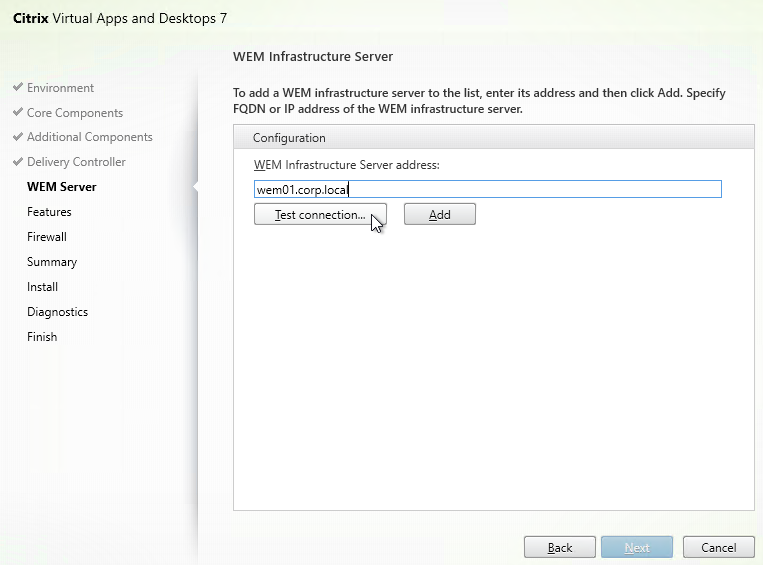
- Manual install – On a VDA Master machine, run Citrix Workspace Environment Management Agent.exe from the downloaded WEM 2411 (aka 2411-01-100-01) installation files.

- In the Citrix Workspace Environment Management Agent window, check the box next to I agree to the license terms and click Install.

- In the Welcome to the Citrix Workspace Environment Management Agent Setup Wizard page, click Next.
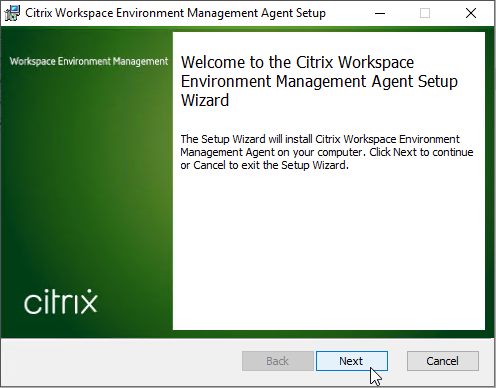
- In the Destination Folder page, click Next.
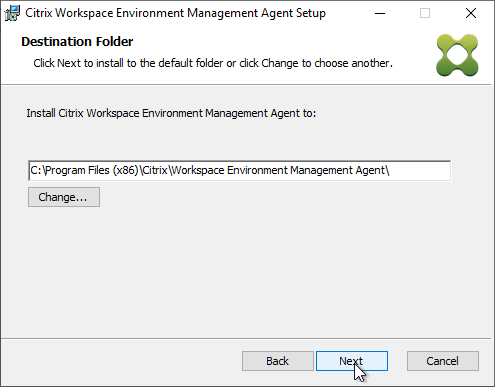
- In the Deployment Type page, select On-premises Deployment and click Next. Basic Deployment in WEM 2407 and newer does not need any infrastructure. See Citrix Docs.

- In the Infrastructure Service Configuration page, change the selection to Skip Configuration since you’ve already configured the group policy. Click Next. Note: In WEM 1912 and newer, the cache synchronization port changes from 8285 to 8288.
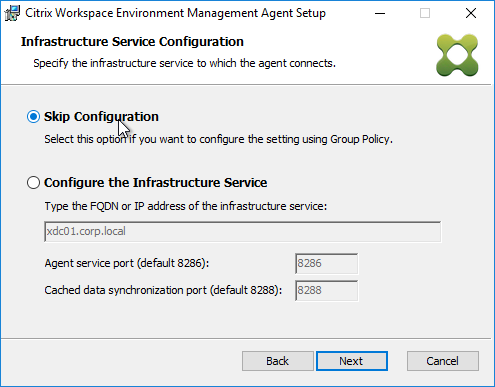
- In the Advanced Settings page, if this machine will be used with Citrix Provisioning and has a Provisioning cache disk, then you can optionally move the WEM Cache to the Provisioning cache disk. Click Next. WEM Agent 2012 and newer have some enhancements for non-persistent machines. See Prerequisites and recommendations and Agent startup behaviors at Citrix Docs.
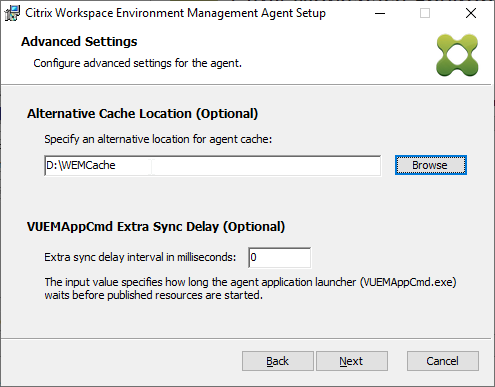
- In the Ready to install Citrix Workspace Environment Management Agent page, click Install.
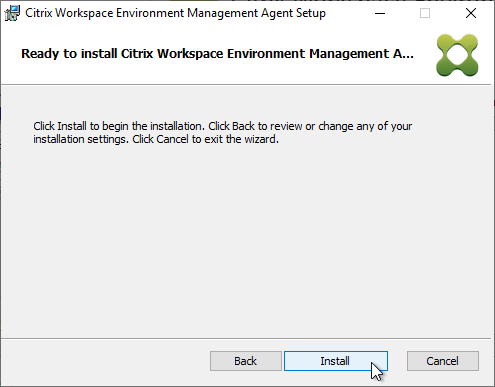
- In the Completed the Citrix Workspace Environment Management Agent Setup Wizard page, click Finish.
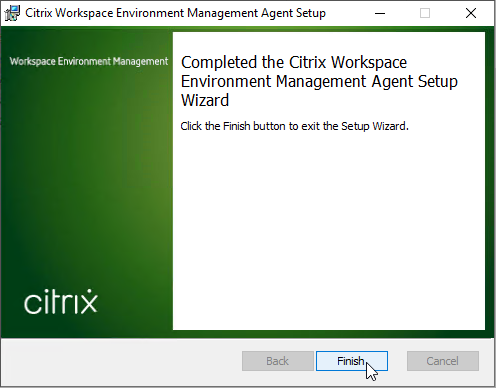
- In the Installation Successfully Completed window, click Close.
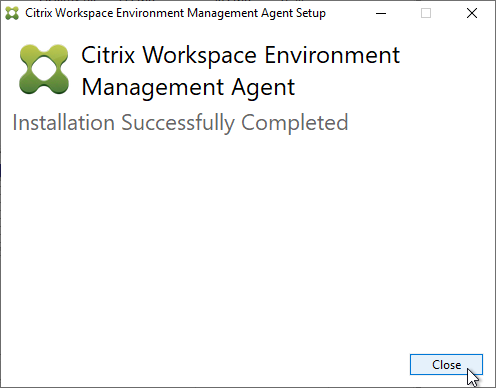
WEM Agent Cache
- After installation, check the registry under HKLM\System\CurrentControlSet\Control\Norskale\Agent Host to verify your command line switches applied correctly.
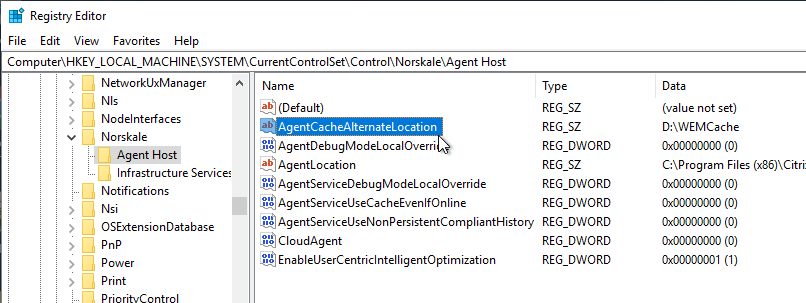
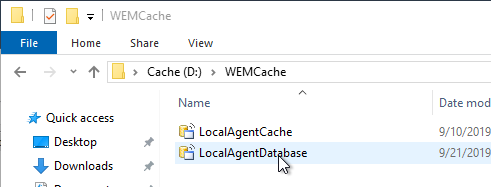
- WEM Agent 2012 and newer have some enhancements for non-persistent machines. See Prerequisites and recommendations and Agent startup behaviors at Citrix Docs.
- In WEM Agent 1909 and newer, the WEM Agent installation path is now C:\Program Files (x86)\Citrix\Workspace Environment Management Agent instead of C:\Program Files (x86)\Norskale\Norskale Agent Host and you might have to modify your WEM Agent Cache Refresh scripts with the new path. See CTP James Kindon Citrix WEM Updated Start-Up Scripts for more details.
- Optionally, you can pre-build the Agent Cache by running AgentCacheUtility.exe, which is located in C:\Program Files (x86)\Citrix\Workspace Environment Management Agent (fresh WEM Agent 1909 and newer) or in C:\Program Files (x86)\Norskale\Norskale Agent Host.
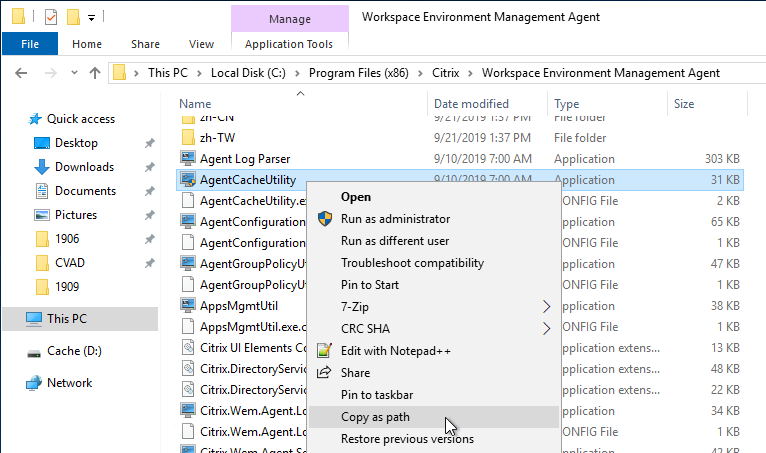
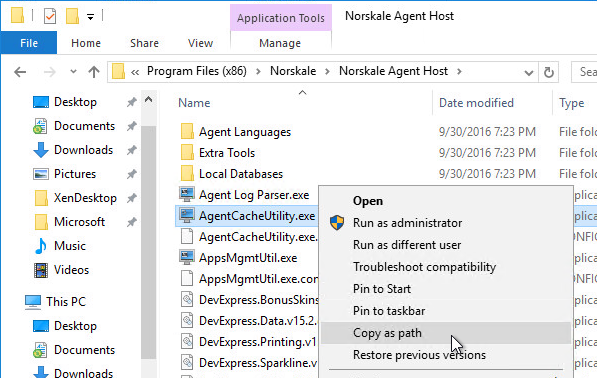
- It needs the following switches:
-refreshcache -brokername:MyWEMServer - From Hal Lange: “AgentCacheUtility does except short values (Eg AgentCacheUtility -r -b:) the broker name should always be in FQDN since this does use Kerberos for the authentication.”
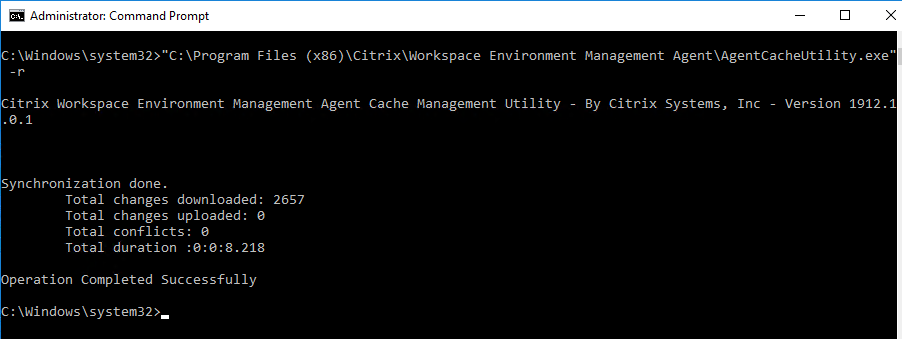
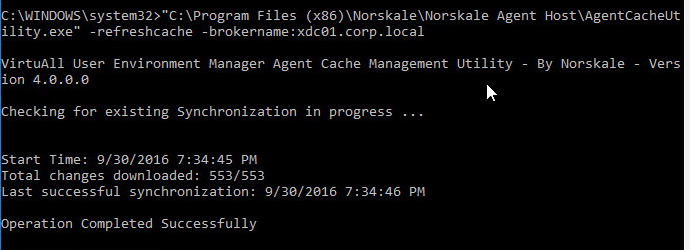
- You can also use the Web Console at Monitoring > Administration > Agents to refresh an agent’s cache and perform other actions. The Synchronization column indicates if the cache is up to date or not. It takes a few minutes to update.
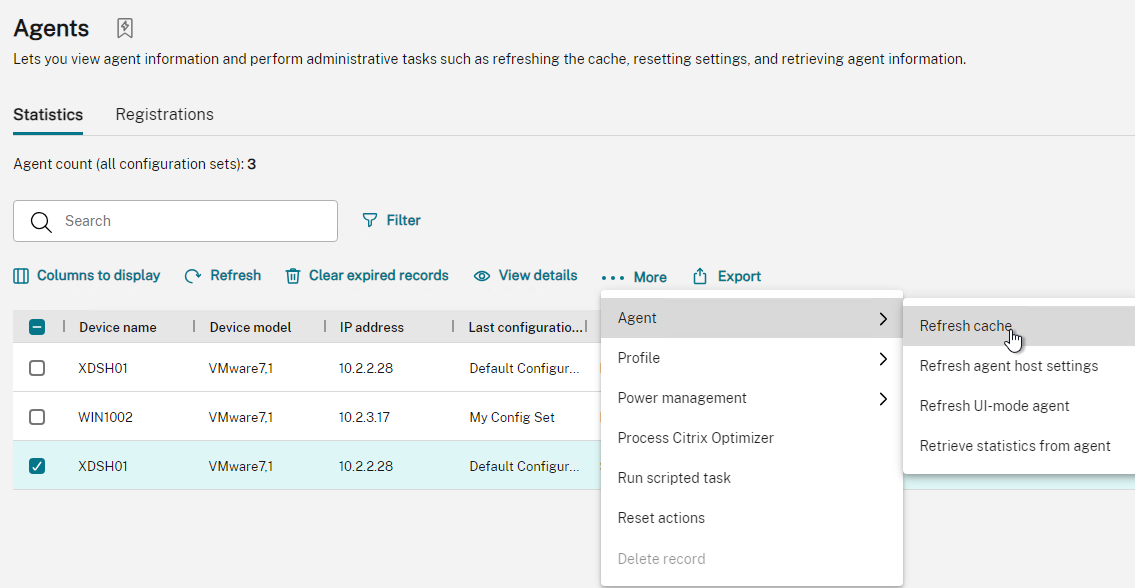
- It’s also in WEM Classic Administration Console at Administration workspace (bottom left), Agents node (top left)
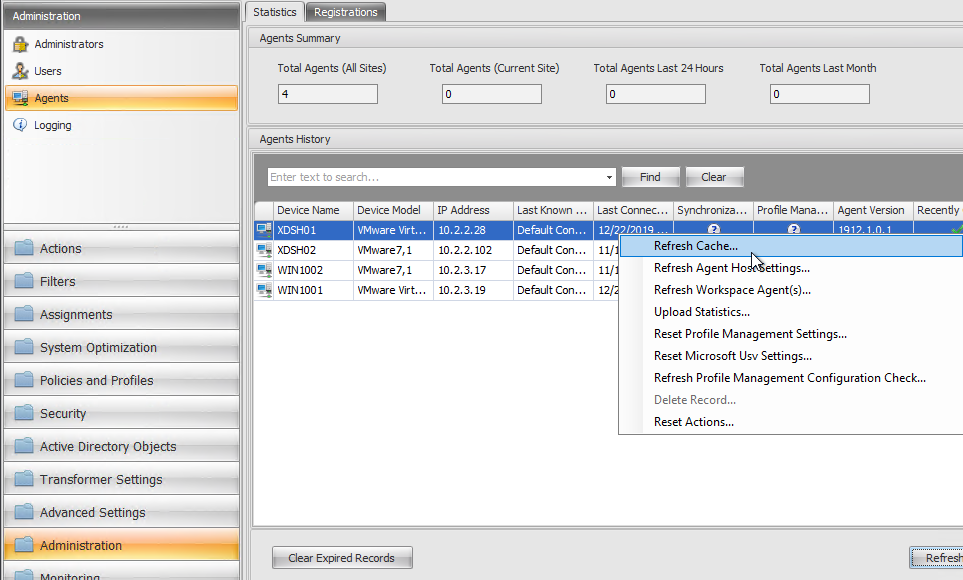
- It’s also in WEM Classic Administration Console at Administration workspace (bottom left), Agents node (top left)
- From Hal Lange: “Need to optimize the client by running ngen for .NET optimizations in the x64 and x86 directories. These commands will help optimize ANY .NET application installed on the system
C:\Windows\Microsoft.NET\Framework\v4.0.30319 C:\Windows\Microsoft.NET\Framework64\v4.0.30319 ngen.exe update ngen.exe eqi 1 ngen.exe eqi 3
- Antivirus – C:\Program Files (x86)\Citrix\Workspace Environment Management Agent or C:\Program Files (x86)\Norskale\Norskale Agent Host must be excluded from Antivirus scanning. Or exclude Citrix.Wem.Agent.Service.exe; Norskale Agent Host Service.exe; VUEMUIAgent.exe; Agent Log Parser.exe; AgentCacheUtility.exe; AppsMgmtUtil.exe; PrnsMgmtUtil.exe; VUEMAppCmd.exe; VUEMAppCmdDbg.exe; VUEMAppHide.exe; VUEMCmdAgent.exe; VUEMMaintMsg.exe; VUEMRSAV.exe.
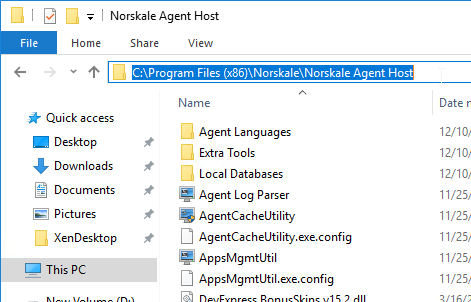
- If you use WEM to push UPM settings, but the settings are not applying to the WEM Agent, then see Citrix CTX219086 Some UPM or WEM Agent parameters may not be applied by the agent after switching from GPO settings to Workspace Environment Management settings. Delete the machine cache, which is at the following registry location:
HKEY_LOCAL_MACHINE\SYSTEM\CurrentControlSet\Control\Norskale\Agent Host\UsvMachineConfigurationSettings HKEY_LOCAL_MACHINE\SYSTEM\CurrentControlSet\Control\Norskale\Agent Host\UpmConfigurationSettings
This will force WEM to re-apply the per-machine settings (Microsoft USV or Citrix UPM settings, respectively).
- WEM Cache tends to break often. See CTP James Kindon Citrix WEM Cache Problems…. Again for a script to reset the cache periodically.
- CTP James Kindon describes the WEM Client Side Tools including: Log Parser, Resultant Actions Viewer, VUEMAppCMD, Manage Printers, Manage Applications, and Help Desk Tools.
- WEM Agent 2308 and newer have improved Event Viewer logging.
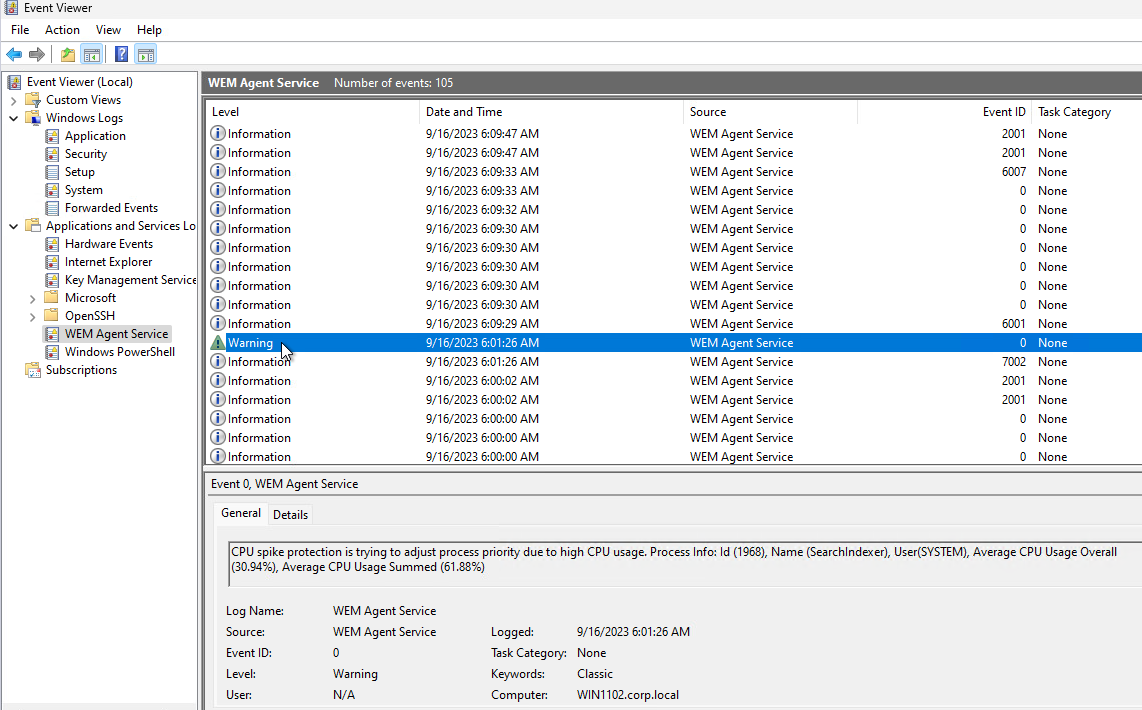
WEM Agent on Citrix Provisioning Target Device
From Citrix Discussions: create a computer startup script that deletes the WEM cache and refreshes it:
net stop "Citrix WEM Agent Host Service" /y net stop "Norskale Agent Host Service" /y del D:\WEMCache\ /S /F /q net start "Citrix WEM Agent Host Service" net start "Norskale Agent Host Service" net start "Netlogon" timeout /T 45 /nobreak "C:\Program Files (x86)\Citrix\Workspace Environment Management Agent\AgentCacheUtility.exe" -refreshcache -brokername:XXXX "C:\Program Files (x86)\Norskale\Norskale Agent Host\AgentCacheUtility.exe" -refreshCache -brokerName:XXXX
From Julian Mooren Citrix Workspace Environment Management with PVS – Synchronization State “Unknown”: For Citrix Provisioning, schedule a task to run the following commands at Target Device boot (Trigger = At Startup).
"C:\Program Files (x86)\Citrix\Workspace Environment Management Agent\AgentCacheUtility.exe" -refreshcache "C:\Program Files (x86)\Norskale\Norskale Agent Host\AgentCacheUtility.exe" -refreshcache
From CTA David Ott at Using Citrix Workspace Environment Management to Redirect Folders via Symbolic Links – Speed Up Logon: before shutting down your maintenance/private mode vdisk to re-seal, kill the Citrix WEM Agent Host Service or Norskale Agent Host Service. For whatever reason if you don’t do this it can cause your vms in standard mode to take an obscenely long time to shutdown.
Base Image Script Framework (BIS-F) automates many image sealing tasks, including tasks for Workspace Environment Management. The script is configurable using Group Policy.
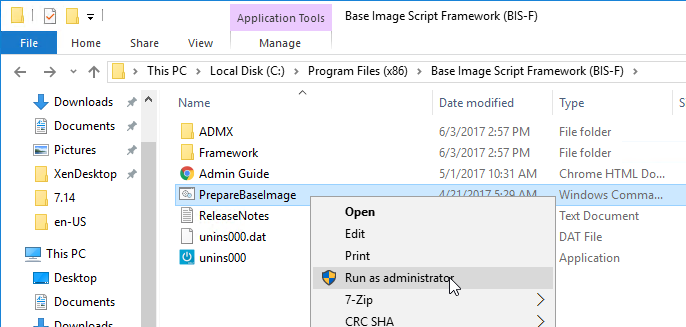
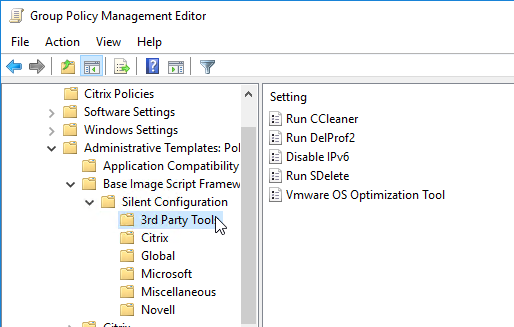
Monitoring
- WEM Web Console > Monitoring > Insights has some reporting, including a report showing disk space consumed by profile containers.
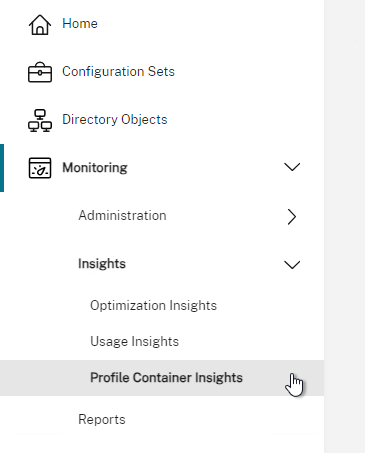
- In the WEM Classic Administration Console, the Monitoring workspace (bottom left) lets you see Logon Time and Boot Time reports.
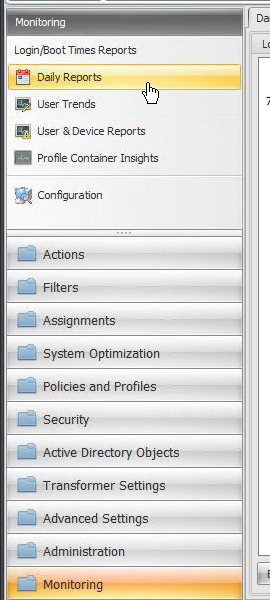
- Double-click a category to see more info.
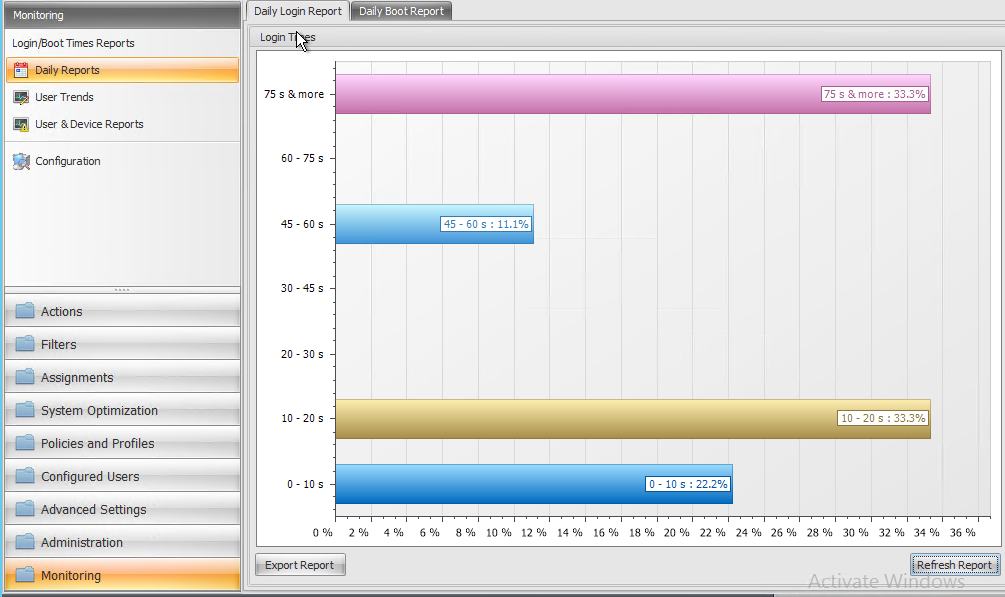

- Configuration node (top left) lets you configure Work Days Filtering for Login/Boot Time Reports.
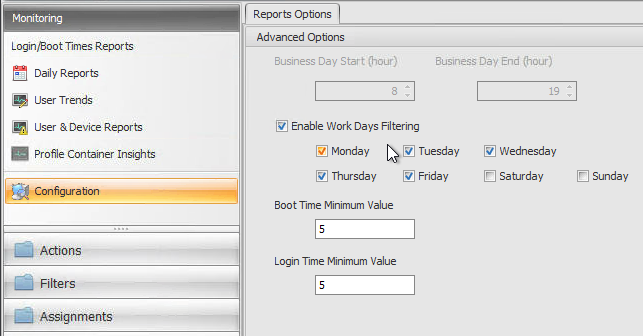
- WEM 2203 adds a Profile Container Insights report for both FSLogix and UPM Profile Containers.
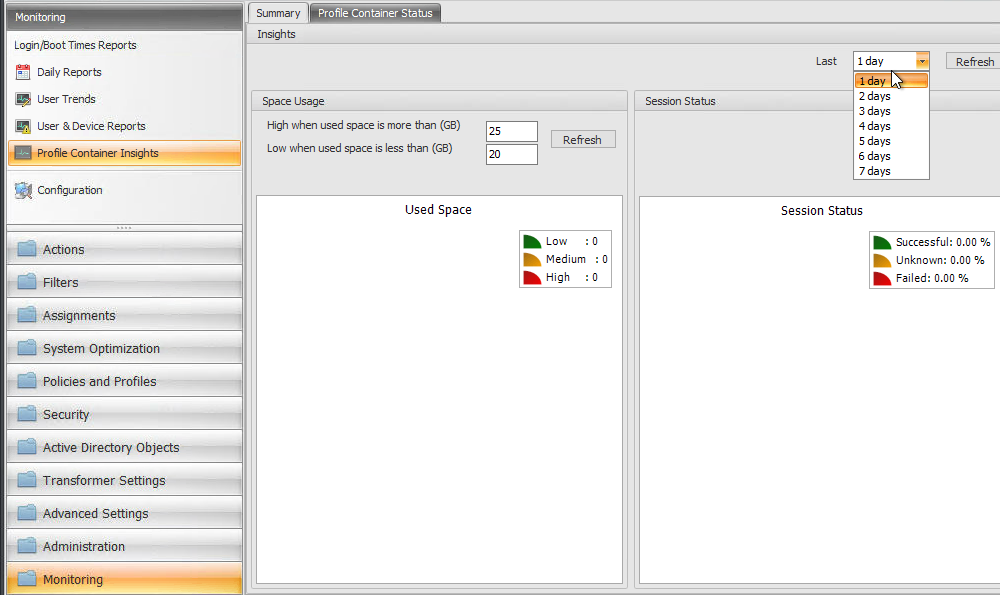
- When you make changes in the console, if agents are already installed, you can right-click the agent icon (by the clock), and Refresh.
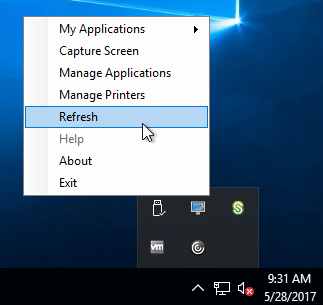
- You can also go to the Administration workspace (bottom left) > Agents node (top left). In the right pane, right-click one or more Agents, and click the Refresh options.
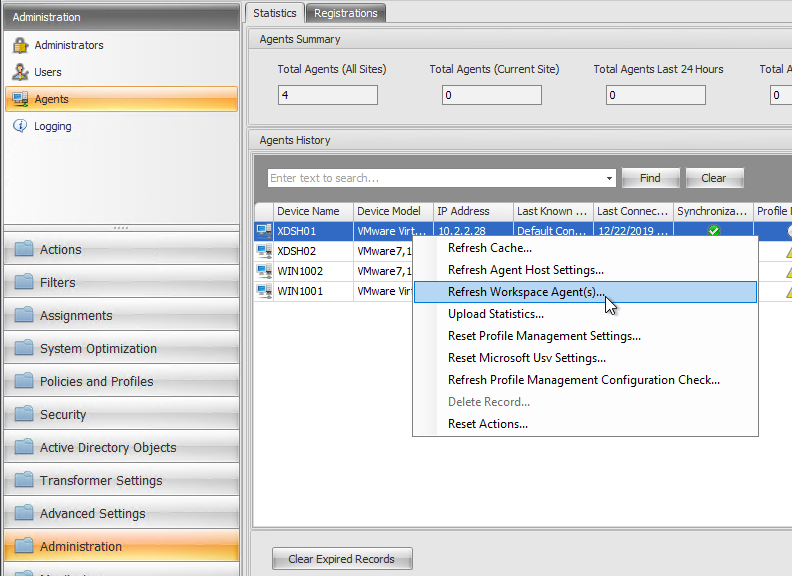
- WEM 1811 and newer periodically run UPMConfigCheck every day, or whenever the Norskale Agent Service restarts. The Administration > Agents node in the WEM Console has a visual indicator of the UPMConfigCheck results. For status details, check the file C:\Windows\Temp\UPMConfigCheckOutput.xml on each WEM Agent Machine.
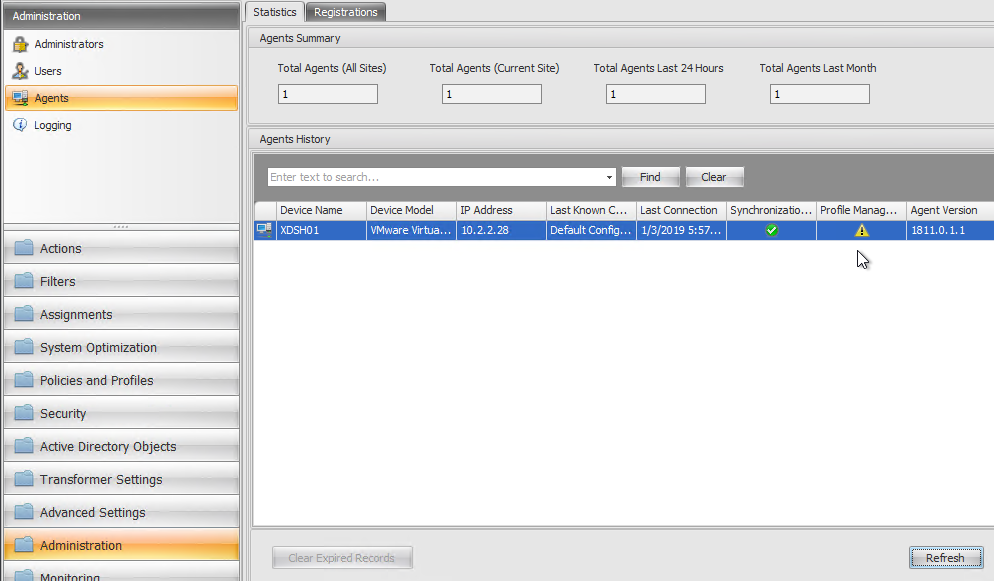
WEM Actions Configuration
WEM Actions are similar to Group Policy Preferences.
The general process is as follows:
- Create the Actions
- Optionally create Action Groups
- Add AD user groups to the WEM Console.
- Assign Actions or Action Groups to user groups. Use Conditions and Rules to perform the Action (or Action Group) for only a subset of machines or users in the user group.
Create Actions
- WEM Tool Hub 2411 has a new tool for Group Policy Migration. More details at Citrix Docs.



- In the WEM Console, use the Actions workspace to map drives, map printers, create shortcuts (Applications), set registry keys, etc. Each Action type is a separate node. New features (e.g., group policy templates, JSON Files, INI files, Ports, User DSNs) are only available in the Web Console.

- WEM 1909 and newer can Migrate or Import your Group Policies to WEM. CTP James Kindon at Migrating GPO settings to WEM explains this feature in detail.
- In Group Policy Management Console, back up the GPOs that you want to import to WEM.
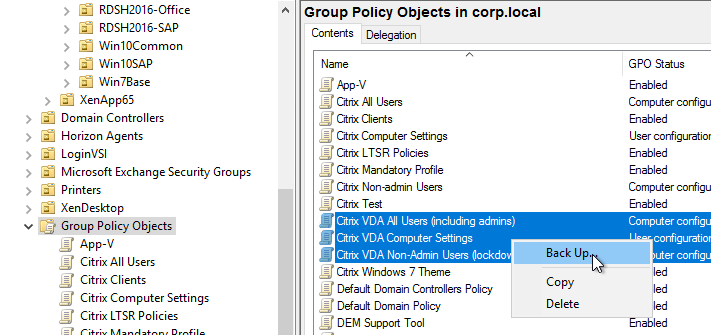
- Go to the GPO Backup folder and zip everything.
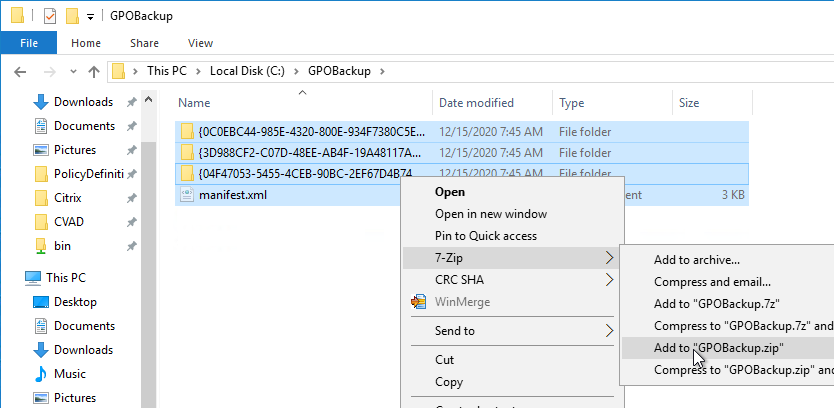
- In WEM Console, go to Actions > Group Policy Settings and click Import.

- WEM 2209 and newer let you Import Registry File.
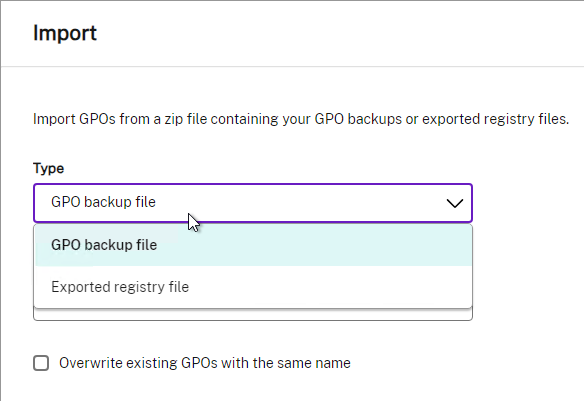
- WEM 2012 and newer let you edit the imported group policies.
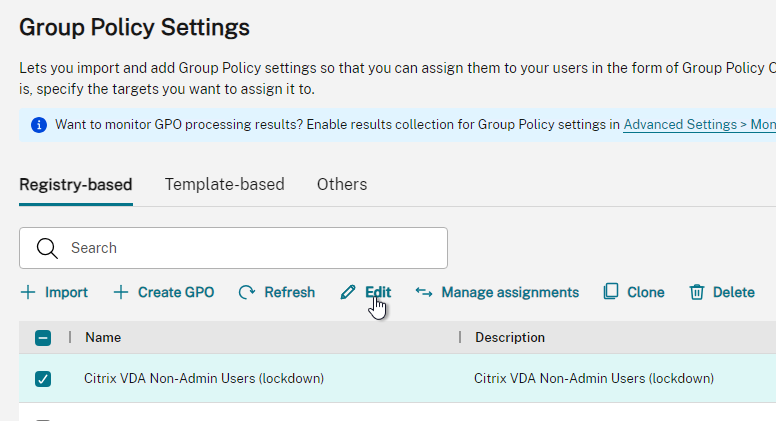
- It seems to be a registry editor that doesn’t use ADMX templates.
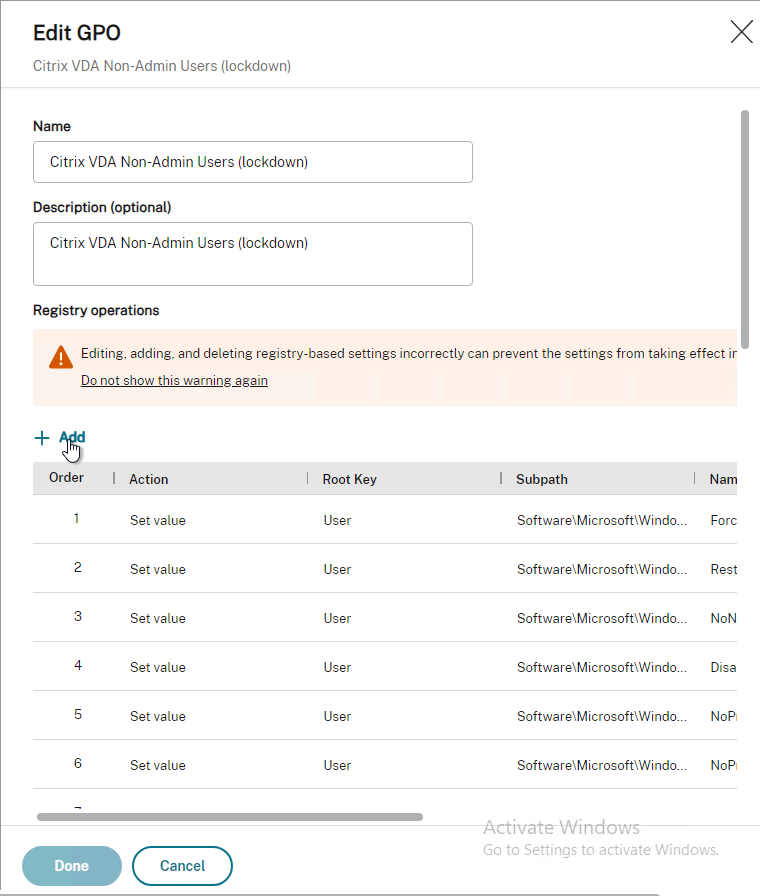
- In Group Policy Management Console, back up the GPOs that you want to import to WEM.
- WEM Web Console lets you configure GPOs using traditional ADMX templates. Switch to the Template-based tab. Standard Windows templates are already built into the Web Console, but you can upload more templates.
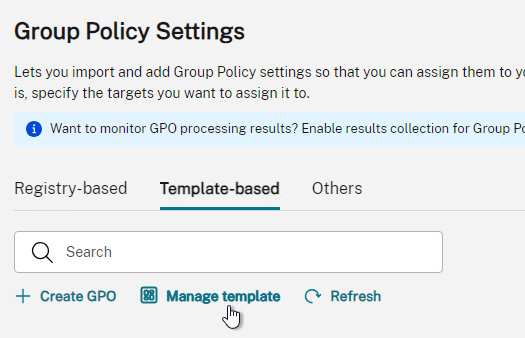
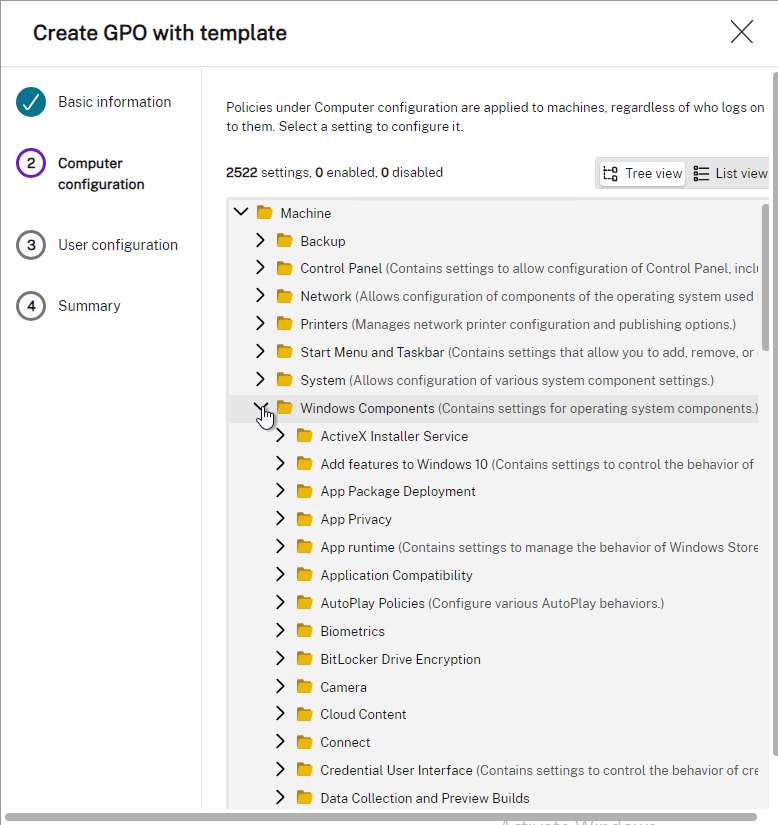
- In WEM Classic Console, some Actions, on the Options tab, have a Self-Healing option. To optimize performance, WEM only applies an action once. The Self-Healing option causes it to reapply at every logon.
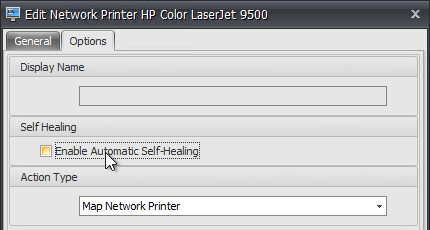
- Network Drives have no field for selecting a drive letter. Instead, you configure the drive letter later when assigning the action as detailed below.

- External Tasks are scripts that are triggered at user logon, reconnect or other triggers. WEM 2203 adds triggers for Process start and Process end. WEM 2009 adds triggers for Disconnect, Lock, and Unlock.
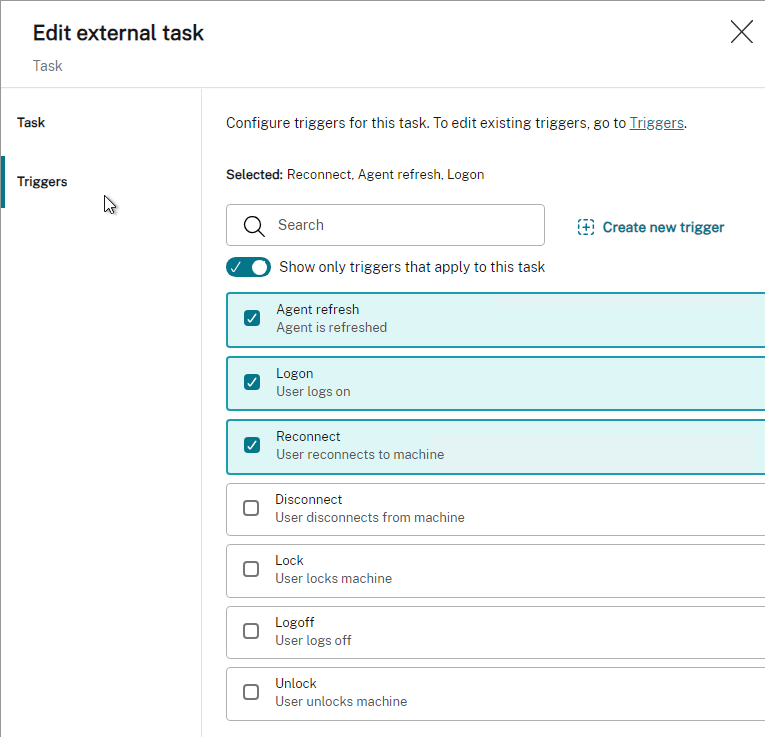
- Applications (shortcuts)
- In the Actions pane, Applications have no option for placing a shortcut on the Desktop. Instead, you configure shortcut placement later when assigning the action as detailed below.
- You can pull icons from a StoreFront store.
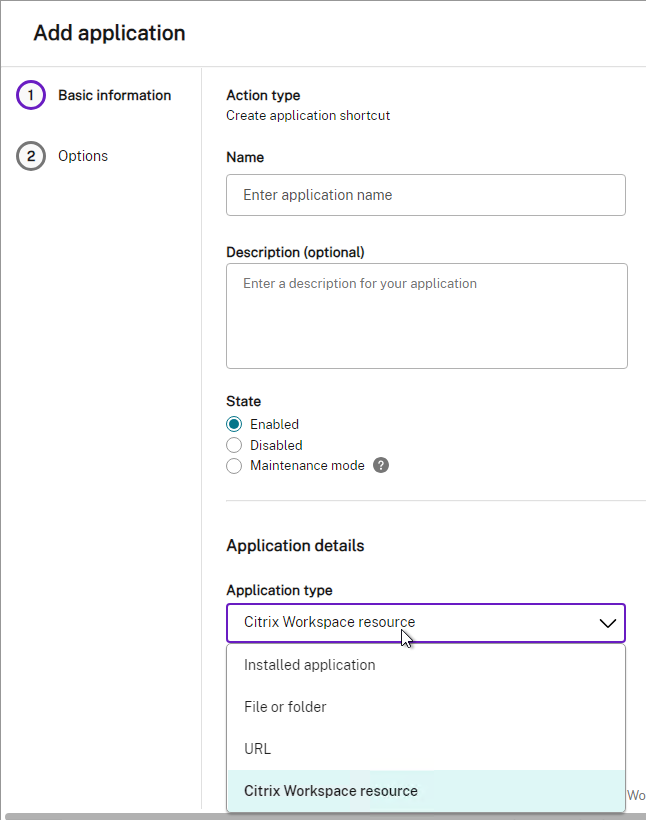
- In Web Console, you’ll need to add the StoreFront URL by clicking the Settings button on the top right, or in Classic Console go to Advanced Settings (workspace) > Configuration (node) > StoreFront (tab).
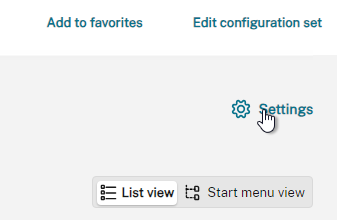
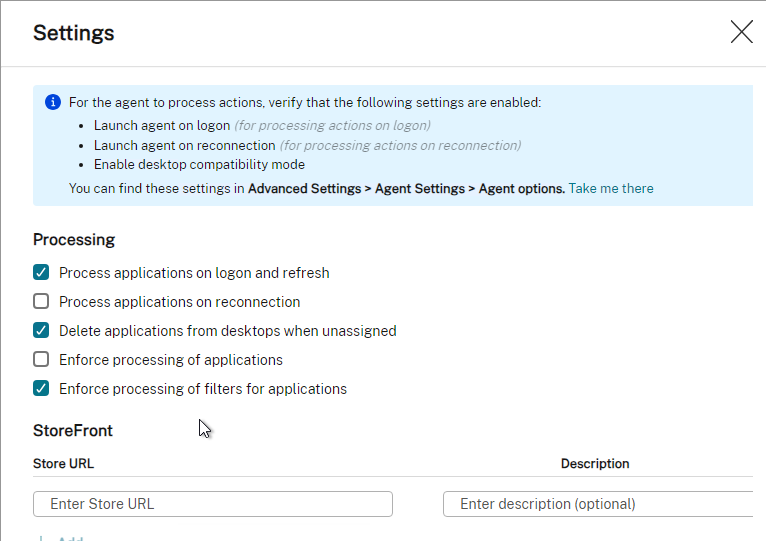
- Get published app resource info by downloading the WEM Tool Hub and using it to copy the resource info. Or Classic Console lets you Browse when creating an Actions > Application and selecting a Store URL.
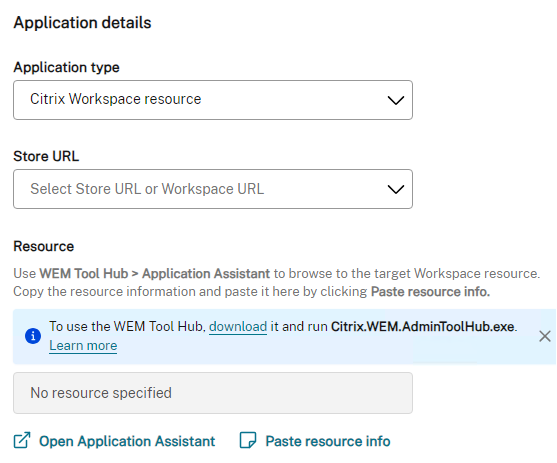
- Links:
- CTX233638 How to configure, deploy, and troubleshoot StoreFront-based assigned application actions in Workspace Environment Management (WEM)
- CTP James Kindon Storefront Resource Integration with WEM 4.6 – explains how to change the icon
- In Web Console, you’ll need to add the StoreFront URL by clicking the Settings button on the top right, or in Classic Console go to Advanced Settings (workspace) > Configuration (node) > StoreFront (tab).
- Arjan Mensch at Powershell Module for Citrix WEM – Part 3 – EnvironmentalSettings and MicrosoftUsvSettings from GPO and much, much more provides a PowerShell Module that can do several things to help setup WEM, including reading a bunch of shortcuts (e.g. from Start Menu), and converting them to an .xml file that can be imported into WEM. This simplifies Applications configuration.

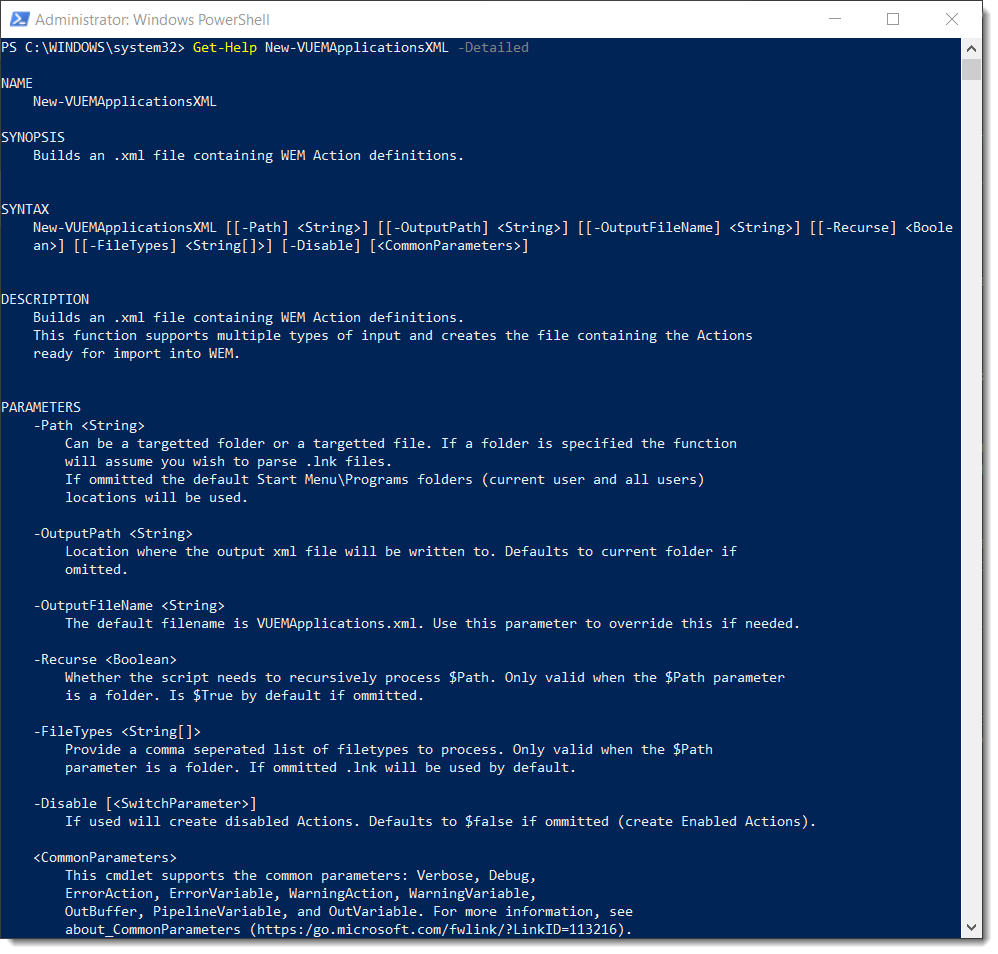
- To prevent applications (shortcuts) from being created if the application isn’t installed, go to Advanced Settings > Agent Settings > Miscellaneous (or Advanced Settings > Configuration > Agent Options), and check the box next to Check Application Existence in the Extra Features section.
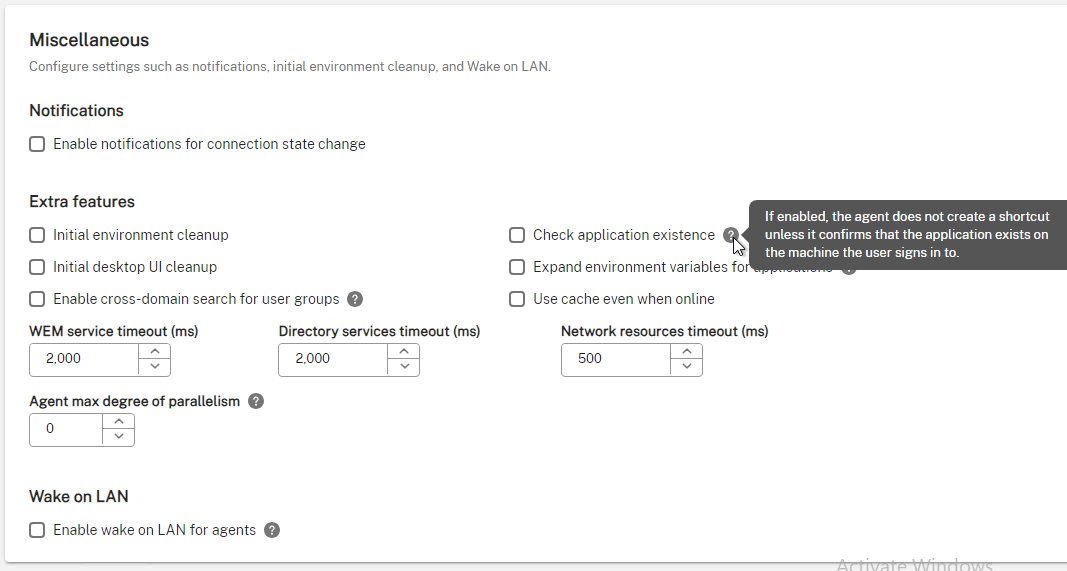
- To clean up extra shortcuts, go to Advanced Settings > Action Settings > Action cleanup (or Advanced Settings > Configuration > Cleanup Actions), and check the boxes in the Shortcuts deletion at startup section. Also see CTP James Kindon Citrix WEM, Modern Start Menus and Tiles.
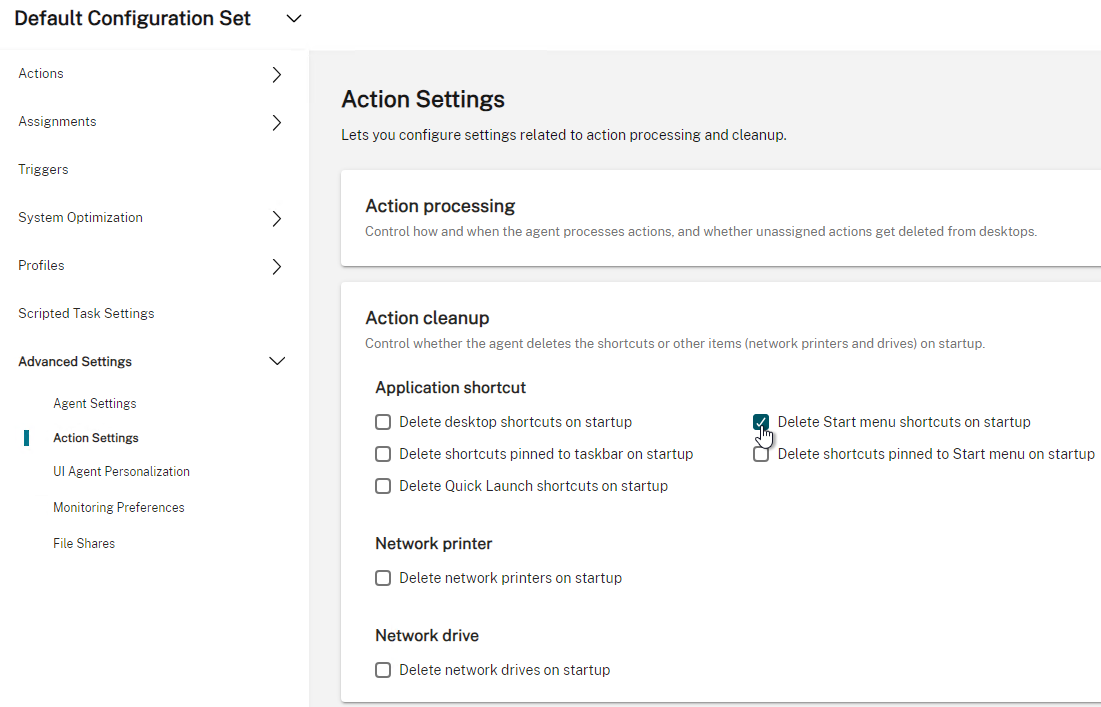
- After you create Applications (Shortcuts), and assign them, on the agent, there’s a Manage Applications tool that lets users control where shortcuts are created, including pinning to Taskbar and Start Menu.
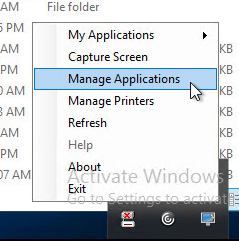
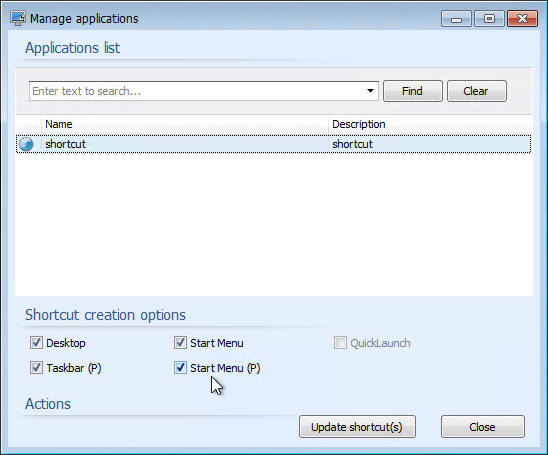
- Applications can be placed in Maintenance Mode. Edit an application, and find the Maintenance Mode setting on the Options tab.
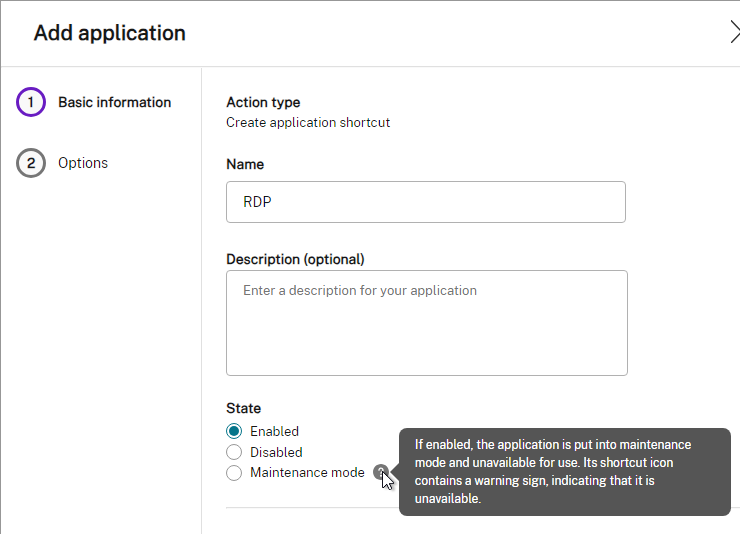
- This causes the icon to change, and a maintenance message to be displayed to the user.


- The Applications node has a Start Menu View tab on the top right.
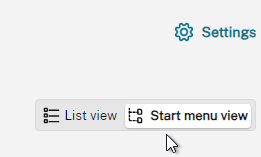
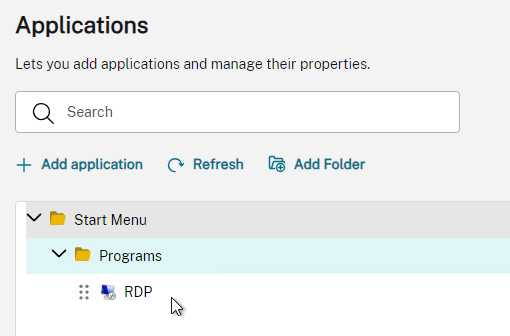
- For the Printers Action, there’s a Add from print server button or in the ribbon there’s a Import Network Print Server button.
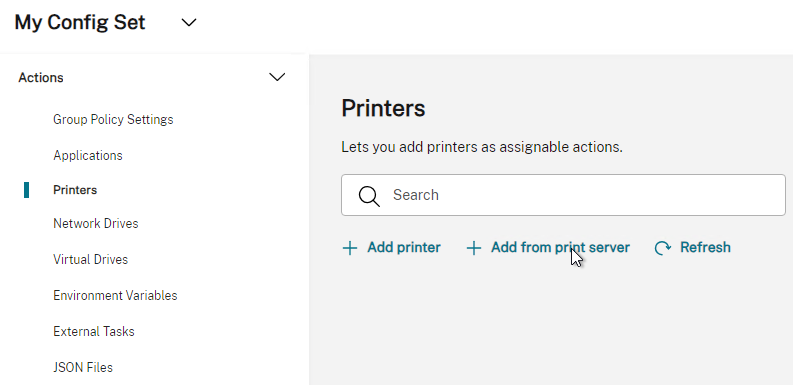
- Web Console uses the WEM Tool Hub to browse the print server.

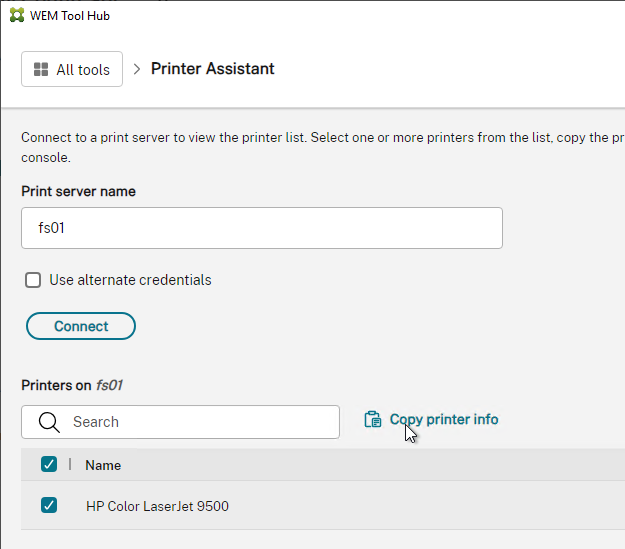
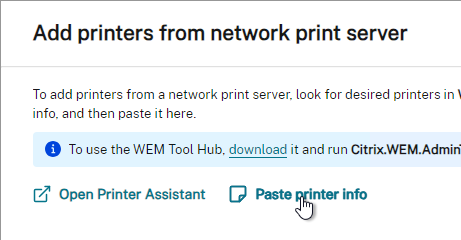
- Web Console uses the WEM Tool Hub to browse the print server.
- JSON Files are Web Console only. This Action lets you configure Microsoft Teams settings and Windows 11 Start Menu.
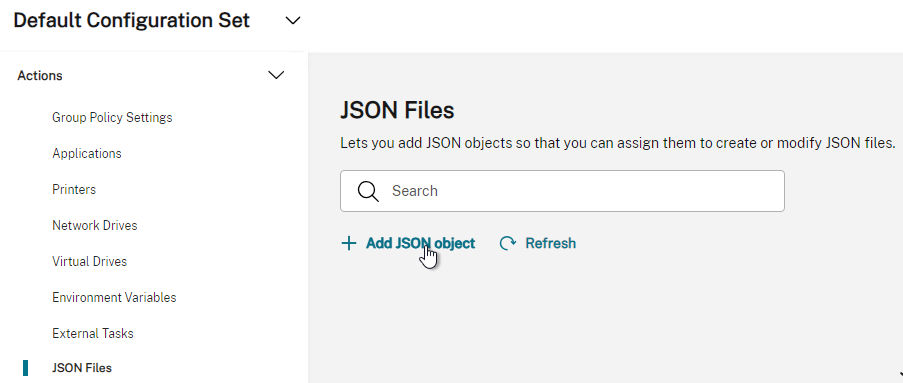
- WEM Tool Hub in WEM 2407 and newer has a Start Menu Configurator for Windows 11.


- For Teams, click Add JSON object and select Standard.

- Click the Generate with template button.
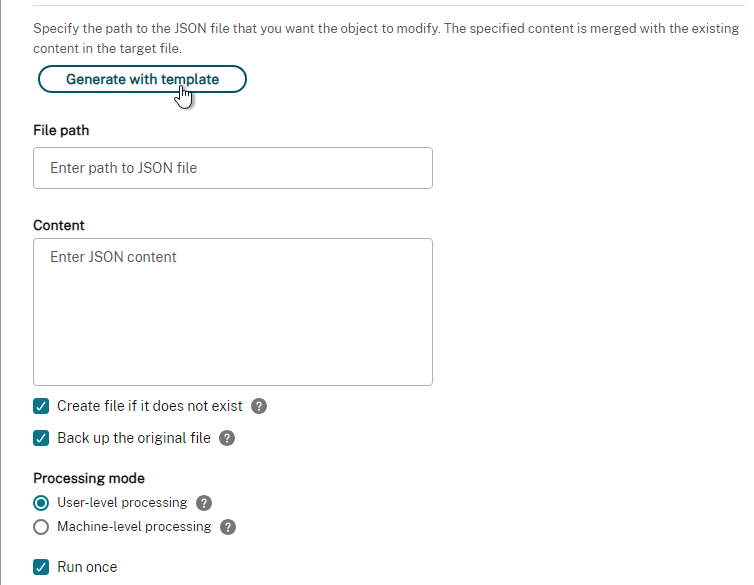
- Choose your desired Microsoft Teams configurations.
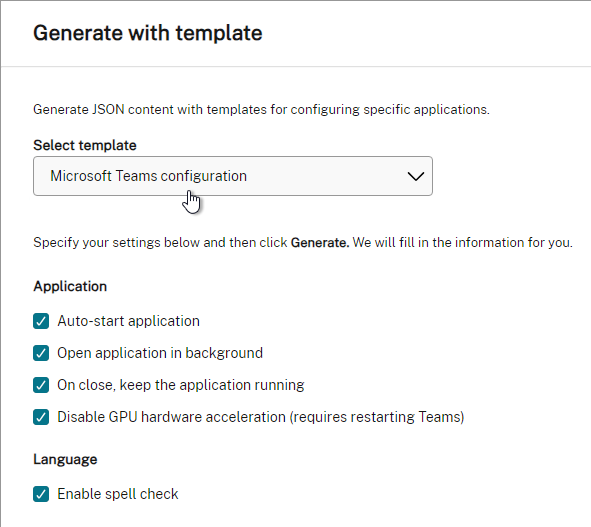
- WEM Tool Hub in WEM 2407 and newer has a Start Menu Configurator for Windows 11.
- WEM 2311 and newer support Registry Entries in the Web Console. There’s an Import button that can import .reg files.

- On the top right is a Settings button.


- If Registry Actions are not applying, delete HKEY_CURRENT_USER\Software\VirtuAll Solutions\VirtuAll User Environment Manager\Agent\. (Source = Registry Entries not applied to users at Citrix Discussions)
- On the top right is a Settings button.
- WEM 2311 and newer have File System Operations in the Web Console. There are several Action types.

- There’s a Settings button on the top right.


- There’s a Settings button on the top right.
- WEM 2311 and newer have File Associations are available in the Web Console. It uses WEM Tool Hub to configure the FTAs.


- WEM 2402 and newer have INI Files, Ports, and User DSNs.

- CTP James Kindon at File Type Association with WEM and SetUserFTA explains how to use WEM to run Christoph Kolbicz’s SetUserFTA utility to reliably set file type associations on Windows 2012 and newer.
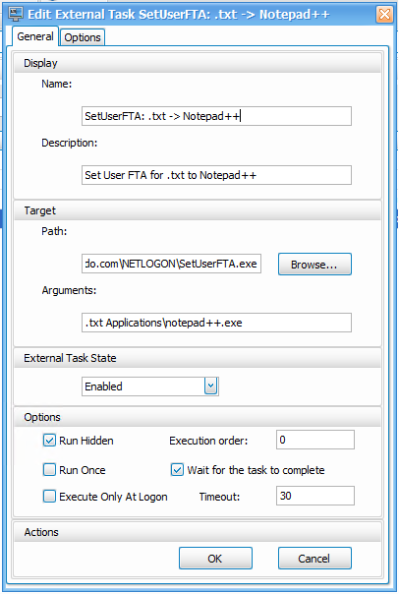
- For variables that can be used in the Actions configurations, see CTP James Kindon WEM Variables, Dynamic Tokens, Hashtags and Strings.
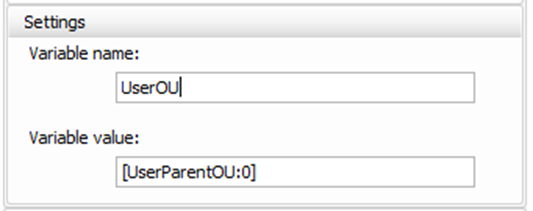
- Action Groups are not yet available in Web Console. You can combine multiple Actions into an Action Group. Then you can later assign the entire Action Group to a user.
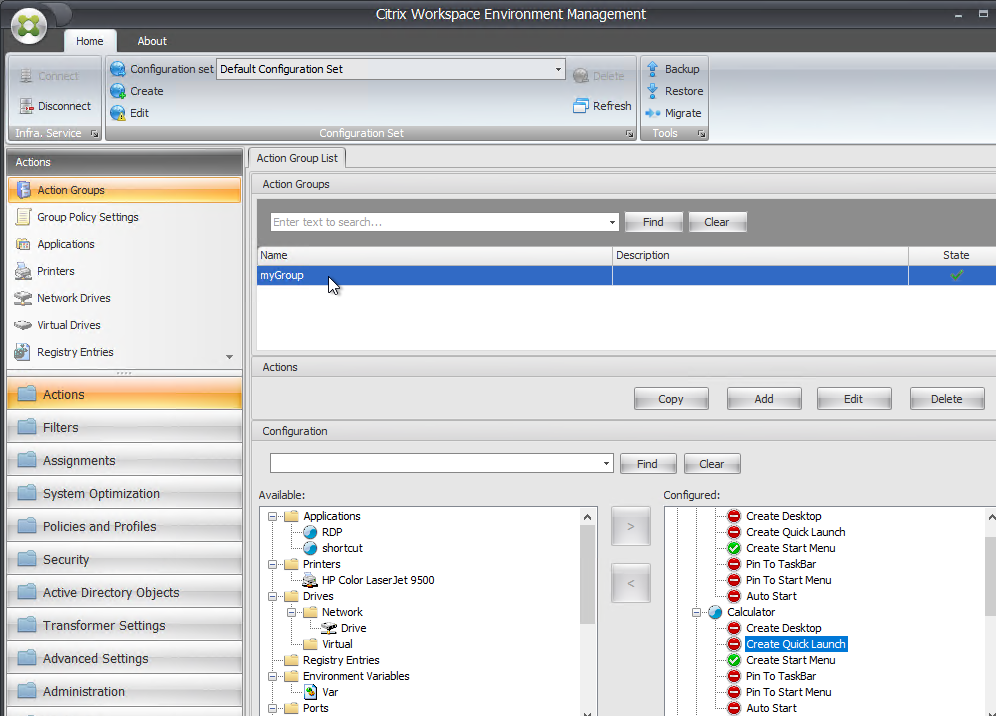
- Create an Action Group and name it.
- Double-click the Action Group to show the actions on the bottom.
- On the bottom, move Actions from the Available box to the Configured box.
- For more info, see Action Groups at Citrix Docs.
Create Conditions and Rules
Once the Actions and Action Groups are created, you then need to decide under what conditions the Actions are performed. One or more Conditions are later combined into a Filter (or Rule). The Filters (or Rules) are used later when assigning an Action to a user group.
- In Web Console, go to Assignments > Filters and click the Manage Conditions button and then click Create condition. Select one of the many condition types.
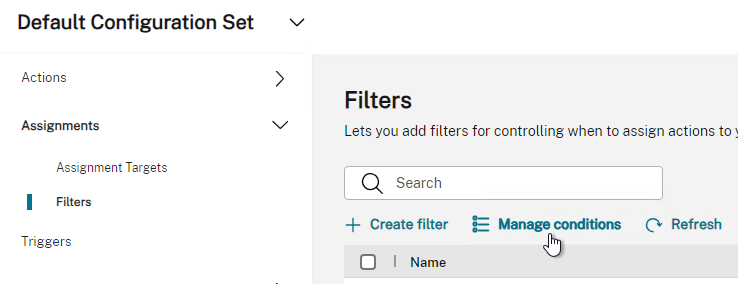
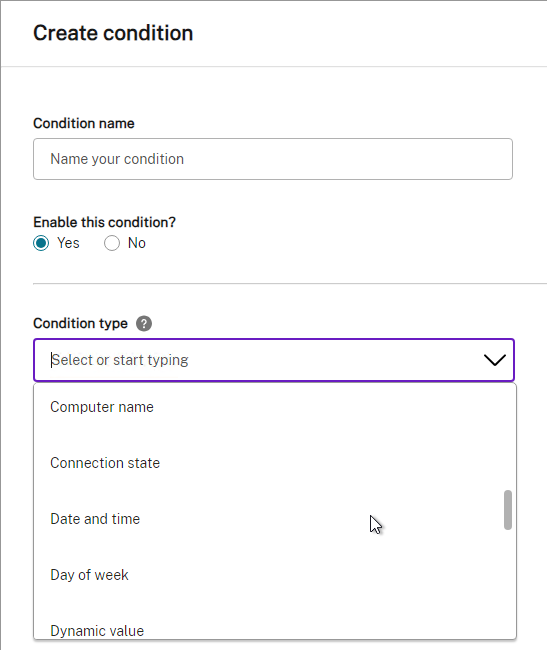
- Or in Classic Console, go to the Filters workspace (bottom left). On the top left, switch to the Conditions node. In the right pane, create Conditions.
- One of the interesting Conditions is User SBC Resource Type, which lets you run Actions for either Published Desktop or Published Application.
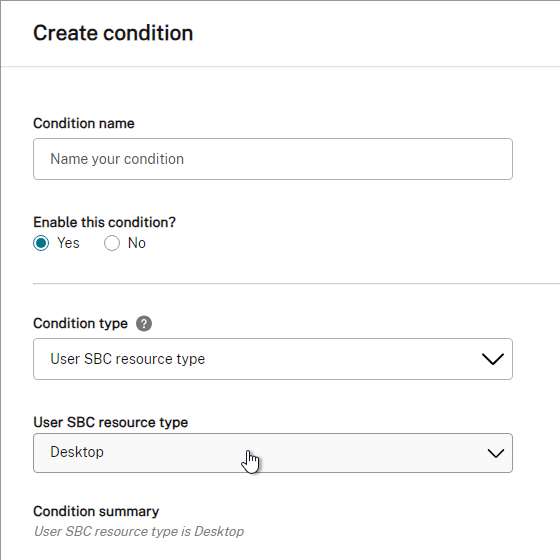
- CTP James Kindon at WEM filter conditions on OU and IP Address at Citrix Discussions says that the Active Directory Path Match condition requires a
*at the end of the path.
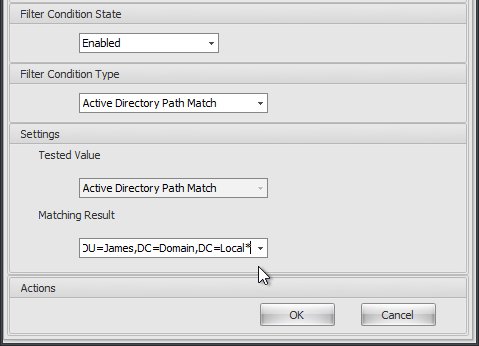
- Then go back to Filters and click Create filter.

- Or in Classic Console, switch to the Rules node (top left) and create Rules in the right pane.
- If you add (by clicking the right arrow) multiple Conditions to a Rule, all (AND) Conditions must match. Web Console lets you click the circle icon to make it an OR operator, but this isn’t an option in the Classic Console.
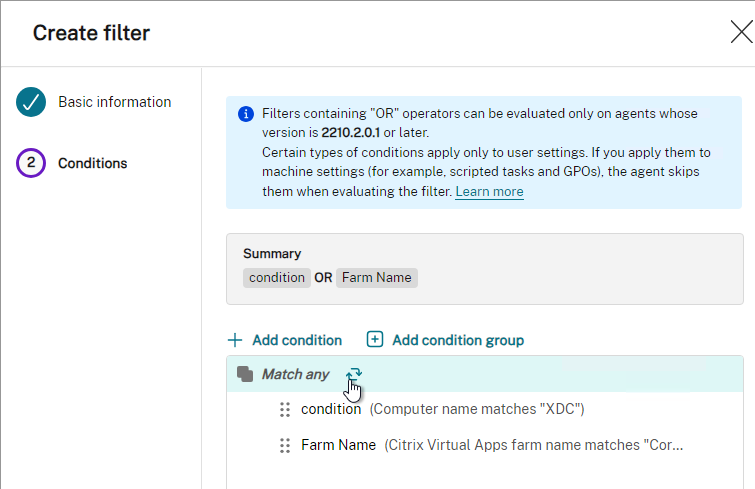
Add AD Groups to WEM Console
- In WEM Web Console, go to Assignments > Assignment Targets and click Add assignment target.
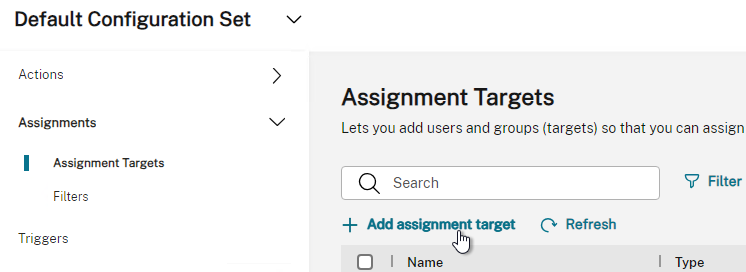
- Or in Classic Console, go to the Active Directory Objects workspace (bottom left). With the Users node selected on the top left, in the right pane, add groups and/or users that will receive the Action assignments.
- Web Console also lets you add new targets when managing assignments for each action.
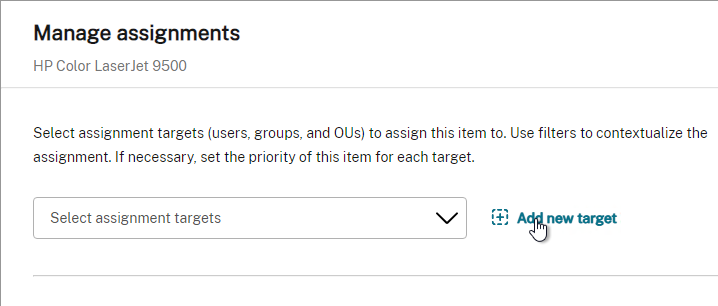
Assign Actions to User Groups
- You can assign multiple actions from one place by clicking an assignment target and then clicking the Manage assignments button.
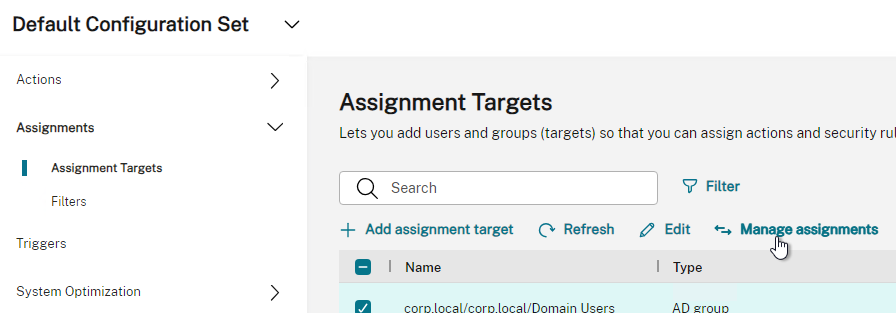
- In Classic Console, go to the Assignments workspace (bottom left) > Action Assignment node (top left). In the right pane, initially the bottom half is empty. Double-click a group to show the Actions that are available for assignment.
- When you assign an action, you can choose a Filter.
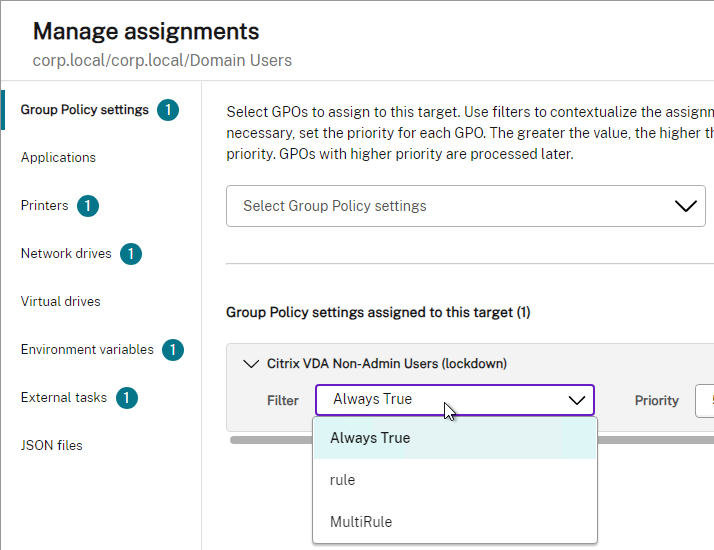
- In Classic Console, move an available Action or Action Group from the left to the right. This assigns the Action (or Action Group) to the user group.
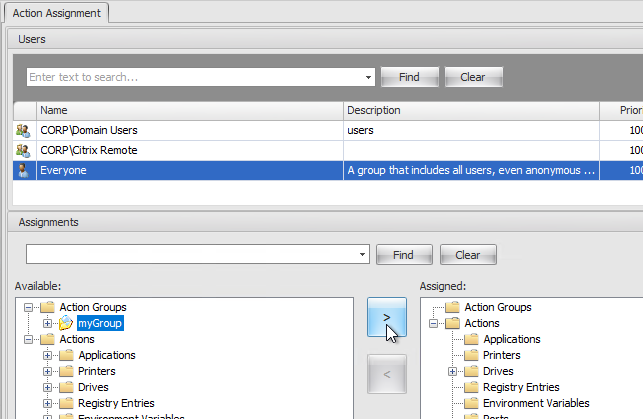
- You will be prompted to select a Filter, which contains one or more Conditions.
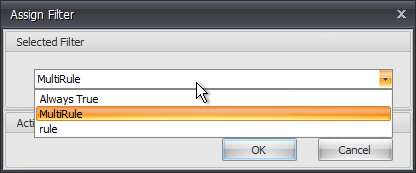
- In Classic Console, move an available Action or Action Group from the left to the right. This assigns the Action (or Action Group) to the user group.
- When you select a Network Drive (or move a Network Drive to the right), you’re prompted to select a drive letter.
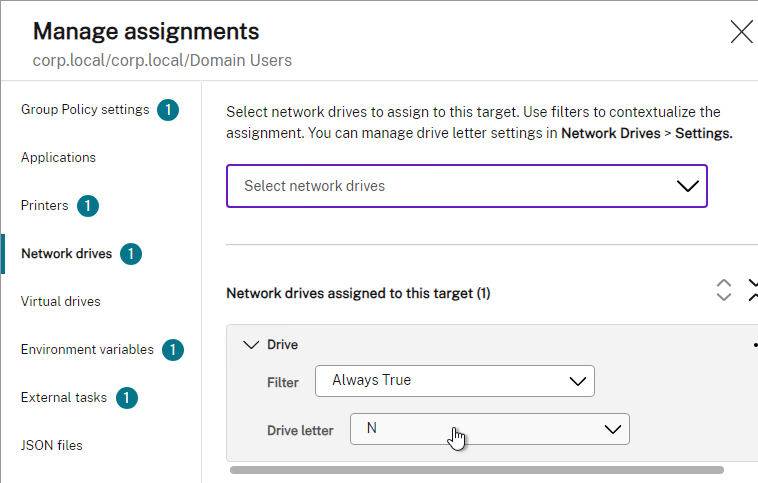
- The list of drive letters is restricted based on the configuration at Advanced Settings workspace (bottom left) > Configuration node (top left) > Console Settings tab (right pane).
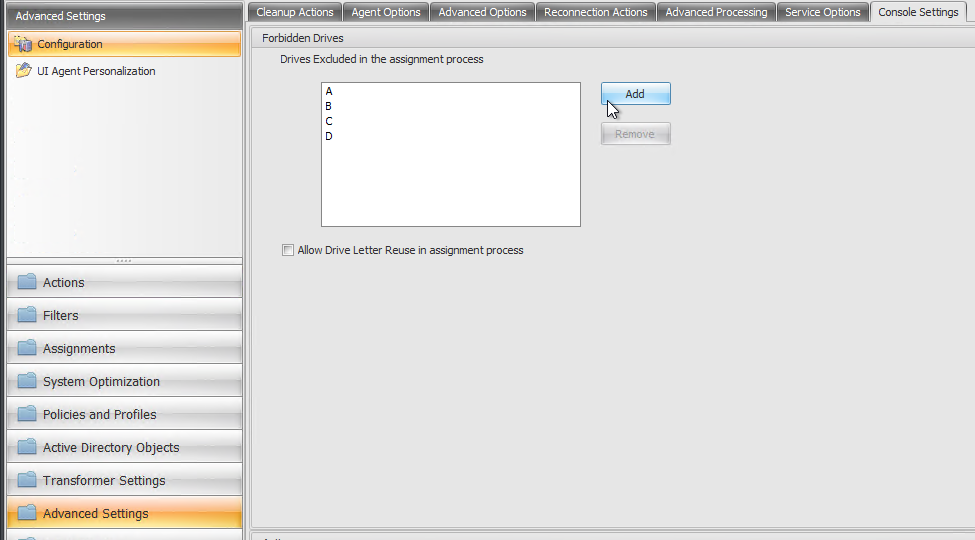
- The list of drive letters is restricted based on the configuration at Advanced Settings workspace (bottom left) > Configuration node (top left) > Console Settings tab (right pane).
- Application assignment lets you choose where to create the icon.
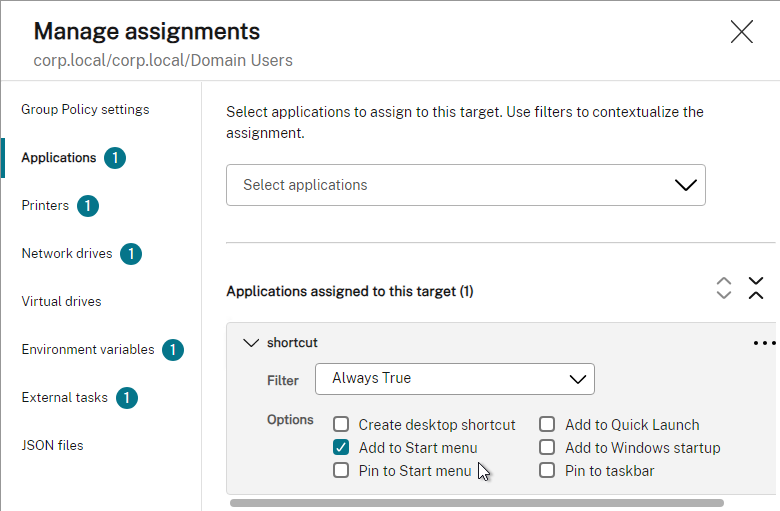
- In Classic Console, some Actions have additional options that you can right-click. For example, you can create shortcuts on the desktop.
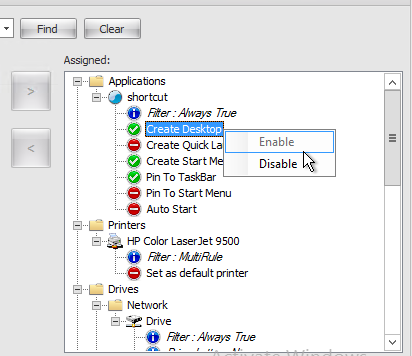
- In Classic Console, some Actions have additional options that you can right-click. For example, you can create shortcuts on the desktop.
- Web Console also lets you Manage assignments directly from each Action.
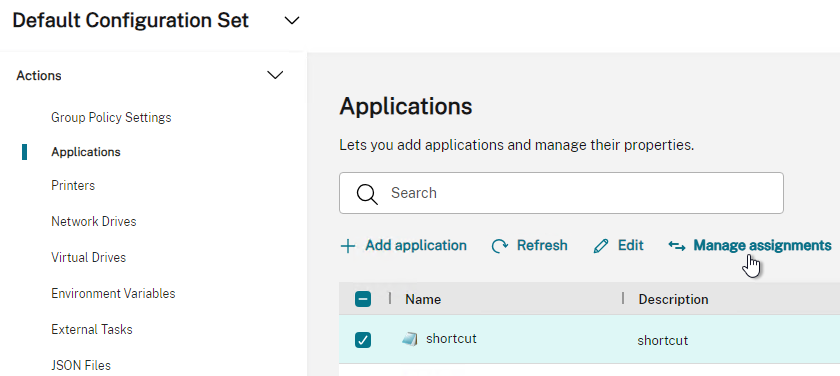
Actions Troubleshooting
WEM caches Actions executions under HKEY_CURRENT_USER\SOFTWARE\VirtuAll Solutions\VirtuAll User Environment Manager\Agent\Tasks Exec Cache. Sometimes clearing these keys and values will fix Actions not applying.
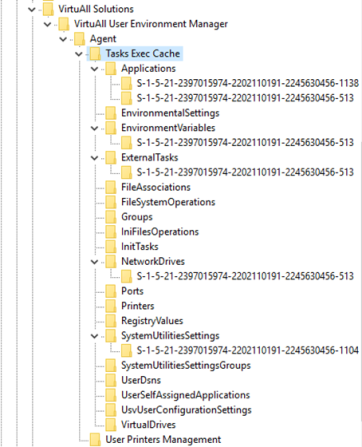
CTP James Kindon at Selective Deletion of the WEM Actions Tracking Cache wrote a PowerShell script to selectively clear these registry keys and values.
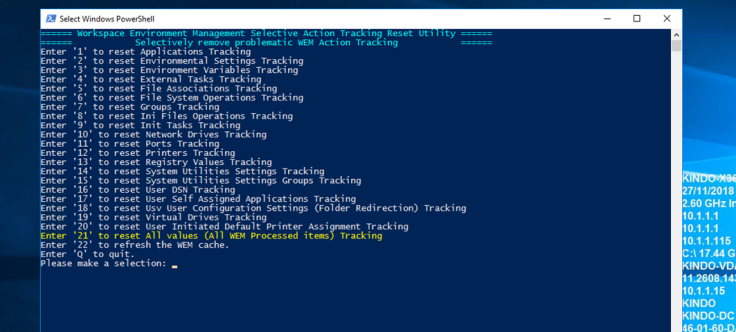
Modeling Wizard
- In the Classic Console, in the Assignments workspace, you can use the Modeling Wizard node (top left) to see what Actions apply to a particular user.
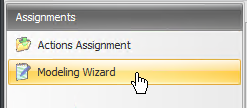
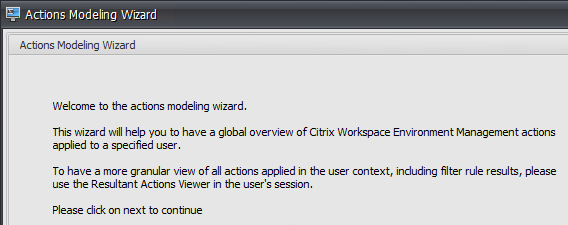
Client Side Tools
CTP James Kindon describes the WEM Client Side Tools including: Log Parser, Resultant Actions Viewer, VUEMAppCMD, Manage Printers, Manage Applications, and Help Desk Tools.
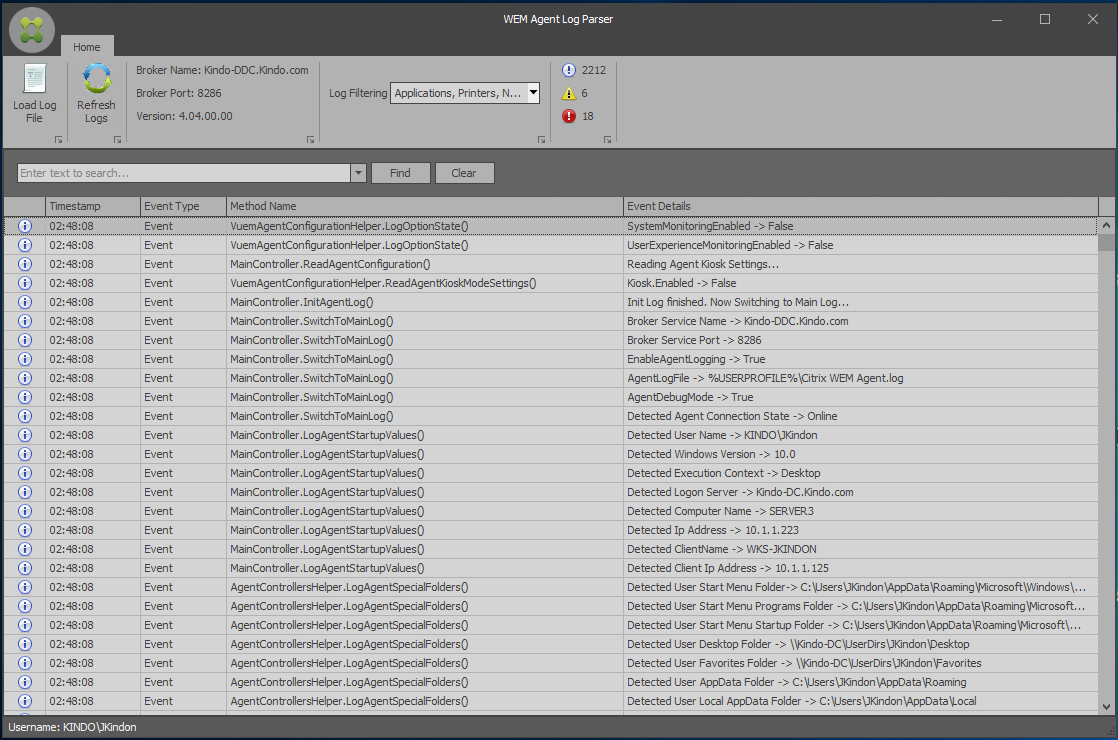
Transformer
You can enable Transformer, which puts the WEM Agent in Kiosk mode. Users can only launch icons (e.g., Citrix icons). Everything else is hidden. This is an alternative to Workspace app Desktop Lock. The Transformer interface is customizable.
WEM 2308 and newer use Edge instead of Internet Explorer. Edge enables StoreFront to detect Workspace app and auto-launch desktops.
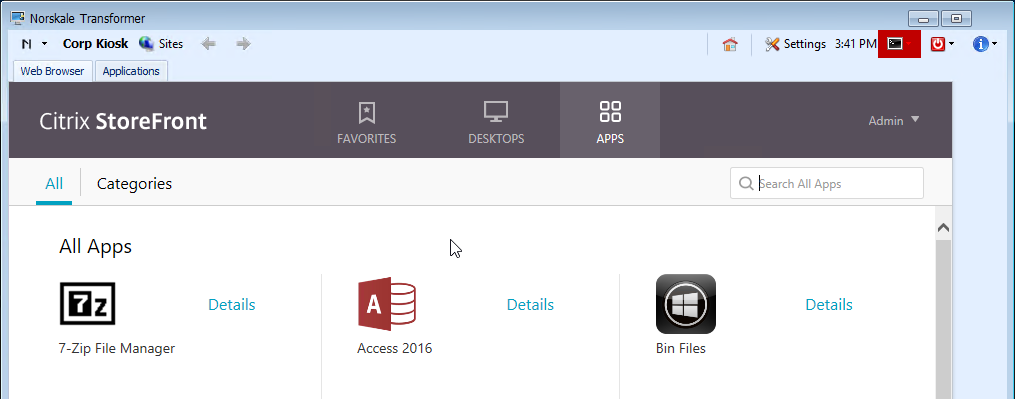
- In the WEM Classic Console, there’s a Transformer Settings workspace (bottom left) with two nodes on the top left: General and Advanced.
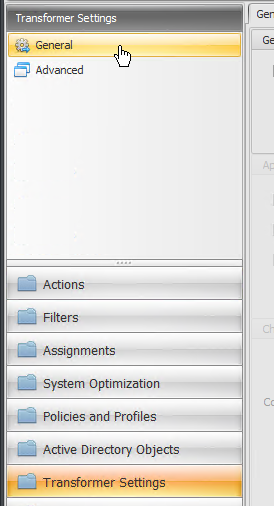
- Enable Transformer, and point it to your StoreFront URL. Note, this applies to all users and all agents in this WEM configuration set. You should probably have a new Configuration Set just for Kiosk devices.

- Other settings on the General Settings tab let you customize the appearance, and specify an unlock password. You probably want to disable the Clock. The Navigation Buttons are browser navigation.
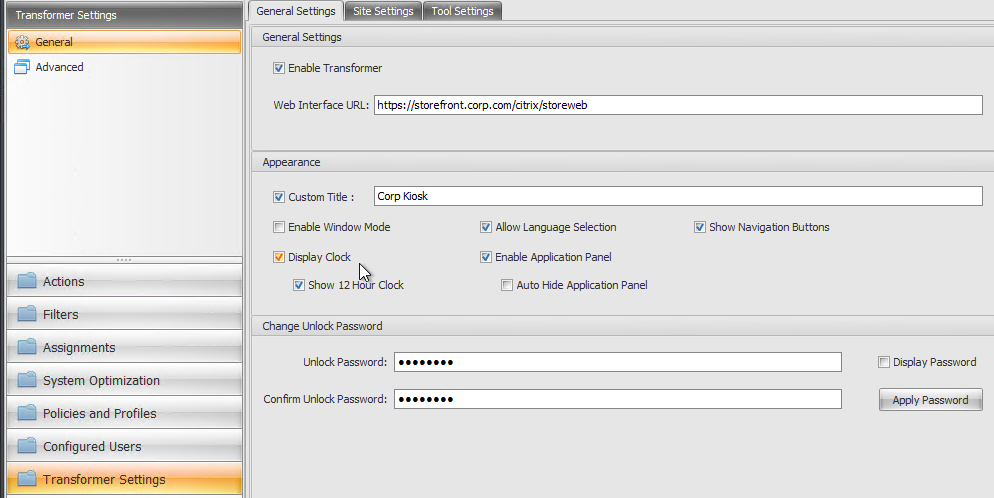
- Transformer can be unlocked by pressing Ctrl+Alt+U and entering the unlock password.
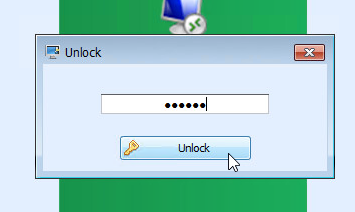
- On the Site Settings tab, you can add website URLs that can be launched from within Transformer.

- At the top of the Transformer window is a Sites icon that lets you go to the sites listed in the WEM Console.

- The Advanced node lets you configure Transformer to launch a process other than a browser.
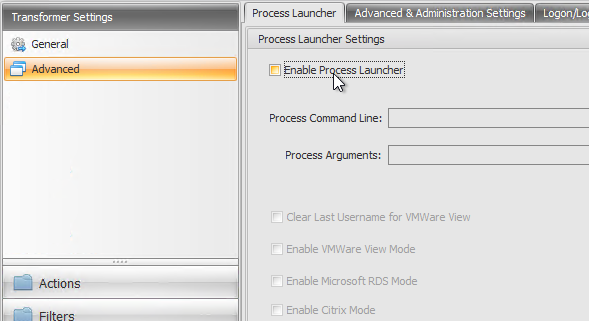
- The Advanced & Administration Settings tab lets you hide features from Transformer.
- To prevent users from accessing the local system, consider checking Hide Taskbar & Start Button.
- You probably want Log Off Screen Redirection to redirect users to the logon page when StoreFront logs off.
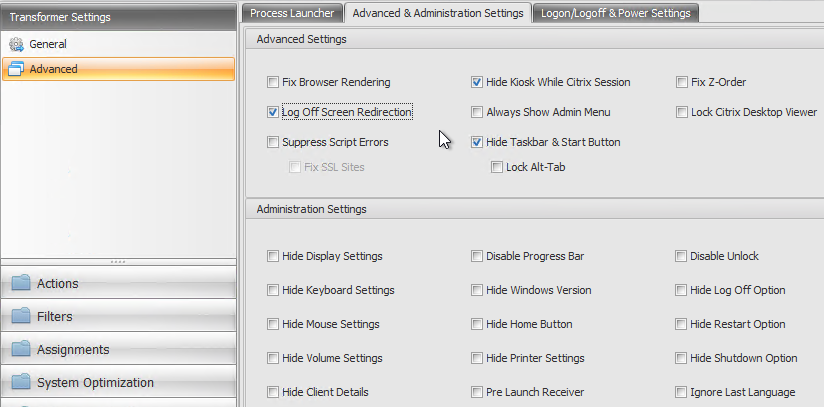
- The Logon/Logoff & Power Settings tab lets you configure the WEM Agent to autologon as a specific account. Transformer then displays the StoreFront webpage where the user enters his or her credentials.
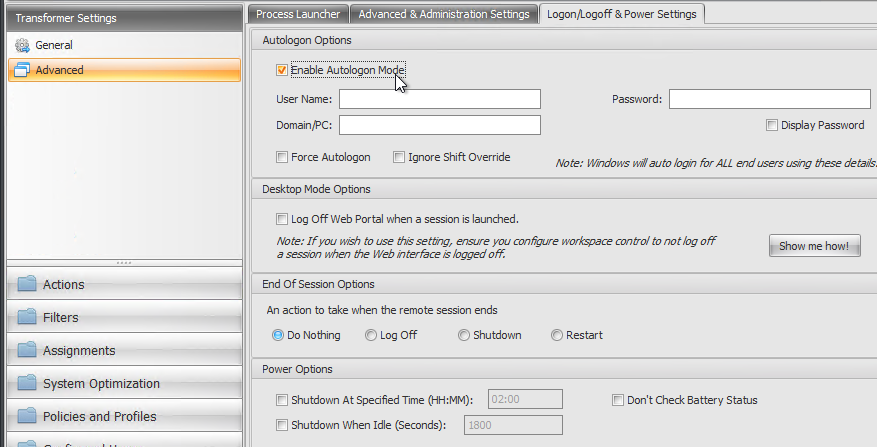
Hi Carl,
Do you know of any issues with using WEM folder redirection. We have applied the folder redirection but want to remove one the folders we originally wanted to redirect. However we cannot get WEM to unapply the folder redirection for this folder, it still does it. Any help would be appreciated. Thanks.
Redirect it back to the local profile.
Worked perfectly, thank you Carl.
I am testing importing our Citrix Server hardening \ session lockdown GPOs into WEM 2009. I cannot figure out how to apply the GPO to Authenticated Users but exclude Admins. With GPOs, we used security filtering and set “Apply group policy” to Deny for Admins.
Hi Carl,
For CPU Management settings: Are there any best practices for Microsoft Teams. Do I need to add the teams process for exclusion or not?
Thanks
Does anyone has a problem with universal groups? Our WEM doesn’t use them. Even in “WEM Resultant Actions Viewer – User Groups Membership” they are not listed.
Hi Carl
We are setting up a new 2006 environment that will be Load Balanced by F5s. I see from Citrix’s documentation that it is best practice in a Load Balanced environment to use a Windows account to run the Norskale Service and connection to the WEM SQL DB. There is also a part about registering the Windows account with the Norskale/Broker Service SPN. Unfortunately another part of the business has beaten me to the punch in a separate domain (same forest) and registered their service account with the Norskale/Broker Service SPN attribute meaning I am unable to register an SPN for my service account. I am unable to share this account as all of our servers are on separate domains.
What would you recommend for me to do in this scenario? Should I scrap the build and start again not using a Windows account and rely on the vuemUser account or continue as I am but without any SPN registration?
I think this is a limitation of the product. You might have to call Citrix Sales or Citrix Support to determine if it’s on the roadmap.
Another option is to use Citrix WEM service hosted in Citrix Cloud.
Citrix’s documentation and yours indicates that with WEM 1912, Citrix would ****change **** the port that the infrastructure server uses for dishing out the cache data.
Per https://docs.citrix.com/en-us/workspace-environment-management/current-release/install-and-configure/agent-host.html
>>>>>>>>>>>> start quote >>>>>>>>>>>>>
Cached data synchronization port. (Applicable to Workspace Environment Management 1912 and later; ***** replaces ***** the port of Workspace Environment Management 1909 and earlier.) The port on which the agent cache synchronization process connects to the infrastructure service to synchronize the agent cache with the infrastructure server. The cached data synchronization port must be the same as the port you configured for the cached data synchronization port (WEM Infrastructure Service Configuration > Network Settings) during the infrastructure services configuration. The port defaults to 8288 and corresponds to the CachedDataSyncPort command-line argument.
<<<<< end quote <<<<<<<<<<<<<<<<
Thus I thought we'd run into a scenario where we had to upgrade WEM backup servers AND the agents for the cache to work correctly.
What Citrix has ACTUALLY done however is to ADD the 8288 port, so that port 8285 is still active and still listening, so that old agents and new agents and new servers can still work together.
Perhaps you can update your documentation and include a screen shot of the network settings tab of the WEM infrastructure service configuration utility to show how there are now 5 ports listening , including cache synchronization port on 8285 and cache data synchronization port on 8288 .
Please note however that NEW agents and old servers wont work as the new agent only attempts to get cache on port 8285.
I added a screenshot. Thanks for the suggestion.
hi carl,
how we can import all GPO settings in WEM admin console
Are you asking about the new GPO Import feature? https://docs.citrix.com/en-us/workspace-environment-management/current-release/user-interface-description/actions/group-policy-settings.html
Hello,
I allow myself to come to you carl in relation to WEM.
I already had this error in 1906 and I still have it in 2006 in my users’ logs, I often have this:
error 0x800705B4
I don’t know where to look
Hey Carl,
We just upgraded our Server 2016 test environment from 1903 to 2006, but it seems the ‘Citrix WEM Agent Host Service’ seems to keep crashing on our VDAs, database and console seem fine.
We also tried a full reinstallation, but the same thing seems to keep happening.
Application: Citrix.Wem.Agent.Service.exe
Framework Version: v4.0.30319
Description: The process was terminated due to an unhandled exception.
Faulting application name: Citrix.Wem.Agent.Service.exe, version: 2005.2.0.1, time stamp: 0x5ecc8b4e
Faulting module name: KERNELBASE.dll, version: 10.0.14393.3659, time stamp: 0x5e9140ed
Exception code: 0xe0434352
I hope you are anybody else seen this before and can give a solution.
We are installing a fresh new 2019 server atm, to give that a test as well.
I appreciate any help, thanks in advance!
Just found the solution myself by running:
lodctr /R and winmgmt /resyncperf
hi,
my citrix wem console is grayed out
also i am getting the warning while connects to the license server still ports 27000 and 7279 are open from wem server to license server
do we need to open 7279 port from citrix license server to wem server?
Are you saying that WEM Console can’t connect to WEM Infrastructure SErver?
hi carl,
we are using citrix platinum licneses but SA is expired
that could be the reason license server is not responding?
wem console can connect to wem infrastructure server,but not able to contact to license server from wem infrastructure service/wem console.once i click ok on the warning to enter license server address.the console is grayed out.
once i enter the license server address it says a valid license server with appropriate licenses need to be configured.
hi,do we need to open port 7279 from citrix license server to WEM server for chec out licenses?
I think the other direction. I’m not sure if the WEM Server checks out the license or if the WEM Agent checks out the license.
When assigning action to a group, up to what level of nested group membership does WEM read to apply an action?
HI Carl, we are planning upgrade our infrastructure from 7.15 LTSR to CVAD 1912, we are using WEM 1906 and planning to upgrade to 1912.which one we have to upgrade first WEM server or WEM agent? if i upgrade WEM server to 1912 first ,is there any impact to the 1906 WEM agents or vice versa ? please confirm
See https://docs.citrix.com/en-us/workspace-environment-management/current-release/upgrade.html. Upgrade the servers first. Note: there’s a new port number 8288 for agent caching.
Are there advantages of putting the wem cache on the c:\ drive? – PVS
Leaving the cache on the C: drive is certainly easier. You might need a script to refresh the cache at each boot.
Hi Carl,
I have an issue when I have finalize the installation of WEM 2003, appropriate licenses are not available.
Which license do we have need ?
Regards,
François
WEM requires CVAD Advanced Edition or Premium Edition.
Hi there,
updatet to 2003 and cannot use Powershell SDK right now 🙁
https://www.powershellgallery.com/packages/Citrix.WEMSDK/1912.0.11
Anybody knows if this is also planned to upgrade?
Hi, Please can you help for finding download link of WEM for lab purpose? THANKS
Hi, upgraded to WEM 2003 from 1903 this weeken, cant pin taskbar icons from admin console after the upgrade.
users can pin programs from agent program. but the preset are not working.
we are running Windows 2016 (1607) servers.
Are there any known issues with this release?
We have an Problem with the WEM Agent.
VDA 1912 LTSR
MCS based
OS 2016 1607
WEM Agent 1912.1.0.1
RDS Licence Server and Mode configured via GPO (per User) and are active on the VDA Machine.
CTX Licence: XenApp Enterprise Cuncurrent SA2020.1229
So what will happen:
Any Remote logon will disapere on the maschine where the WEM Agent is installed.Then comes up the Evend IDs 1128/1069 RDS Licence Grace Period Error.
Sometimes after a fresh reboot of the VDA all works fine.
Have you any idea?
Maybe this? https://kommelsson.wordpress.com/2015/11/24/force-removing-the-rds-licensing-time-bomb/
Thanks for the Link. I´ve seen the regkey before and delete it via GPO. When i open the registry in system context there is no information.
Hello Carl,
i get event id – 40960 which validating RDS server on Citrix VDAs.
The Security System detected an authentication error for the server HOST/xxxxx. The failure code from authentication protocol Kerberos was “The name or SID of the domain specified is inconsistent with the trust information for that domain.
(0xc000019b)”.
The RDS server is hosted in another forest. Trust is validated and said to be working. Server is part of relevant AD group for Terminal License Servers.
However it is still not issuing license.
Anything that you can help me with?
Thanks
Hi Carl,
we have on-prem WEM server and new azure VDA servers are added to our citrix farm , we installed WEM agent in that VDA and configued WEM server through registry and created a new site and added that azure VDA but that server is not showing in agents list and no settings are applied to that server.
Check the WEM Agent logs. https://support.citrix.com/article/CTX220635
Carl,
turned out that after an upgrade from 1906 to 1912 the service account needs DBO permissions otherwise the cache sync will fail. Had the same problem with my environment.
By default the account only get db_database_reader & db_datawriter
Solved thanks to this discussion:
https://discussions.citrix.com/topic/406598-wem-agent-failed-to-get-local-database-parameters-cannot-get-database-instance-id/
Robert is right: After all that we did as part of the 1912 Upgrade — the new PORT in the Infrastructure Services config, the new LBVIP on the Netscaler passing traffic on that Port, and giving the Service Account “Full Control” on the DBSync folder — the final thing, the thing that made it all finally WORK, was also to make that same Service Account “DBO” on the WEM database (in SQL, in our case). Thank you for your post!
Hi Carl,
I’m trying to configure WEM agent, but I think is not working.
On VDA desktop I can click on WEM taskbar icon, and I can see the name of configuration Set configured by editing regedit:
SiteName (Order: 3)hide
Generalhide
Action Update
PropertiesHive HKEY_LOCAL_MACHINE
Key path SYSTEM\CurrentControlSet\Control\Norskale\Agent Host
Value name SiteName
Value type REG_SZ
Value data ConfSet01
But When I’m looking Wem Console, Administration, Agents, Registrations I can see my Machine Name and Description shows me:
Agent is bound to ‘ConfSet03’ (OU=…) configuration Set
On Statitstics I cannot see my Machine Name,
What I’m doing wrong?
Hello Carl,
I have a brand new deployment of WEM 1912 with CVAD 1912 LTSR on Windows Server 2019 and SQL Server 2019. I receive an error when trying to launch the WEM administration console. All Citrix docs requirements and recommendations in your post have been followed. I created relevant Citrix discussions thread on this issue: https://discussions.citrix.com/topic/406672-wem-management-console-launch-error-message/.
Do you have any ideas?
Hi Carl: We are on WEM version 1903. We’ve noticed on the Brokers that the Norskale Broker Service is absolutely pegging CPU and Memory. We have an escalation engineer from Citrix working with us on it, but just wondering if you know of things we can check? Thanks!
Our Infrastructure upgrade to 1912 appears to have solved this issue. WEM Agent processing now happens in a few seconds, and the CPU and Memory on the Brokers remains relatively low throughout the process.
Can anybody confirm if the Infrastructure Services component can be installed on a delivery controller?
@Carl, I know in the article you mentioned it can but I noticed on Citrix Quick Start guide for WEM 1912 it says to not install it on a delivery controller.
I am trying to minimize the amount of servers and WEM looks like it needs so few resources.
same here!
can we install it on a delivery controller ? Carl says yes Citrix no ?!
Excellent article!
Quick question, have you ever seen the WEM agent loading before the GPOs that assign the cloud connectors configuration? I’ve tried with everything including the latest software, and it still happens. Citrix support wants me to delay the application of the GPOs :/
I tried to change the startuptype of the services to automatic (delayed) and that does not work.
If I install the software with the cloud connectors set through the software, it works.
Thanks!
I usually apply computer-level GPOs to my master image to avoid any timing issues when the non-persistent machines boot.
Yeah, that’s the thing. I have the GPOs applied via computer gpo, and it still isn’t fast enough… the WEM agent loads before the GPOs are applied.
Carl, Can I run WEM 1808 or 1909 in XA 7.15? I see ambiguous requirements in the release notes about the naming conventions being interchangeable (CVAD or XA/XD) so I’m not sure what they mean by “any supported version of…” are the terms interchangeable, or is 4.7 the latest version that I can install?
XA/XD was renamed to CVAD. Version 7.15 still has the XA/XD name. The latest WEM version should work fine on XA/XD 7.15.
Test user logs in and eventviewer logs following error: “Error while Configuring Registry Security.” No exeptions or warnings in citrix wem agent log. Removed all assgned settings but still the same error. New userprofile same result. Is this a fals positive ? When i assign a regsitry key, it works.
Hello Carl,
Version 1909 constantly generate this error.” Error while Configuring Registry Security “for the user that logs in. In the citrix wem agent log there is no fault/exceptions.. For test i removed all the registry assigend to domain users and then the error is gone. The registry directly assigned to the test account does not generate an error. Is it a false positive?
Hello, I have a question according the actions in WEM and I’m not able to find the information at the moment.
I would like to ask in which order actions are applied during logon. For example first applications, second external tasks, etc. Is there any documentation about that?
Thank you very much.
Regards Michael
Hi Carl,
We have Citrix WEM as a cloud service for profile management and all the printers are mapped via WEM – Actions – Printers. But when the user login to the Citrix it is prompting message to “Trust the printer” and asking for admin credentials to install the printer and it gets installed if we supply admin credentials and gets disappeared after logoff. This issue is with out new Citrix cloud environment running VDAs in server 2016.
We are currently in the process of migrating users from XA6.5 to Citrix cloud and all the printers were working in the XA6.5 environment. Not sure what we are missing in terms of printer mapping. This issue is with US region and we have similar setup for UK region where all the printers get mapped via WEM policies without issues.
Your help is much appreciated!
Thanks
What kind of VDA? Multi-user RDSH? If so, is the print driver already installed on the VDA machine?
Yes it is multi user RDSH and we didn’t install the printer driver on the VDA machine. As I explained above, we have similar setup for UK region where we didn’t install any printer drivers to the VDA machine, but it still maps the printer to the user session.
Do we need to install the printer driver to each and every server VDAs?
I think RDSH needs administrator permission to install drivers. Virtual Desktops don’t have that requirement.
Hi carl
I have tested installing the printers directly to the Server VDA and it is not prompting the admin credentials to install the printer on the user session and works fine. I couldn’t understand how it works in this way. It means I have to install all the printers on all server VDAs manually. Please could you confirm that whether it is right approach and what I am doing is correct.?
Thanks
RAV
Hi Carl, we configured Application active setup through External Tasks but it is not working at user first logon but next time on wards it’s working fine. How to fix this ?
Hi carl, we already created a new SQL db for WEM and i have to configure that db in WEM server , so which one(Create or upgrade ) i have to run in WEM Database Management Utility. ??
Hi,
after updating from stable 4.7 to 1906 a new nightmare is starting. The Management Server are stopping ever 24 hours. Means the norskale service is running but not answering.There are messages like this in the event id.
——————————–
Faulting application name: Norskale Broker Service.exe, version: 4.7.0.0, time stamp: 0x5b3b2f06
Faulting module name: adsldpc.dll, version: 6.3.9600.17415, time stamp: 0x545053e3
Exception code: 0xc0000005
Fault offset: 0x000000000001e554
Faulting process id: 0x1380
Faulting application start time: 0x01d4d35b74778845
Faulting application path: C:\Program Files (x86)\Norskale\Norskale Infrastructure Services\Norskale Broker Service.exe
Faulting module path: C:\Windows\system32\adsldpc.dll
Report Id: d350f54c-4299-11e9-80fe-005056ad16f6
Faulting package full name:
Faulting package-relative application ID:
—————————
The Windows Server (W2K12R2) is fully patched but this doesn`t help :-(. The only thing is to restart the server. Restarting the Norskale Service did not help
The WEM Client stopped to work, but the service is running. Try to restart with error “Failed to stop service. System.AggregateException: One or more errors occurred. —> Norskale.Common.Data.PortAlreadyInUseException: The requested port 49752 is busy”, but firewall port is definitly open. After downgrade to WEM Client 4.7 everything is good
Any ideas ? The CITRIX Support is doing ….. nothing 🙁
Regards Claus-Michael
Hi Carl we have Ivanti Environment Manager with none persistent VDI. The fast log off is not set under Log off tab. But when users log off the log off is fast. Are you aware of any Citrix settings where I can look at to stop this fast log off?
Can WEM be updated directly from v4.6 to 1906 or are there intermediate update levels that need to be applied first?
e.g.
A) version 4.6 upgraded to version 1906
or
B) something like version 4.6 upgraded to version 1811 then upgraded to version 1906
From Citrix Docs: “In-place upgrades from any of Workspace Environment Management 4.x to the latest released (current) version are supported.” https://docs.citrix.com/en-us/workspace-environment-management/current-release/upgrade.html
Thank you Carl for the above article , i would like to know if there any way that we can export the application name and associated Active directory groups from WEM
CTP James Kindon and Arjan Mensch do quite a bit with WEM automation.
Hi Carl,
Just FYI that the latest version of WEM (v1903 as of this post) includes GPO template files that have a typo; Workspace is spelled Worskpace.
If others like me just copy the contents of the ADMX folder and replace them into the GPO store, you’ll get a prompt to replace files, but really it will create 2 ADMX\ADML files instead.
Just FYI in case anyone else runs into this.
Best,
Moiz Veravalwala
Hi Carl,
We are using the Citrix cloud service and installed/configured the WEM agent 1903 and pointed to cloud connectors. However, I can’t see the agents are getting registered in the WEM console. Any idea what is blocking?
Our server VDAs and Cloud connectors are hosted in AWS and configured necessary security groups to allow WEM ports.
Thanks.
Is this the instructions you used? https://docs.citrix.com/en-us/workspace-environment-management/service/install-and-configure.html#install-and-configure-the-workspace-environment-management-agent
Yes I followed the same. However, I didn’t set any additional arguments as they explained at the end of the article. I just ran the typical installation of the agent and configured the GPO as per this article.
Hi Carl, Thanks for your advise. The issue has been resolved now. It seems the version WEM 1903 agent is not supported in the WEM as a service. I have reinstalled with the WEM agent 1811.1 and now it is appearing in the WEM console.
Thanks
Just adding to this incase someone is interested… I attempted to use WEM 1903 connected to our Cloud connectors to Cloud WEM. The new agent did not understand the use of cloud connectors instead of the Web broker. I went back to 1811 also.. My motive was to get around consistent problem with WEM applying my UPM settings. It will work at first, then some weeks later users lose their Citrix Profile. All other WEM settings are applied but I’ve finally resorted to Group Policy just for UPM configuration. To clarify this is cloud WEM …
Carl,
Thanks for the great work !!
I’m upgrading a customer environment to 1903 versions. The use UPM from WEM and like to use the Profile container option from UPM 1903. Where can I configure that in WEM 1903 ?
Thanks,
Mario
I don’t think Citrix was able to add that feature to WEM 1903.
Then we have to wait untill it’s added to WEM also.
Thanks,
Just a note – in the Citrix upgrade docs for 1811, they specify that if you use SQL AlwaysOn HA, you must remove the WEM database from it before perfomring an upgrade:
“SQL Server Always On availability groups. If your Workspace Environment Management database is deployed in an SQL Server Always On availability group, before upgrading the database you must remove it from the availability group.”
Thanks. I just added that note to this article.
Hi Carl,
Which version of WEM is compatible with Citrix 7.15 CU3 and Windows 10.
Is this the same setup for Citrix Cloud wem version? I am wanting to set WEM up in Citrix Cloud and point the DB over to Azure. I scanned over the post but didn’t see anything that suggests setup from Citrix Cloud to Azure.
For the Citrix Cloud version of WEM, Citrix handles the servers and the database. You just install the WEM Agent and point in to the Cloud Connector.
Or are you asking about building your own WEM Servers in Azure without Citrix Cloud?
No, if Citrix cloud supplies it already then no need to move it over to Azure. Thanks for the info. Love the site. Keep up the great work.
Hey Carl, something basic but I think it is worth to mention, if you set a custom password for your vuemUser SQL account during installation you have to specify it in the Advanced Settings when you are first connecting your Management Console to the Infrastructure Broker. Otherwise, you will get errors like:
“Login failed for user ‘vuemUser’. Reason: Password did not match that for the login provided”
Hello Carl,
I have to Provide some URLs to our VDIs – is there a way tor provide this links with WEM.
We are using WEM 4.7
Thank you
Without WEM, you can Publish Content from XenApp. Otherwise, you should be able to use WEM or Group Policy Preferences to create a Shortcut (aka application) that points to a URL.
Hello Carl,
thanks for your blog. I am not shure wether to use one or two assignments with lots of filters or lots of assignments with less filter conditions. What would be a best practice soultion?
Thanks in advance!
Sebastian
I like to keep assignments generalised to groups, and then use filters and conditions when there is an exemption to that general requirement or you need to only apply something when another condition is true. Less filters, the less complex the processing.
Hey Carl,
Not to sure if you have ran across this yet, but for step 24 I would amend that if you move your Computer AD objects to a different OU, then you will need to apply that fix. Had a ticket open with Citrix and that fixed the issue with WEM not applying.
Justin
Is there a way to create a shortcut to the WEM agent refresh? I’d like to put a refresh shortcut on the users desktop but can’t seem to find a switch. Anyone?
there isn’t one 🙁
Carl, Have you guys noticed by chance WEM will not allow Pinned Items to re-appear in the Start menu? I have the “Delete Taskbar Pinned Shortcuts not checked either.
Has anyone seen an oddity using environment variables? I have a script that runs as an external task. It needs to use the clientname variable which isn’t present when WEM runs – no drama, we set a new variable in WEM to point to ##clientname##
This works fine the first time a user logs on. The clientname is set as expected.
What isn’t expected – and I may be missing a trick here – is that on subsequent logons, the environment variable isn’t updated. It remains stuck at whatever was set the very first time a user logged on.
And it gets weirder – if you delete the key in the user registry hive, log off and back on, the value key (or just value – it doesn’t matter which you remove) never returns.
I notice in the WEM logs, the following, which (again I may be misreading) suggest to me that WEM thinks the value is static/cached:
08:54:38 Event -> VuemEnvironmentVariableExecutor.CheckExecCacheState() : Environment Variable -> TCName (Id:7) -> Action already processed -> returning true
08:54:38 Event -> VuemEnvironmentVariableExecutor.CheckExecCacheState() : Environment Variable -> TCName (Id:7) -> Action already processed -> returning true
08:54:38 Event -> VuemEnvironmentVariableController.ProcessActionRelatedRefresh() : Environment Variable Processing: No Refresh required -> Exiting
Any ideas? I am sure I am missing a trick here.
Have you tried “Enforce environment variables processing” at Advanced Settings > Advanced Options?
Sorry for the delay replying. I’d put a workaround into the script but that check box does the trick, albeit only at logon.
Thanks for the pointer.
It’s Works! thanks!!